|
Death Valley
Historic Resource Study A History of Mining |

|
SECTION IV:
INVENTORY OF HISTORIC RESOURCES--THE EAST SIDE
C. The Black Mountains
1. Introduction
As the reader is by now undoubtedly aware, the history of the entire east side of Death Valley was dominated by the great Bullfrog boom. This influence, which we have already seen in the Bullfrog Hills and the Funeral Range, was no less evident in the Black Mountains, to the south of the Funeral Range. Like the above territories, the history of mining in the Black Mountains is dominated by the story of various and sundry booms and busts, all subsidiary to the Bullfrog boom to the north. At a glance, therefore, the history of the mines and mining camps in this section is not too different than those related above. But there were two distinct phenomena which showed up in this section. Although neither of these are particularly surprising on their own rights, they both emphasize telling points concerning the success or failure of desert mining camps.
The first was the amazing stampede into Greenwater. That spectacular rush will be described in more detail later, so it suffices to point out here that in Greenwater we see the final culmination of the unbelievable boom spirit which had been prevailing in the desert mining camps since the discovery of Tonopah in 1900. Since that discovery, scores of boom towns had been added to the map in southern Nevada and southeastern California, and each seemed to proclaim to the world that the new era of mining booms was here to stay. Untold riches were buried beneath the desert floor, and all one had to do was dig almost anywhere to secure a fortune. That spirit reached its height in conjunction with the Greenwater stampede--and the subsequent Greenwater bust marked the beginning of the decline of the early twentieth-century mining booms.
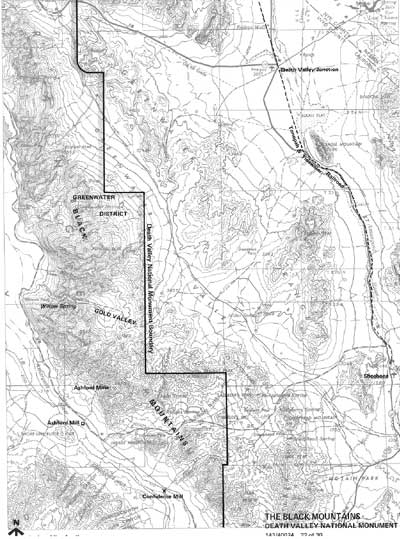
|
| Illustration 189. Map of the Black Mountains. |
On a less psychological note, the mining camps of the Black Mountains also pointed out quite clearly the ever-present handicaps against which desert mining camps were forced to struggle--the search for water, fuel and transportation. At the time of the mining booms in the Black Mountains, Rhyolite was far and away the largest supply center in the entire Death Valley region, and the farther south one moved from Rhyolite, the more expensive food, fuel and supplies became. Thus the farther one moved from Rhyolite, the more expensive it was to open a mine, and the richer one's ore had to be in order to reap a profit. In addition, the fact that water sources grew fewer and farther between as one moved south multiplied the problems of expenses and even survival. Mines, in short, which would have become producers in the Bullfrog Hills were totally unprofitable in the Black Mountains. These dual problems of water and transportation are the constant factors in the determination of the success or failure of mines in this section.
On an entirely different note, it seems fitting to give the reader a word of warning at this point. This study has been based heavily upon the accounts of mines as printed in contemporary mining camp newspapers and national mining journals, neither of which sources are completely reliable, Mining camp newspapers were always wont to emphasize the positive and ignore the negative in their reporting, for the success of the paper depended upon the success of the camp. Thus, as we have seen time after time, mines which are reported to be healthy, productive and rich in one issue of a paper are suddenly closed by the time the next issue hit the street, without a word of explanation from the friendly editor. National mining journals, while more prestigious, are hardly more reliable in their weekly coverage, since the great majority of their news came from the editors of local papers, who served as stringers for the national syndicates.
But the editors and papers should not totally shoulder the blame, for they in turn relied upon the mine owners and superintendents for their information. With this in mind, the following article, which appeared in the Inyo Independent in 1882, should be enough to emphasize the dangers of relying upon such biased sources for information concerning a mine:
Recently, says an exchange, a Nevada man invented a lying machine, and went around trying to sell 'em. The machine was warranted to trot out a first-class lie on any subject, at a moment's notice. But it didn't sell well. He took it to an editor. Said the editor: "Come, you get out of this. I tell the truth in my business." The inventor presented it to a lawyer, but he also looked horror-stricken and offended. A fishing party looked hankeringly at it, but their language was to the effect that they abhorred untruth. At last the disheartened inventor tried a mining superintendent, who flew mad in a minute. "You scoundrel," he cried, "do you mean to insult me?" "No," tremblingly answered the man. "Then what in blazes do you mean by offering me that thing?" "Why I--I thought you might occasionally want to use it in your business." "You wretch, what do you take me for?" "Oh, sir, I didn't mean to insinuate that you could tell a lie." "That's it " cried the superintendent; "that's what I'm mad about. You conceited ass, you think you're able to invent a machine that I can't lie all around, and that without an effort. I never was so insulted in all my life! Get!" And he immediately set to work writing his weekly reports.
Since this type of reporting was more evident in Greenwater than in any other boom camp in Death Valley, a word to the wise should be sufficient.
2. The Greenwater District
a. History
Greenwater Valley was the site of the most spectacular boom in the history of Death Valley mining. While other districts, such as Bullfrog, Lee-Echo, Panamint, Skidoo and Leadfield had their booms, which saw rushes into new mining areas and the establishment of new mining camps and towns, Greenwater surpassed all the others in the brilliance of its birth. Within a year and a half from the beginning of the rush to Greenwater, the deserted desert was home to over two thousand inhabitants in four towns, seventy-three incorporated mining companies, and was the focal point of over 140 million dollars worth of capitalization.
But it was not only the amazing rush to Greenwater which sets it apart from other booms, for Greenwater also experienced the shortest life ever recorded for a boom camp of its size. Within one year from the height of the boom, all but five of the companies had left the district, and Greenwater was practically deserted. By the end of two more years, everyone had given up, and the Greenwater Valley, the scene of so much bustle and excitement a short time before, was once again completely deserted. This combination of a tremendous boom, a brief life and then complete desertion, all within the space of less than four years, has made Greenwater a name which is still anathema to the investing public, and dear to the hearts of desert folklorists. Few, if any, mining camps in the American west have ever combined such initial excitement with such total disappointment.
Inevitably, considering the popular place of Greenwater in the annals of western folklore, it is sometimes difficult to separate the fact from the fiction surrounding the history of the district--and there is no lack of either. Although the argument about who really discovered Greenwater started as early as 1906 and has continued ever since, it seems apparent that the honor must be divided. Some prospectors later claimed that they had made copper locations in Greenwater Valley as early as the late 1890s, but the obvious difficulties inherent in mining copper in an isolated spot caused such locations, if made, to be abandoned.
The real discovery of Greenwater, as with most throughout the Death Valley area, came about as a result of the Bullfrog boom, sixty-five miles to the north. As noted before, the great rush to the Bullfrog Hills soon filled up the ground in that vicinity with location notices, and late-arriving prospectors were forced to move farther afield. Two such men, Fred Birney and Phil Creasor, ambled south down the east side of the Black Mountain Range, and in February of 1905, while looking for gold, uncovered rich surface croppings of an immense copper belt in Greenwater Valley. Birney and Creasor sent samples of their find to Patsy Clark of Spokane, a well-known copper mining operator, and Clark was sufficiently impressed to buy the claims from the two men in May.
Hearing of Clark's new holdings, which held amazingly high copper values at the surface, F. August Heinze, the "famous copper king" of Butte, Montana, also visited the new locations, and was equally impressed. The rich surface showing was so promising that Heinze and his partners immediately bought sixteen copper claims from another pair of early prospectors for the neat sum of $275,000. Commenting upon the transaction, which brought newspaper attention to the area, the Inyo Independent reported that the "vast copper deposits in the Funeral [sic] range have long been known to prospectors, but their inaccessability to the markets prevented working." Now, with the booming camp of Bullfrog to the north, and the promise of railroads into the desert regions, the transportation and supply problems would be much less severe, although the Greenwater Valley was still a long way from civilization.
As the news quickly spread that two of copper's biggest operators had located in Greenwater, a mile rush ensued. Prospectors and mining men started to flock into the Greenwater area in order to stake out close-in ground. As usual with a new boom, transportation problems exceeded all others, and many prospectors, including one who reported for the Inyo Independent were reduced to walking from Bullfrog into the new district, a task which took three days. The work was rough, since even in September the thermometer reached 113 degrees in the afternoon, and the reporter-prospector found that he was forced to sit down and rest after building each monument to mark his claims. The heat was not alleviated by the total lack of water in the district, and prospectors who ran out of water were forced to leave their location work and return to Bullfrog, the nearest point of civilization. [1]
By late June of 1905, Patsy Clark already had eight men working at his property, and a shaft had been sunk thirty-five feet into the ground. As the year progressed, other operators entered the scene, including Arthur Kunze, who secured some of the best looking ground in the area and had five men working it by the end of the year. As 1906 opened, Kunze, Clark and Heinze began to have plenty of company, for innumerable other mining promoters, prospectors and miners were entering the district. Clark established a mining camp near his mine to support his operation, and other small camps sprung up along the valley floor as mires began to open almost daily.
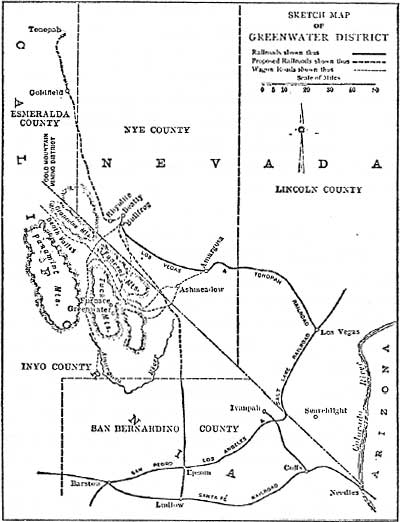
|
| Illustration 190. A somewhat inaccurate map, published in late 1906, which nevertheless shows the relative distances involved between Greenwater and Rhyolite and Amargosa, its two main supply points. |
As the rush to the area continued, however, it soon became apparent that the lack of an adequate water supply anywhere in the vicinity would be a major problem. "The water proposition is the serious drawback in that section at present, and will be a matter of considerable expense," remarked a Rhyolite stock broker, "yet the earmarks of the country seem to show that any expense would be justified, judging from the surface indications." Those surface indications were were indeed so rich that men and money continued to rush into the district, regardless of the serious problems of water and transportation. As the spring progressed, some of the biggest names in Nevada mining joined the boom, and fortunes reaped in Tonopah and Goldfield were reinvested in the promising new district.
"All of the great copper magnates are looking to this section," reported the Inyo Register in May, "which is destined to become the next great copper district of the world." That prediction seemed to be borne out by June of 1906, as the copper belt was "proven" to be at least seven miles long. Four of the larger mines had by now been incorporated into full-fledged mining companies, and Greenwater seemed assured of a long and lively life.
The rush slowed down somewhat during the hot summer months of 1906, although the future of the district looked even better when both the Las Vegas & Tonopah and the Tonopah & Tidewater Railroads, which were building into the Bullfrog District, expressed interest in tapping the new copper belt into the south. The local papers declared that the district "will make one of the greatest copper camps in America," and the continuing rush caused the major national mining journals to take notice of the area. "The weather in Death Valley is the only thing that prevents Greenwater from having one of the biggest booms on record in this country," wrote the Bullfrog Miner. "But even the midsummer heat of the "terrible region" does not keep prospectors out. Hardly a day passes that Bullfrog prospectors are not seen starting out for Greenwater." in early July, a stage line was started from Ash Meadows into the new district, and water, which was being hauled in from fifteen miles away, was selling for $5 per barrel. [2]
During one week of July, seven different properties were bought and sold in Greenwater, and by the end of that month, the demand for surveying and assaying support for the prospectors and promoters was so great that two offices had been established in the district. Over fifty miners were working for the five companies which had started sinking by the end of July, innumerable others were combing the hills for promising locations, and the Greenwater Miners Union was organized. A crude road from the Rhyolite area had been carved out, which cut travel time to five hours by auto, but still the water problem plagued the development of the district. In addition, so many claims were being located, sold, exchanged and relocated that inevitably conflicts began to arise between claim holders.
Hundreds of thousands of dollars had changed hands by the end of July, as feverish trading of mines and claims took place. Five mining companies were organized, and the capital stock of four of them reached the figure of $5,750,000. "This week auto after auto loaded with prospective investors has gone to Greenwater, and the demand locally for horses and rigs has almost exceeded the supply," reported the Bullfrog Miner. The rush was causing scarcities in Greenwater, and water rose to $7.50 per barrel, while horse teed was almost as hard to find. But the rush continued, and "As is usual in new Nevada mining camps the townsite epidemic has broken out in a decidely virulent form. No less than three towns are already planned, and it is a difficult matter at this time to tell which is going to be the commercial center of the district. That there will be a flourishing town in the district goes without saying, but which and where it will be is a matter of conjecture at this writing. It has the most observing man guessing."
As more and more prospectors flooded into the area, concerns began to arise over their welfare. Printed warnings were published in the Rhyolite papers, warning prospectors to bring all the food and water they would need into the district with them, since none could be provided there. Water was being hauled from Furnace Creek in Death Valley, but "Teams making the trip to the creek and back, fifty miles, drink about as much as they can deliver, making it almost impossible to get any reserve supply. Unless travelers heed the timely warning there is liable to be real suffering, and perhaps a number of deaths," Several mine owners, who were importing water to meet the demands of mining and to supply their employees, publically warred prospective visitors that they could no longer afford to sell water to private individuals.
But despite all these serious problems, there was no denying the allure of the Greenwater District, and the rush continued in August. By this time, the district was beginning to take shape, competing towns had been surveyed and platted, and one of them had established a boarding house. On July 29th, a meeting was held to organize the new district, in order to alleviate some of the problems caused by conflicting claims, and to remove the necessity for prospectors to travel all the way to Independence, California, to record their claims. The population of the district was now estimated at 300, and several stores and a restaurant had opened for business. Kimball Brothers, the staging kings of Rhyolite, announced a new stage line which would make thrice-weekly trips into Greenwater, and one traveler counted over 100 freighting wagons heading towards the district in one day, straining their resources to supply the growing demands of the new boom camp. Canned tomatoes were an especially popular item for sale at the crude tent stores, since they were cheaper than water, which was now selling for $10 a barrel, and quenched the thirst almost as well.
The rush to the new region had several unique aspects, which the local newspapers were quick to spot. Due to the extremely rich surface showings, money was pouring into the district at a tremendous rate, before ground was even broken. As the Rhyolite Herald noted, money seems to have beat labor to the scene of activity, as the big capitalists were on the ground and buying claims when no work has been done. It is not a poor man's region," agreed the Bullfrog Miner, "but one which will require a great deal of money to develop it."
All this business, of course, was good for the Rhyolite area merchants, and the new boom was looked upon favorably. "All Nevada is taking a hand in this rush," noted the Inyo Independent "as practically the whole of the United States has been told of its marvelous deposits of copper, which are revelations to geologists and mining men in general. Although the district hardly needed another spur to its boom, it got one anyway on August 10th, when the organization of the Greenwater Death Valley Copper Company was announced. Promoted by Charles Schwab, the steel and mining millionaire whose name was magic to Nevada miners, the new company was incorporated for $3,000,000, and together with Patsy Clark's Furnace Creek Copper Company, assured "a thorough and complete development of the district."
By the middle of August, the townsite rivalry was beginning to take shape, as two major competitors emerged from the dust. Arthur Kunze was the chief promoter of the first, and his town seemed to have the edge. Alternating between the name of Kunze and Greenwater, Kunze's townsite was located midway between the mines of the Furnace Creek Copper Company and the Greenwater Death Valley Copper Company--the districts two largest mines. By mid-August, Kunze's townsite boasted of two stores, and a hotel, a restaurant and several corrals were under construction. The Salsberry Water Company was under contract to Kunze to keep the camp supplied with water, and a petition was sent in for the establishment of a Post Office.
The Kimball Brothers obligingly routed their stage line to Kunze's townsite, and the Tonopah Lumber Company, in addition to establishing a lumber yard to supply the hectic construction pace, sent down several 12-horse teams, to be used in hauling supplies from Johnnie Siding of the Tonopah & Tidewater Railroad to the new townsite. The lumber company, in addition, supplied a 2,500 gallon water tank for the townsite company, and Kunze's plat of the town, which showed thirty-two blocks with over 550 lots for sale, was approved by the Inyo County Commissioners on August 13th. Assessing the situation, the Bullfrog Miner predicted that Kunze's camp seemed to have the inside track over it main rival, the townsite promoted by Harry Ramsey.
Just to add to the confusion, Ramsey also insisted on calling his townsite Greenwater, although it was commonly called Ramsey, and less commonly called Copperfield. Whatever it was called, its location was hard to pin down, since it was variously described as being one to four miles east or southeast of Kunze's camp. Nor did Ramsey help alleviate the confusion when he moved his site around at least once. Nevertheless, Ramsey vigorously promoted his own town, and even tore down his iron office building at Rhyolite and moved it to Greenwater-Ramsey-Copperfield.
As the rush continued, one observer counted $25,000 worth of supplies heading into the Greenwater District in one day, and another counted 200 miners and prospectors in the area, not including those who were out in the hills surrounding the camps. The Engineering Mining Journal assessing the Greenwater boom, noted that the "copper finds there recently have brought about an excitement equal to that at Bullfrog two years ago. Hundreds of people from Tonopah, Goldfield, Lida, Palmetto and the Bullfrog towns are traveling towards Greenwater in all sorts of conveyances. As high as $200 is being paid to automobile companies for transportation by wealthy operators who are anxious to get in early."
But getting into Greenwater was not that easy for those who could not afford the $200 to rent an auto. Those who arrived by train via Johnnie Siding could sometimes hitch a ride on one of the big freight teams constantly traveling between the railhead and Greenwater, but that trip took from twelve to fifteen hours. The Kimball stage took just as long, for the relatively reasonable rate of $18 per passenger, but spaces were limited, and numerous travelers found themselves forced to wait at Johnnie Siding for a day or two before their turn on the stage came. One migrant described his trip to the Bullfrog Miner, "It's a fright of a trip; 55 miles from Johnnie siding,; sand most of the way. Stage leaves Johnnie siding 3:00 p.m.; had supper at Ash Meadows; camped for the night 10 miles this side of it." Once arrived at Greenwater, the situation was not much better. "About 70 to 100 men here and about 100 gallons of water, 15¢ per gallon. Meals $1 transiently, regular 1.50 a day. Store and a restaurant here and about a dozen tents. The camp is on Kunze's ground. Clark [Patsy Clark's mining camp, also known as Furnace] is about 2 miles west and Ramsey 2 or 3 miles east"
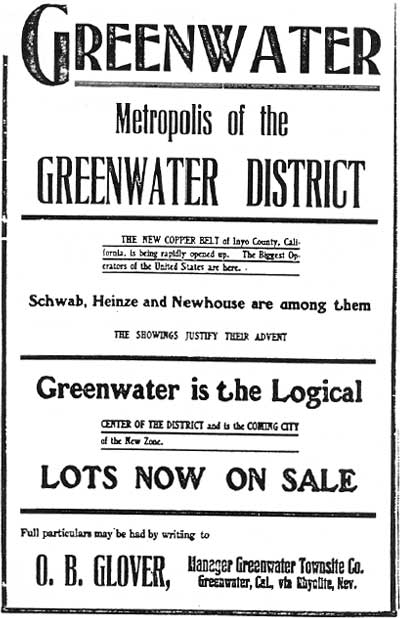
|
| Illustration 191. Advertisement for Ramsey's townsite, variously known as Greenwater, Ramsey and Copperfield. From the Bullfrog Miner, 31 August 1906. |
As August came to an end, the Greenwater District braced itself for the increasing rush which would undoubtedly come with the cooler weather of the fall and winter. Arthur Kunze and Harry Ramsey continued to promote their towns, and endeavored to attract the merchants which would make their camps the winner. Ramsey formed the Greenwater Townsite Company to promote his camp, and by the end of August he had a restaurant, two saloons, a hotel and a store. Kunze, meanwhile, had completed arrangements with several merchants, and the Greenwater Banking Corporation was organized, with a capitalization of $100,000, as well as the Greenwater Mercantile Company, which planned to erect a large general merchandise store. In addition, Kunze's site had a lodging house, a store, a saloon, a restaurant, and a number of tents as well as a "first class assay office.
Kunze seemed to have an advantage over Ramsey, since his townsite was higher in the hills, and was cooler than Ramseys site, which was on the floor of Greenwater Valley--an important consideration. The local folk, however, were divided in their assessment of the future winner of the townsite struggle, although the Rhyolite Herald picked Ramsey's camp to win. But whoever won, "the townsites are lining up for the struggle of supremacy and everything points to a prosperous fail and winter." [3]
As the fall season opened, the anticipated rush to the Greenwater District exceeded all expectations. The ingoing stages were crowded beyond capacity, and the congestion of freight and passengers at Johnnie Siding grew alarming. Huge piles of freight built up at the railhead, and many prospectors were reduced to walking the fifty-five miles to the camps. The competing townsites took advantage of the rush to proclaim their respective appeals. Ramsey's camp, despite being moved, still gave stiff competition to Arthur Kunze's town and Patsy Clark's camp of Furnace--although the latter was never intended to be more than a convenient camp for the miners working at Clark's Furnace Creek Copper Company mines. Dr. S. Trask of San Francisco was persuaded by Kunze to move into his town and start a drug store, a new saloon was started, and Bob Brogleman, proprietor of the Greenwater Mercantile Company, began construction of his large store. Several more boarding and lodging houses sprang up at Kunze's camp, until he could boast that ample boarding and lodging accommodations could be had. The Greenwater Banking Corporation started in business, and although the price of water declined slightly to 15¢ per gallon, water was still such a problem that the Ash Meadows Water Company was organized, at a capitalization of $3,000,000, in order to pump and pipe water in from that site to the growing towns of Greenwater.
By the middle of September, Jack Salsberry of the Tonopah Lumber Company reported that he had sold 150,000 board feet of lumber in Greenwater, and had orders backed up for 300,000 feet more. In addition, the lumber company had contracted to haul 625 tons of freight into the district, including 120 tons for the Kunze townsite and 16 tons alone for Brogleman's store. The lumber company by now had large water holding tanks erected at both Kunze's and Ramsey's townsites, and had several six-horse teams constantly hauling in water to supply the tanks.
Even though over 100 men were employed in the fourteen mines working in the district, labor was becoming scarce, as most men preferred to prospect on their own in the hopes of striking it rich, rather than settling down to a regular job. But as the boom continued, the camps seemed to show signs of being able to handle the influx of migrants. Although water still cost from $8 to $0 per barrel, "and the expense of feeding a mule is still as great as the money paid by a sojourner at a first-class hotel in New York City," there was at least enough tents so that most men who wished could sleep under cover, and it was possible to obtain food in the camps. In order to supply the increasing crowds, the Kimball Brothers increased their stage service from Johnnie Siding to a daily basis, and promised to try to make the trip to Greenwater in one day.
Al Neilson, the recorder of the Greenwater District, reported on September 21st that he had recorded 700 claims since the district was officially organized on September 6th. The Inyo Independent reported in mid-September that the district now had at least 1,000 people, with more crowding in every day. As could be expected in the midst of such a boom, trading in Greenwater stocks went wild. One company, the Independent reported, could fix its total value at $5 million based upon the selling price of its stock, even though it had sunk only to a depth of 280 feet, and had shipped no ore. The Associated Press, in turn, reported that during a two week period in September, sales aggregating a grand total of $4,125,000 had been made in Greenwater, and the "price of everything in the district has shot sky high." The Engineering & Mining Journal noted that Greenwater was "no place for a poor man, as provisions and water are both high in price, though on the other hand any prospect which may be found may be sold."
The Rhyolite brokerage firm of Taylor & Griffiths, who were gleefully trading Greenwater stocks as fast as they could get their hands on them, also reported the same trend. "The interest in the Greenwater district is intense. The demand for good properties is far in excess of the supply." As examples, Furnace Creek Copper stock, which had a par value of $1, and which was initially sold for 50¢ per share, was now trading around $4.50 per share, and Greenwater Death Valley was selling around $2. Furnace Creek Extension stock was put on the market at its par value of $1 per share, and was immediately oversubscribed, even though the company had not yet stuck a single pick into the ground. Greenwater, in short, was a promoters dream.
As September came to an end, it seemed sometimes that all of Rhyolite was decamping for the new district. Ramsey's town reported a population of 200, and at Kunze's, Bob Brogleman reported doing a land office business at his merchandise store, even though he hadn't finished building it yet. The Rhyolite papers began to blossom with large and elaborate advertisements placed by Greenwater companies, most of whom were not yet working. In September alone, six more mining companies were incorporated, bringing the total in the district to sixteen. The capitalization of thirteen of those companies totaled over $20 million. [4]
The month of October saw the height of Greenwater's boom, as everyone took advantage of the cooler fall weather to get into the district and locate good ground. During this month alone, fourteen more mining companies were incorporated in the district. As usual, some of these companies had mines, and some did not. With the great proliferation of mines and mining companies, moreover, the less honest of the mining promoters found it easy to cash in on the unbelievable boom spirit which surrounded the Greenwater name. Taking their cues from the two leading mines of the district, the Furnace Creek Copper Company and the Greenwater Death Valley Copper Company, a confusing list of mining companies appeared on the local trading boards, as well as those in San Francisco and New York. Who, for example, could hope to remember the difference between the Furnace Creek Copper Company, the Greenwater Furnace Creek Copper Company, and the Furnace Creek Consolidated Copper Company, let alone the Greenwater Consolidated Copper Company, the Greenwater Copper Mining Company, the Greenwater United Copper Company, the United Greenwater Copper Company and the Greenwater Copper Company, each of which was a distinct organization?
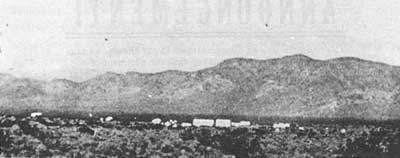
|
| Illustration 192. Ramsey, Greenwater District. Unfortunately, our only photo of Ramsey's townsite, alternatively known as Greenwater, Ramsey and Copperfield, is a rather poor one. This view was taken by representatives of the Engineering & Mining Journal during their trip to the area in October of 1906, and was printed in the Journal of December 15th. Photo courtesy of William Metscher collection, Central Nevada Historical Society. |
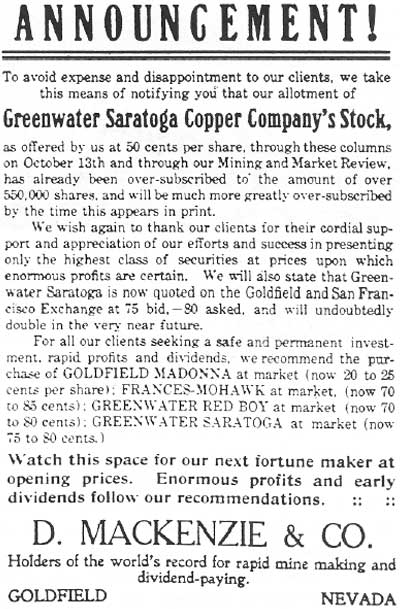
|
| Illustration 193. An early Greenwater mining advertisement, from the Rhyolite Herald, 19 October 1906. |
As with the mines, the towns of Greenwater also entered a true boom period. Construction began in early October on a two-story building for the Greenwater Banking Corporation, and a safe was ordered to store its money. By the middle of the month, the Inyo Independent reported that investment capital in the new district had already reached the $15 million mark. Every prominent copper operator in the United States had some interest in the district, and claims had been staked for twenty miles on every side of Greenwater. Over forty mining engineers had made reports on the mineral potential of the area for their respective employers, and it was the "unanimous opinion that Greenwater will excel in copper production, both the camps of Bisbee and Butte." [5]
The district by this time had 450 men and four women, and Kunze's town of Greenwater had five saloons, three restaurants, two general merchandise stores, and three lodging houses, where cots or springs on an old dry goods box cost $1 per night. Telegraph and telephone lines were being run from Bullfrog to Greenwater, and were nearing the town. Some luxuries were available, but when the first case of champagne entered the district, there were so many potential buyers that it was put up for action and sold for $150. Due to the lack of ice, liquor and water were both cooled by being stored in gunny sacks. The water itself served many purposes, first being used to wash dishes, second to wash clothes, and then given to the mules and burros to drink.
Happily, wages soared as high as prices, since miners who were willing to work steadily instead of prospecting on their own were somewhat rare. Unskilled miners and common laborers commanded $4.50 per day, carpenters were paid $8 daily and were in great demand due to the building boom, and expert miners received $5 to $5.50 per day. No one worked more than an eight-hour day. The boom is growing more tremendous with each day, summed up the Inyo Independent "Tons of machinery are being crowded into the Greenwater district; freight has become congested; every team for miles has been pressed into service and people are hurrying into the district as fast as the stage line can carry them."
Between forty and fifty mule teams were hauling in supplies from Johnnie Siding, but no progress was made in reducing the back-load which was still piled high at the railhead. Kunze's camp of Greenwater was booming, and as much as $1500 was reported to have been paid for an inside lot. Kunze even succeeded in landing the pearl of every self-respecting mining camp, its own newspaper. On October 23d, the first issue of the Greenwater Times appeared on the streets. It was an eight page paper, published every Tuesday by James Brown and Frank Reber, and halt of its eight pages were canned material. Nevertheless, the rest of the issue was chock full of new, gossip and tidbits, some confusing and most exaggerated.
By this time the camp of Greenwater was beginning to change from a tent to a board town, and the Greenwater Times was sure to note all the newly constructed buildings. Bob Brogleman, proprietor of the Greenwater Mercantile Company, had a thirty by sixty toot frame building with a "handsome rustic front," which housed his store, hotel and restaurant. Messrs. Smith and Owsley had the newest saloon, in a twenty by thirty-foot frame building with a shingled roof, John Salsbury had an eighteen by thirty-foot office building almost completed, and his thirty by sixty-foot store building would be finished in a few days. Arthur Kunze's building was almost completed and it would house the Post Office, which had been granted to his townsite, as well as the bank and his private office. E. L. Phelps had his saloon in a boarded tent, Tom Murphy was building a men's furnishings store, and J. J. Griffith had let a contract for a twenty-room hotel. Commenting upon the building boom, the Greenwater Times smugly predicted that it was "safe to prognosticate that Greenwater will be growing thirty years hence." After all, the "future of the city of Greenwater is surely as open and easily read as any book--and the reading says it's the greatest copper city of a century."
The advertisements carried in this first issue of Greenwater's paper give an insight into other business establishments in the town. In addition to the ones mentioned above, the Greenwater Brokerage Company, the Greenwater Restaurant, Edward Behten's real estate, investments and mining office, the Do Drop Inn, the Greenwater Lumber Yard, the McKinney Glover law, mining, real estate and brokerage company, the Greenwater Club, Hunter & Hutner's civil, mining and electrical engineering firm, J. C. Davidson, notary public, Reber & Company's real estate and mining information offices, the Bank Saloon, and Kennedy & Lass's assaying and surveying service, all placed advertisements in the paper.
The booming mining business was also good for the labor interests, and by late October, the Greenwater Miners Union was over 00 strong. Meetings were held every Tuesday, and the Greenwater Townsite Company donated two "very fine lots to the union, where they intended to build their union hall. The miners started a fund drive to build and staff a union hospital, and proudly proclaimed its motto across the pages of the Greenwater Times "It is Justice the World Needs! Not Charity!"
In other news, the Times reported that the chief engineer for the Las Vegas & Tonopah Railroad was in town to select the best rail route into the district, and that due to public demand for living space, Patsy Clark had agreed to throw open his townsite of Furnace, which had hitherto been reserved for employees of his mine. Then, as was fitting, the first issue of the Greenwater Times closed with a large advertisement for the Greenwater Townsite Company. Greenwater was, according to this ad, "The Greatest Copper City of the Century." The payroll at its mines already exceeded that of Beatty, Bullfrog and Rhyolite combined, and $52,500 in real estate had been sold in Greenwater in the month of September. Still, however, business lots were available at "ground floor prices" to anyone interested.
Less than a week later, the Inyo Independent took its turn at marveling at the wonder of the eastern California desert. Lock at the place, the paper said, where back in July only one tent was to be seen. Now Greenwater was a well laid out city, with over 1,000 people in the district. At the present rate, the population would be 2,000 before the year was over The Bullfrog Miner, noting the same week that nearly $20,000,000 had been invested in 100 claims in the last six months at Greenwater, agreed that "by far the most sensational jump into prominence of any mining camp added to the map in many years is that of Greenwater . . . Greenwater is without doubt the greatest copper mining territory ever found in the world." Only the Engineering & Mining Journal, the far away and much more staid publication, managed to hold its breath. In a much more realistic appraisal, and one which immediately became immensely unpopular in Greenwater, the Journal noted that the "district is too new, however, to permit of trustworthy predictions as to its future, and it will take many months before development work can be carried far enough to establish its real value, and make it a factor in copper production. The present indications, however, are promising."
Although the Engineering & Mining Journal was absolutely correct in stating that it would be many months before anyone began making money by mining copper, that was too cold an assessment for a boom town. There were much easier and quicker methods of making money in a boom town, and although all of them were risky, there was not a lack of men who were wilting to try. Charles Crismor, for example, was a favorite Horatio Alger-type story much played up by the local papers. Arriving in Rhyolite in January of 1906 with 30¢ in his pocket, he had entered the restaurant business there. With the advent of the Greenwater boom, Crismor had grubstaked two prospectors with left-over food from his dining room, and by the 1st of November had sold the claims which they staked for a $150,000 profit. Such was the way money was made at Greenwater. The promoters who bought those prospects, in turn, incorporated a mining company to find cut if there was any ore in the ground, and sold stock shares to the investing public, which by now extended from the west to the east coast. The promoters paid themselves salaries out of the proceeds of the stock sales, and used the rest of the funds to look for ore. Only if ore was found would a profit flow back to the stockholders. H the meantime, as long as the boom lasted and people could be persuaded to invest their money in Greenwater's mines, everyone on the ground was making money.
As the boom continued and the mineral district spread farther and farther out across the desert, new towns appeared to accommodate those miners who lived too far from Greenwater, Copperfield or Furnace to walk to work. South Greenwater, for example, was started on the grounds of the Pittsburgh-Greenwater Copper Company, fifteen miles south of Greenwater itself, in early November, Later that month, the town of East Greenwater was started, to serve the mines in that area, approximately eight miles east. At about the same time, the first gas hoists began to arrive in the district, marking the transition of some of the companies from the exploration to the development stage of mining. Eleven more mining companies were incorporated in November, bringing the total in the district to forty-one. Many times that number of small mines, locations and prospects were also being held and worked by individual miners who were awaiting the proper price to sell their locations to mining companies.
And the towns continued to grow. Our best information concerns Kunze's Greenwater, since the Greenwater Times naturally boosted its own town over the rival camps. By November 6th, Greenwater had two barber shops, and twenty wooden buildings were in the course of construction. A lawyer had moved to town, to take advantage of the lucrative fees involved in the inevitable mining conflicts, Paul Wiesse had started a butcher shop, and two more restaurants were ready to open, bringing the total to five. T, E. Blake opened a shoe repair shop, two more offices full of mining engineers and surveyors opened, and J. C. Collins announced the grand opening of his Undertaker and Scientific Embalmer' services. So many carpenters were now in camp, serving the demands of the building boom, that they organized themselves as a local branch of the Nevada carpenters union.
Despite the boom fever, there were several firms besides the Engineering & Mining Journal which managed to resist the excitement of the rush. William Clark, president of the Las Vegas & Tonopah Railroad, for example, resisted the heavy local pressure to begin immediate construction of a branch line into Greenwater, and instead more reasonably announced that the branch road would be built "just as soon as we are fully assured of the camps' permanency." The pressure on Clark was tremendous, for if Greenwater did turn into a productive camp, the first railroad into the district would reap enormous profits. !n addition, the Greenwater fever had invaded the Clark family itself, for J. Ross Clark, William's brother, had invested in the district and incorporated the Clark Copper Company.
By the middle of November, the Greenwater phenomenon could no longer be called a boom or a rush in the usual meanings of those terms, and the Inyo Register described it best as a "stampede." No less than 100 people, said that paper, were arriving in the district every day, and still the demand for labor far exceeded the supply, since most of the newcomers preferred to look for their private bonanzas rather than settle down to shift work in the mines. As a partial remedy, mine superintendents had taken to placing pickets down the trails leading into town, in order to grab the miners as they arrived, and offer them jobs.
But the district still had several rather insurmountable problems, and in mid-November one of them was graphically highlighted when one of the water wagons serving the holdings tanks of the town broke down. An immediate panic ensued, and water prices shot up to $20 per barrel before the wagon could be repaired. It was a reminder, if any need be had, that Greenwater would never become a producing district until the water and transportation problems were solved, for under the present services only the very highest grades of copper ore could be profitably shipped out of the district.
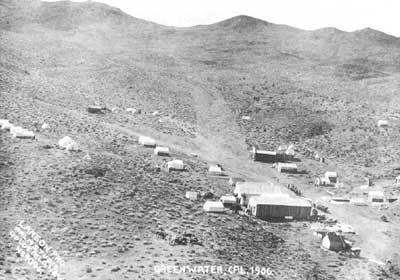
|
| Illustration 194. View of Kunze's Greenwater in late 1906, shortly before the townsite merger of Kunze and Ramsey's townsites. One large wooden building has been completed, and another is in the course of construction, while numerous tent and frame structures, the common mode of living, are much in evidence. Note the piles of lumber on the ground, the two freight teams in the middle of the street, and the feed yard in the center foreground. Photo courtesy Nevada Historical Society. |
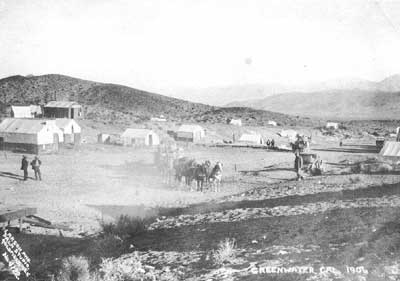 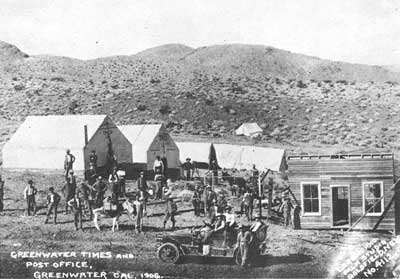 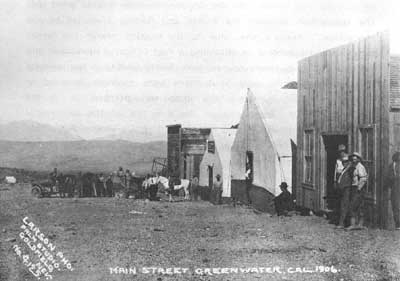
|
| Illustrations 195-196-197. Several street scences in the bustling life of Kunze's Greenwater townsite. Unfortunately, shortly after these photos were taken, the townsite merger was announced, and most of the buildings were taken down and moved out into the flat to the site of New Greenwater. Photos courtesy Nevada Historical Society. Unfortunately, no photos survive of the combined town of New Greenwater, formed by the merger of Kunze's and Ramsey's camps. |
By the end of November, the Greenwater stampede was of such proportions that although the district had yet to ship a single sack of ore, it was getting almost weekly coverage by the national mining journals. California and Nevada prospectors, miners and capitalists are thronging into the new copper camp of Greenwater . . . . as fast as they can get there by automobile, stage, wagon, burro or afoot wrote the Engineering & Mining Journal "The trails across Death Valley and the Amargosa desert are filled with men on the way. Rich men, ready to buy anything with a likely look are plentiful, which is a sure proof that the camp is on the boom . . . . From a population of 75 at the end of October, the camp has grown to 1,000 in a few weeks, and not less than 100 men a day are arriving. Labor is in demand, and already about 500 miners have been set to work on the big properties, and as fast as experienced miners come in they are at once given employment." As one single example of the continuing boom, Thomas W. Lawson of Boston, a noted copper operator and millionaire, purchased the Greenwater Red Boy and Greenwater Saratoga Mining Companies in late November for a reported $2,000,000 in hard cash, and immediately announced plans to erect a copper smelter. Indicative of this boom spirit purchase is the fact that Lawson intimated that the smelter would be built at Greenwater, regardless of the fact that there was no where nearly enough water anywhere around Greenwater to support a smelting plant. One wonders how carefully Lawson considered his purchase before laying down his money.
By now the Greenwater boom was so great that the competition between the Kunze and Ramsey townsites became impractical. Kunze's site, due to its location nearer the larger mines, and its success in obtaining a Post Office, a newspaper and several leading business houses, was clearly leading in the townsite race over Ramsey's camp, but there were problems involved in Kunze's physical location. His camp was perched up in the Greenwater Hills, practically on the end line of the Greenwater Death Valley Copper Company mines, and only a wooden fence kept drunken miners from walking off the end of one of Kunze's streets into one of the mines' shafts.
In addition, the leading mine owners of the district realized that a railroad was an absolute necessity for the future prosperity of Greenwater, and building a railroad into Kunze's town would be difficult, due to its location in the hills overlooking Greenwater Valley. Nor were the railroad interests very anxious to build directly into the heart of the mining district, for they had painfully learned at Tonopah how expensive it was to lay tracks over active and conflicting mining claims. Thus the railroad companies, both for ease of construction and avoidance of involvement in expensive land battles, preferred to build their rail heads at spots away from the actual mines. Charles Schwab, in turn, was growing uneasy at the prospect of a large town night on top of his mining claims, since that would lead to difficulties in opening up new ground when the time came. For a combination of these reasons, the leading promoters of the district decided in late November to move Kunze's camp of Greenwater away from its present location and down into the Greenwater Valley below, where railroad construction and and acquisition would be much easier and less expensive. After all, the planners at this time were expecting Greenwater to blossom into a city of thousands, rivaling the other great copper towns of the United States, such as Butte, Montana, and there simply was not enough room at Kunze's site for such an expansion.
As a result, Harry Ramsey's camp of Copperfield, which had never enjoyed the prosperity of Kunze's, suddenly found itself saved. A new Greenwater Townsite company was incorporated, which bought out the interest of both Ramsey and Kunze in their old townsites, and backed by the capital of the leading mining promoters, announced that the entire Kunze townsite would be moved down into the valley, near Ramsey's old site. Owners of lots in both Kunze's and Ramsey's old townsite would be given lots of equal value and location in the new town, and the new combined townsite would carry the name of Greenwater.
After the announcement of the townsite consolidation, the Las Vegas & Tonopah Railroad reported that it would build a spur into the new site, and John Brock announced that he would soon start construction on a $60,000 hotel. All was not well, however, for with the coming of winter, although mild snowfalls helped alleviate the water shortage, the cold weather immediately pointed out another serious supply problem in the district. Wood was almost unavailable as a fuel to warm the tents and buildings of the district, and Greenwater residents began to experience a "lively skirmish to get enough greasewood to keep warm."
Then, just to keep the townsite situation from becoming too calm, Patsy Clark decided to promote his townsite of Furnace, and ads began running in the Rhyolite newspapers. Lots were on sale, according to the ads, for $250 to $750 apiece, and over $30,000 worth of lots had already been sold. FURNACE," the ad proclaimed, "WILL BE THE METROPOLIS OF THE GREENWATER DISTRICT."
But wherever they were located, and whatever they were called, all the towns of the district continued to expand. The Southern Nevada Telegraph and Telephone Company completed the extension of its telegraph lines into the district in mid-December, and promised that the telephone lines would soon be finished as well. Wells were being sunk by several hopeful individuals and water was struck in one, eighteen miles from town. The Greenwater Townsite Company began laying pipe from Greenwater Springs to the townsite, although the flow of that spring was nowhere near enough to accommodate the demand.
By the end of 1906, with the population of the district pushing 1,500, the boom was finally slowing down, although everyone blamed the unprecendented cold weather rather than any abatement of the Greenwater fever. Several snow storms in late December caused much suffering, and the price of greasewood, which became increasingly scarce, rose to $15 a wagon load. Twenty loads, it was reported, were necessary to equal the burning power of a normal cord of wood. The cold weather stopped work on most of the mines, for only those whose shafts were deep enough to escape the effects of the weather were able to continue work. Still, nine more mining companies were incorporated in the district in December, bringing the total to fifty, and everyone sat back, waiting for a break in the weather, so that Greenwater's unprecendented stampede could continue. During the lull in the the action, the townsite move began, and New Greenwater, "The Greatest Copper Camp on Earth," was born. [5]

|
| Illustration 198. The first advertisement for Clark's townsite of Furnace. From the Beatty Bullfrog Miner, 8 December 1906. |
Hard on the heels of the townsite consolidation came the news of another large merger, which set even the feverish minds of Greenwater agog. Several of the leading mine owners, realizing that the district needed a smelter in order to become a producer, announced the formation of a giant merger towards that purpose. On December 15th, Charles Schwab, John Brock, and some financiers from Philadelphia formed the Greenwater Death Valley Copper Mines & Smelting Company. The merger company had a capital stock of 5,000,000 shares, par value $5 each, for a total capitalization of $25,000,000--an amazing sum which astounded even such boom-hardened towns as Goldfield and Tonopah. The new corporation was essentially a holding company, and consisted of the majority interests in the Greenwater Death Valley Copper company, the United Greenwater Copper company, and the unincorporated mines belonging to Brock and the Philadelphians. By pooling their resources, Schwab and his partners hoped to be able to cut costs and erect a large smelting plant for the reduction of the ores from each of the mines. Although no specific site was announced, Ash Meadows immediately became the leading contender for the smelter site, due to its proximity to a plentiful water supply and the railroads.
The new company announced that it would build its own branch railroad from the mines to the smelter area, thirty miles away, and that work would immediately begin on the railroad spur, the water development at the smelter site, and construction of the smelter itself. A smelting expert was hired by the merger company for $25,000 per year to supervise the selection of the plant site and construction of the smelter. In the meantime, although the mines involved in the merger came under the umbrella supervision of the new corporation, each would retain its separate identity and would continue to pursue its own development independently.
Spurred by this news, developments at Greenwater continued at a rather hectic pace. The townsite merger was being carried out, and in addition, Patsy Clark, who stayed outside of both the townsite and mining mergers, continued to plug his town of Furnace, By January 1st, that site was described as containing stores, business houses and a hotel. A separate stage line connected it with Amargosa, and a Post Office had been requested.
The new townsite of Greenwater was likewise experiencing growth, in addition to the confusion of consolidation. A second weekly newspaper, the Greenwater Miner, was started by an editor who was attracted to the boom district all the way from Nome, Alaska, and several more assaying, surveying and brokerage offices opened. But January saw yet another young publication start up, which turned out to be one of Greenwater's unique claims to fame, On January 1st, the first issue of the Death Valley Chuck-Walla hit the streets. The little magazine, published by C. E. Kunze and C. B. Glasscock, was best described by Glasscock in later years as "freakish." it was printed on butcher paper, for economy, and the two young editors launched their enterprise with a total capital stock of $35. As its advertisements read, it was "A Magazine for MEN." It was "written in a vein to please. It is entertaining as well as valuable. It exposes the crooks, the wildcats and the frauds, and roasts the knockers." And, as the cover declared, it was "Published on the desert at the brink of Death Valley. Mixing the dope, cool from the mountains, and hot from the desert, and withal putting out a concoction with which you can dc as you damn well please as soon as you have paid for it. PRICE, TEN CENTS."
The first issue of the Death Valley Chuck-Walla was especially unique, for it vividly described the total contusion inherent in the townsite move which was currently taking place. In an article, aptly titled "A Town on Wheels," the movement was portrayed: ". . . pandemonium reigns. Saloons and boarding houses, stores, and brokerage firms are doing business on the run and trying to be on both sides of the mountain at one time. A barkeep puts down his case of bottles on a knoll en route from the old camp to the new, and serves the passing throng laden with bedding and store fixtures . . . . The butcher kills a cow en route and deals out steaks and roasts to the hungry multitude hurrying back to the old camp to get the necessities for the new. Those who remain in the old camp are walking two miles to the new to get the eggs for breakfast. Those who have journeyed to the new are walking two miles to the old to get their mail, and a pair of socks. Through it all Jack Salsbury, Harry Ramsey and the Townsite Company smile . . . Questions as to the cause of the change are referred to the anti-publicity committee, and picturesque and forceful language as to the advisability of the change noted and filed for reference.
The Chuck-Walla had other aspects as well. Although the editors were totally committed to boosting the Greenwater District, they also realized that the proliferation of fraudulent mining schemes would hurt the district in the long run, and made it their pet project to uncover mining companies who were bilking the public. The first issue carried a long article damning the manipulations of the Boston-Greenwater Copper Company, promoted by J. Grant Lyman and his Union Securities company, Lyman, it may be remembered, had been arrested in Boston for pushing stock sales for non-existent mines around the Bullfrog area, and he was doing the same at Greenwater.
By January 4th, the Rhyolite Herald was able to report that the townsite consolidation was complete. Although the total population of the district and its towns was not easy to estimate, since so many men were constantly thronging through the hills, the Herald estimated it at between 1,500 and 2,000. More important, however, for the development of the mining district, was the report from the Fairbanks-Morse Company that it had received orders for at least twenty hoists of various sizes for the district, which indicated that more and more companies were beginning the transition from exploration to the development stage of mining. All the district needed in order to pass from a boom camp into a permanent mining town was for one big mine to make the next step, from development into production.

|
| Illustration 199. Front cover of the Death Valley Chuck-Walla, printed on butcher paper (which makes it extremely difficult to reproduce), showing the actual size of the magazine. |
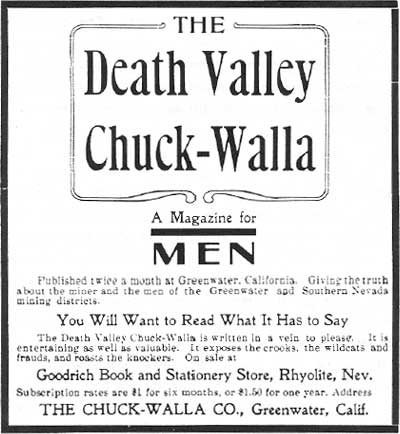
|
| Illustration 200. A typical advertisement for the Death Valley Chuck-Walla, this one appeared in the Rhyolite Herald on 8 February 1907. |
New Greenwater, meanwhile, reported thriving business. The townsite company surveyed 2,200 lots in over 130 blocks at the new site, and reported brisk sales. Lots on main Street sold from $500 to $5,000 apiece, and the county supervisors of Inyo county approved the townsite plat. The continuing cold weather, however, put a damper on business, as one miner reported that it was "fiercely damnable, and we put two-thirds of the time trying to rustle greasewood enough to keep from freezing." Despite the snowfall, water was still in short supply and was selling for $10 per barrel.
Nor were freight difficulties made any easier by the weather. The trip from Johnnie Siding by a loaded freight wagon took three to four days, and freight costs were still extremely high, due to the lack of enough teams to supply the demand. Freight charges from Johnnie Siding to Greenwater were $60 per ton, which succeeded in driving subsistence costs at Greenwater through the roof. The Greenwater Bank, however, reported no lack of business due to high costs, and in one week early in January reported $20,000 worth of transactions. Visitors to the district at this time could watch four separate surveying parties on the ground at the new townsite, as both the Las Vegas & Tonopah and the Tonopah & Tidewater Railroads had survey crews considering lines into the town, and the Southern Nevada Telegraph and Telephone Company also had two crews out, surveying lines for the telegraph and telephone extensions into New Greenwater, Farther up the road, a fifth survey crew could be seen laying out a new access road into Furnace. All in all, as the Engineering & Mining Journal noted, "There seems to be no diminution of the rush to the Greenwater . . ." The Journal however, was still puzzled about the Greenwater madness, for as it noted, "as yet none of the camps in that region has become productive."
The Engineering & Mining Journal was not the only publication to wonder at the immense rush into Greenwater. The Mining World, in late January, noted that "It is too early to predict the possibilities of this district. Its remoteness from transportation facilities and water have retarded its development, but notwithstanding the many difficulties encountered, very active work is being prosecuted on about 50 different properties. During the next six months, exploratory work will have probably progressed sufficiently to determine the persistence of the ore deposits. That was the crux: why was so much money being poured into the district, when the very existence of the ore deposits below the surface level had not yet been proven? Apparently the boom spirit, which had been ravaging throughout Nevada and eastern California since the bonanza discoveries at Tonopah and Goldfield, reached its height at Greenwater. In addition, since copper deposits at other camps such as Bisbee and Butte had always improved with depth, everyone assumed that the same would hold true for Greenwater. Since the surface richness at Greenwater far surpassed that of any copper camp ever, who could fail to think that Greenwater could indeed become the Greatest Copper Camp on Earth?
One paper, at least, did think exactly that. In late January the Goldfield Gossip printed its own assessment of the Greenwater District, and it was one which flew directly in the face of all the local predictions. "We have dissected reports from as many sources as possible regarding the future of Greenwater," wrote the Gossip "and all these agree that the camp would never make a production of copper to amount to anything." As might be expected, that report caused an immediate and extreme reaction from the Greenwater papers, particularly the Death Valley Chuck-Walla which more than adequately fulfilled its promise to "roast the knockers." The Bullfrog Miner also scorned the Goldfield Gossip's assessment, and printed its own: ". . . there can be but one future for Greenwater and that will be expressed by the six words 'Greatest Copper Camp in the World."
In the end, however, no one would know for sure whether Greenwater would turn into a producer or not until the actual time arrived, and meanwhile the Greenwater District enjoyed its booming prosperity. In late January, the Greenwater Times and the Greenwater Miner reported that the district had enjoyed its first marriage celebration. The growing affluence of the desert camp was also indicated by the notice of a piano for sale, and the Death Valley Auto Company was established, In addition, a town government committee was organized to supervise sanitary and police measures, and Inyo County appointed a Justice of the Peace and a constable for the district. District Recorder Nelson informed the papers that 3,000 location notices had been made in his book during the last five months, and estimated that probably 1,500 more had been recorded directly into the Inyo County books at Independence.
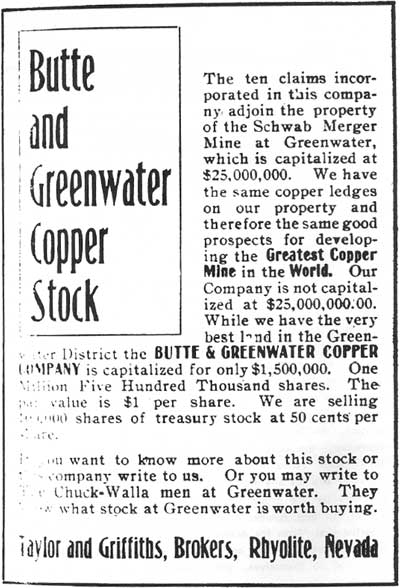
|
| Illustration 201. A typical Greenwater mining advertisement, as it appeared in the Death Valley Chuck-Walla, 15 February 1907. |
By mid-February, the Rhyolite Herald reported that it was confident that the Tonopah & Tidewater would build a branch into the Greenwater District, and even speculated that the road would be finished by June 1st. The Death Valley Chuck-Walla in its mid-February issue, put the population of the district at 2,000, including 500 in the town of Furnace, which was beginning to emerge as a real rival to the new Greenwater townsite. By this time, seventeen more mining companies had been incorporated since the first of the year, bringing the total of incorporated mining companies in the district to sixty-seven, but not all of them were working. Indeed, some of them never worked at all, as they were designed more to mine the pockets of gullible investors than to mine the ground. The Death Valley Chuck-Walla in one of its more valuable contributions, listed the mines of the area, and indicated that twenty-three of them were actually mining for copper.
Many of the mines listed by the Death Valley Chuck-Walla were not working, although most were planning to, and the magazine went on to specifically denounce several which it had proven were frauds. Neither the Greenwater Death Valley Copper Mining Company, for example, nor the Greenwater Consolidated Mining Company appeared to own any ground in the district, although both were actively advertising and selling stock. The Greenwater Death Valley Copper Mining Company in particular seemed to be relying on the close similarity between its name and that of the Greenwater Death Valley Copper Company to bilk unwary investors of their money, for the latter was one of Greenwater's biggest active concerns.
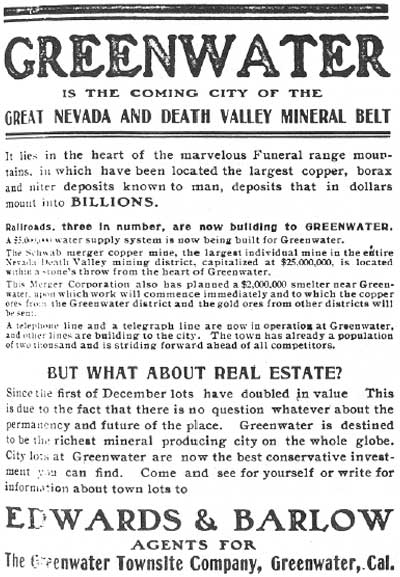
|
| Illustration 202. An advertisement for the combined town of new Greenwater, as it appeared in the Death Valley Chuck-Walla, 15 February 1907. |
The same issue of the Chuck-Walla carried a large ad for the Greenwater Townsite Company, which optimistically forecast that Greenwater would soon be the center of three railroads. The district's population, according to the ad, was over 2,000, and two telephone and telegraph lines were doing business. "Since the first of December lots have doubled in value. This is due to the fact that there is no question whatever about the permanency and future of the place. Greenwater is destined to be the richest mineral producing city on the whole globe." In addition, the magazine carried ads for several new Greenwater businesses, including the Greenwater Drug Company, and Alkali Bill's Death Valley Chug Line, a fanciful name for a desert character and his one automobile, who claimed he could take anyone anywhere for the proper price. Greenwater was now becoming so full of its own future, that the Engineering & Mining Journal reported that "From the desert comes the news that the Greenwater people believe that they are growing so rapidly that they need a county all to themselves, with Greenwater as the county seat."
But as February drew to a close, there was a decided slackening in the great Greenwater boom. The district had now been opened for well over a year, and had been in a boom stage for more than half that time, and as of yet, none of the companies which were sinking their shafts had found any ore under the surface which could compare with the rich surface streaks that had started the boom. This fact, while slow to dawn upon the district itself, was beginning to become apparent in the nation-wide stock market. The Rhyolite brokerage firm of Taylor & Griffiths also noted the trend, and commented in late February that the demand for Greenwater securities of acknowledged merit . . . has not been what it should be," but went on in the same breath to push stock sales. From a development standpoint, this district is making a most excellent showing . . . . The surface showing in the Greenwater district has never been surpassed in the history of copper mining . . . . It is now time for the man who is inclined toward copper to get in and secure same of this stock while it is low.
The Bullfrog Miner also noted the same slight slackening of the Greenwater boom, and reported that while "there is somewhat of a dullness pervading the camp, as far as the influx of people and industries is concerned, the properties are looking mighty fine. In a way, Greenwater was starting to succumb to its own over-blown boom publicity, for after the stampede to the district began to subside, everything else looked less than normal by comparison. [6]
But at the time, no one could possibly have hoped to persuade a Greenwater citizen that the bloom was beginning to fade. On March 1st, the papers reported that the Greenwater Death Valley Copper Mines & Smelting Company was beginning to work on the smelter site at Ash Meadows. More immediate encouragement came from the news that Mr. Lemle was opening a sub-agency for Budweiser at Greenwater, and was arranging for daily ice delivery via auto. "If he can run his autos over the hot roads fast enough to keep the ice from melting en route," said the Death Valley Chuck-Walla "he will surely catch the trade." During the same week, the Greenwater Meat Company was organized, and advertised that it would drive cattle across two mountain ranges from Owens Valley, California, to Greenwater, in order to furnish a constant supply of fresh meat daily to Greenwater inhabitants. The Furnace Townsite Company also stepped up its advertisements, and the Greenwater Townsite Company countered by running its own ads, plugging the unique and desirable aspects of its camp. In its bi-weekly rundown on Greenwater mining, the Death Valley Chuck-Walla was able to list twenty-one mines and mining companies who were actively working in the district.
Still, qualms of uneasiness were beginning to be felt around the district. The Bullfrog Miner was the first local paper to admit such, noting that "As yet there are no real mines in Greenwater, as mining men understand the term." The paper went on to qualify that statement, adding that the working shafts are down several hundred feet and the ore bodies are well enough defined so that the owners know that they have immense quantities of very valuable rock, but the workings so far have been confined to these shafts and no effort has yet been made to take out ore except such as was necessary in sinking the shafts." Privately, many Bullfrog operators were glad to see that the Greenwater boom was abating, for at the height of the rush, the drain of investment money towards Greenwater had decidedly hampered the operation of the mines around the Bullfrog District.
The mid-March issue of the Death Valley Chuck-Walla noted little change in the district, with nineteen companies actively working. On the brighter side, the Inyo Register reported on March 15th that articles had been filed at Jersey City, New Jersey, to incorporate the Tonopah & Greenwater Railroad Company, with the purpose of building a railroad from the Amargosa Borax works to the Greenwater District. A capital stock of $500,000 had been created, and the construction of such a road, which would easily tie into the Tonopah & Tidewater, would mean a ready outlet for Greenwater's ores. Although no announcements were made, the Inyo Independent speculated that the recent incorporation undoubtedly meant that the Tonopah & Tidewater itself had decided not to build into Greenwater. The new railroad company was expected to start work soon, and complete the line by July 1st. Two routes had already been surveyed into the district, but no decision had been made as to which one to use.

|
| Illustration 203. A later advertisement for Patsy Clark's townsite of Furnace. From the Death Valley Chuck-Walla, 1 March 1907. |
By the end of March, the Bullfrog Miner put the population of the district at 2,000, which indicated that for the first month since the district had been discovered, it had not grown. Both Greenwater and Furnace, however, were described as being very alive and bustling, and both townsites had hotels, lodging houses, saloons, feed corrals, freight companies, meat markets, auto lines, brokerage houses, attorneys, newspapers, boarding houses, etc. In addition, three railroad lines had been surveyed into the district, the Ash Meadows water company was working on getting water piped into the district, and an electric light system was projected for the towns.
But the boom had definitely slowed, as evidenced by the incorporation of only seven more companies in the district in March. The following months of April and May would see one additional company incorporated during each, bringing the total of incorporated mining companies in the Greenwater district to seventy-three. Although that was more than enough, the cessation of incorporations meant that the exploration stage of the Greenwater district had finally drawn to a close, after a short but extremely violent boom, and the future of the district now depended upon what ore bodies were found under the ground during the subsequent development phase.
On April 1st, the Death Valley Chuck-Walla reported that twenty-four companies were presently engaged in finding out exactly what did lie under the surface of the ground. The pipe line for the Ash Meadows water system had been ordered, and a telephone connection had been completed between Greenwater and Furnace, enabling conversation between the two rival towns. Plans had also been announced for a new $50,000 hotel.
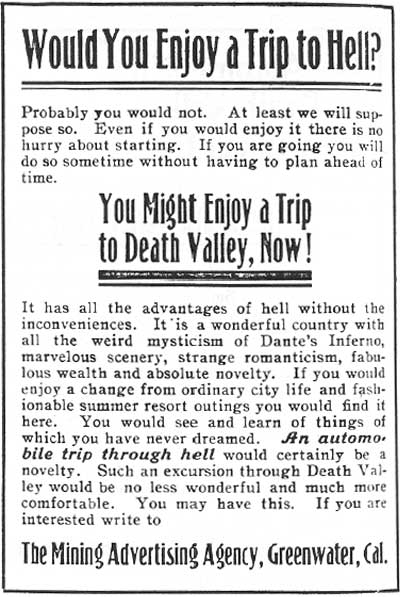
|
| Illustration 204. One of the most delightful advertisements of the Mining Advertising Agency, run by the editors of the Death Valley Chuck-Walla, which epitomizes their distinctive style, 1 April 1907. |
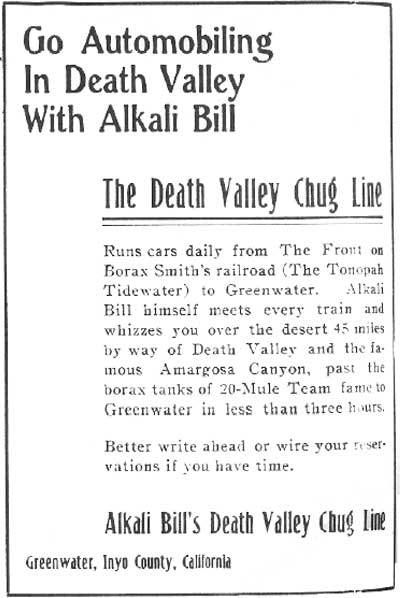
|
| Illustration 205. Advertisement for Alkali Bill's famous auto line, from the Death Valley Chuck-Walla, 1 April 1907. |
Two weeks later, the Death Valley Chuck-Walla was able to report twenty-six companies working, but as of yet no one had found sufficient ore bodies beneath the surface of the earth to warrant full-scale production mining. Towards the end of April, the Bullfrog Miner reported that 300 men were working in the district, with about half being employed in the mines around Greenwater and the other half around Furnace. The payroll for the district was approaching $50,000 per month. The townsites had settled down from the boom period, and Greenwater was described as being mainly a rag town, although it had some wooden and one iron building. Lumber was still very expensive, costing $130 per thousand board feet, which depressed the building industry, but the bank was thriving, and business in general was good. Water still sold for the very high price of $7.50, as compared to $5 per barrel which had been the highest price Bullfrog had known in its early boom days.
By the first of May, although twenty-six companies were still actively engaging in development work, it was becoming very apparent that unless someone found a large profitable copper lode soon, the district would be in trouble. The investing public, which by now expected great things from the district which had boomed so brilliantly, was becoming impatient, and as another month passed without any big ore strikes being made, stock prices began to slip.
The Death Valley Chuck-Walla noted the stock slump, but blamed it on the eastern Wall Street stock manipulators "who wish to bear the stocks until they can be purchased at a rate far below their real value and therefore at great profit." In reality, the Greenwater boom had led to too great of expectations from the investing public, and suspicions of a gigantic fraud were now beginning to form among the ranks of far-off investors. Nor did it help the Greenwater District that the first effects of the Panic of 1907 were beginning to be felt on the eastern stock markets. Naturally, shares of mining companies which were still in the initial stages of development were among the first to be unloaded by cash-hungry investors. Still, no one was ready to give up, least of all the naive young men publishing the Death Valley Chuck-Walla They could write with pride that their magazine was read by more than nine thousand stock brokers across the nation, although they sadly noted that only 1,000 of them had paid for their subscriptions. [7]
On May 1st, the Ash Meadows Water Company ordered 135 miles of pipe for its various lines into Greenwater, Lee and other spots. The line to Greenwater, it announced, should be completed by the middle of August, when water would be available for around $4 per barrel. During the same week, Inyo County belatedly got around to implementing a full civil government for the district, appointing a deputy sheriff, a deputy district attorney, a deputy assessor, a deputy tax collector and a new Justice of the Peace. By the middle of the month, the Death Valley Chuck-Walla could report 300 miners still at work. One company had no less than six gas hoists going full blast, and several were down to the 300 and 400-foot levels. Unfortunately, no ore bodies had yet been found.
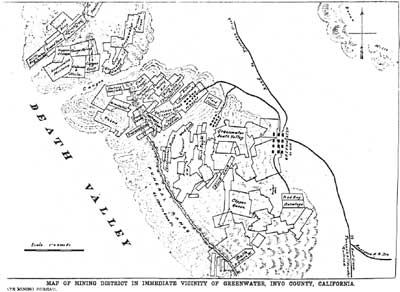
|
| Illustration 206. Map of mining district in immediate vicinity of Greenwater, Inyo County, California. California State Mining Bureau, Bulletin #50, September 1908. Map data compiled in May 1907. |
Towards the end of May, the Tonopah & Tidewater Railroad announced the opening of Zabriskie Station, which cut the distance between Greenwater and the railroad considerably. The company also announced the establishment of an auto service between the station and Greenwater, with connections to both daily trains. The auto ride would take two and a half hours, and tickets were available from the commercial agent permanently stationed in Greenwater. The Inyo County commissioners also announced plans to consider the erection of a turnpike from independence to Greenwater, at an estimated cost of $1,000, whereby travel time between the two towns would be shortened by several days.
On June 1st, the Death Valley Chuck-Walla could still point to twenty-five companies at work, and although no sizeable ore bodies had yet been found, no one seemed quite willing to give up. Articles from the district's two other papers, the Greenwater Times and the Greenwater Miner, also contained the same hopeful spirit, and the Engineering & Mining Journal noted that fifteen gas hoists were at work throughout the district, and that more miners were at work than ever before. For once, the labor problem seemed to be solved, for the buying and selling of claims had ceased with the coming of harder times, and more and more miners were willing to give up their dreams of instant wealth and settle down to earning a steady wage. In late June, the Inyo County Board of Supervisors let out bids to construct a branch jail at Greenwater, and announced that the proposed sixteen by twenty-foot stone and cement building would contain three cells.
Then, on June 22d, the inevitable fire swept through part of Greenwater. Although the relative damage was rather light, considering the destructive potential for fires in mining camps built of canvas and wood, one saloon and the offices and presses of both the Greenwater Miner and the Death Valley Chuck-Walla were consumed. The editors of the Chuck-Walla had only recently bought out the Greenwater Miner, and they immediately announced plans to secure a new printing plant from the west coast and continue both publications. But the capital stock of $35 which they had started out with had not increased very much over their six months of publication and after several weeks of trying to get their paper printed at the Bullfrog Miner office, the editors gave up and left the country. The Las Vegas one of the more mature Nevada newspapers which had never much approved of the style or approach of the Chuck-Walla, noted that it "was roasted alive by the Angel of Fire because of the many unholy things it has printed. The destruction of the Miner, (whose sins are less notorious) and the saloon only proved that chastisement, like rain, falls alike upon the just and the unjust."
The fire seemed to be an omen, for with the passing of the Death Valley Chuck-Walla Greenwater's loudest and brassiest booster, the fire seemed to go out of the district. The Ash Meadows Water Company, for example, had promised on June 29th that water would be connected into Greenwater by the 1st of August, but by July 13th, revised that date to September 15th, and added that pipe would be laid into Lee before Greenwater--indicating that the prospects of the Lee District now looked better to that company than did those at Greenwater.
As the summer wore on and fall approached, it became apparent to all but the most die-hard that the great Greenwater boom had started to bust, and many people could be seen quietly leaving town. As a continuing barometer, the Ash Meadows Water Company postponed its connections to Greenwater once again, and announced on September 13th that water would not be available to the district until the middle of November. Those who still had faith tried to explain away the decline of the district by advancing various causes. "The present situation is one of those cyclic occurrences that simply hampers the growth of what is coming," said one, "but will not stop it for you have the wares that the world needs so much." "The camp, as far as the town is concerned, is very quiet," noted another observor, "but work in the mines is going steadily on . . . . There is not much doubt as to the ultimate future of Greenwater. The camp is now going through the development period, which all camps have to undergo, in laying the foundation for their future prosperity.
But if the mines were still developing, not nearly as many were doing so as in previous months. Of the seventy-three companies which had incorporated to do business in Greenwater by the spring of 1907, only twelve were left by September. Although these figures must be qualified by pointing out that fully thirty of those companies never did any work at all, still it was apparent that the mining situation at Greenwater was definitely on the decline, and unless some ore was found soon, the camp would die. The Panic of 1907, which was beginning to hit the mining regions of the west by this time, obviously aggravated the problem.
Businesses, such as the Greenwater Lumber Yard, began to close their doors in the summer of 1907, and as the fall progressed, the trend increased. Fires again played a part, such as in mid-October, when Charley Hennessy's saloon, the Death Valley Vault, burned to the ground. Once the fire started, as in the case of the Chuck-Walla's office, the building was allowed to burn completely, since water to put out the fire was more expensive than the wood necessary to rebuild. The loss of the Death Valley Vault, however, was especially hard to take, since it had become famous throughout the district by offering a free face wash with every drink purchased.
Although fifteen hoists were still in operation in Greenwater in mid-October, and "more extensive development is expected as soon as the weather becomes cooler," even the local papers were beginning to wonder about the future of the district. The Inyo Register noted on October 17th that the "impression prevails that Greenwater is not in the best condition as regards mining showing, but protested a week later that "Greenwater has, for some occult reason been pronounced dead, or at least in decline. The facts in the case do not bear out such a statement.
Still, the paper noted that the population of the district was now estimated at 500, down considerably from the 2,000 of the previous spring.
The departure of businessmen continued in November, and included one of the editors of the Greenwater Times who sold out his half interest to his partner. "From a business standpoint the camp is on the bum," he told the Bullfrog Miner "but from a mining standpoint it looks better than ever." If from a mining standpoint he meant that the mines were reaching increasing depths, he was right, for two of Greenwater's biggest mines had by now sunk to 500 feet below the surface of the earth. But they still had not found the elusive copper deposits without which the district could not survive.
And as 1907 ended, those ore bodies were still not located. The district experienced a mild revival in December, as mine owners and prospectors came back in to do the annual assessment work on claims and locations in order to protect their titles for another year. But as the year ended, the population had shrunk to "several hundred," and only ten companies were still working, five of which had come under the control of the Greenwater Death Valley Cooper Mines & Smelting Company, the large holding company. [8]
As 1908 opened, it was dearly evident that the only hope for the Greenwater district lay in the two big mines which were still operating, and which were going for great depths to find the ore bodies. The Furnace Creek Copper Company, the Patsy Clark outfit, was still sinking on its property, as was the Greenwater Death Valley Copper Company, the main Schwab holding. Both were sinking below the five hundred foot level, and one or the other would have to find ore soon or Greenwater's mining history would be extremely short.
The work continued through January and February, but with no results. By mid-February, the once-bustling Greenwater District had shrunk to a mere shadow of its former self.
The only business establishments left in the district were the Tonopah Lumber Company, which was still supplying timbers for the mine shafts, two saloons, two stores and one restaurant. The total population of the district had fallen to [about fifty souls,] and the Rhyolite Daily Bulletin sadly wrote that the desert country about Greenwater is not as abundantly prosperous as it was one short year ago." The remaining buildings at Greenwater were already being torn down and moved to Gold Valley, a small boom town to the south. But those remaining at Greenwater did not give up easily. In early March a Greenwater report stated that a spur track from the Tonopah & Tidewater Railroad would 'probably' be built into the district at an early date, and as "soon as the building of the road is assured a great mining boom is almost a certainty." The report went on to blame the demise of Greenwater on the slump in copper prices worldwide, without remembering that Greenwater had no copper to ship, regardless of price.
The Furnace Creek Copper Company and the Greenwater Death Valley Copper Company continued to sink through April and May. S. J. Fairbanks told the Bullfrog Miner that "Every month or so these companies send their experts and I understand that the recommendations are to continue sinking. It is a well known tact that excellent ore was discovered on the surface, and these companies are going on the theory that depth will reveal profitable bodies." Fairbanks, who had one of the last remaining stores in the district, added that "These people are spending their money and taking a chance. If they can afford to do this, I can afford to await results, since l am making a living and then some, in the meantime." He was forced to admit, however, that "the camp is showing small encouragement at this time.
Later in April the Bullfrog Miner reported again on the district. "The future of the Greenwater district depends very largely upon the shafts which these two companies are sending down. It is held by geologists and mineral experts that if copper deposits exist in commercial quantities in the Greenwater district they will be found below the water level and at great depth, and these companies have undertaken to demonstrate the theory."
But still no ore was found, and the district continued to decline. The Greenwater Times the last of the district's newspapers, finally gave up and quit publishing shortly after the end of May. By early June, 5. J. Fairbanks reported that "Greenwater is only a shadow of its former self. Fairbanks had the only store and saloon left in the district, "and the population had dwindled to almost nothing." The only other business left in town was the Tonopah Lumber Company, which would stay as long as the companies were sinking and buying timbers for their shafts.
In mid-June the Greenwater Death Valley Copper Company struck a small streak of copper ore 1,000 feet below the surface, and mild excitement was felt again in Greenwater. Since many of the previous claims in the district had been allowed to lapse, the news of the strike brought some prospectors back to relocate their claims, in case the strike turned into something big. Within a week, however, it had proven to be only a small stringer, but even that brought out the hopes of the faithful. Although the extent of the strike was disappointing, the Rhyolite Herald reported that "the quality was good and will no doubt lead to a larger body of ore. The existence of ore at this depth will certainly be accepted as conclusive evidence that Greenwater is not a surface proposition as has so often been claimed. Despite the smallness of the strike, prospectors continued to come back into the district to relocate their claims, just in case.
Even the mining companies were heartened by the small strike, and as the Inyo Independent pointed out, "although Greenwater is not very active at the present time . . . it is a significant fact that the owners over there are patenting the mines and are spending sums of money which business men are not likely to throw away or sink in worthless ground." Closer papers, such as the Bullfrog Miner, were not so optimistic: "Greenwater, which once attracted such wide attention on account of rich surface discoveries of copper, has practically faded from the map . . ."
But such was the lingering magic of the Greenwater name that the rumors of a new rush would not die. In mid-July, the Engineering & Mining Journal reported that Greenwater "is again to the front, after being dead for many months." The Journal had its own unique idea as to why the previous strike had not been given much publicity, and wrote that it "was kept as quiet as possible until the Schwab interests could secure control of contiguous territory. Meantime there is again a rush of prospectors and others into the camp, incited by this reported discovery." But those who returned were sorely disappointed and soon left again, for the strike had definitely not amounted to much. The Tonopah Lumber Company finally gave up and closed down its Greenwater yard in late July, and by the middle of August the Bullfrog Miner reported that the "town of Greenwater has but few people left. Mr. Fairbanks himself is running the only store in town.
The decline continued through August. The Post Office at Greenwater was discontinued on the 15th of that month and moved to Death Valley Junction, and Mrs. Spear, proprietor of Greenwater's last restaurant, closed down late in the month and returned to Rhyolite. The Mining & Scientific Press, late in August, summed up the results of the summer season in the district: "Greenwater is still trying to keep itself from utter collapse . . . . Occasionally the long-silent telephone wires to Rhyolite dropped whisperings of fancy 'strikes' at Greenwater. These found their way into print, but Greenwater failed to sustain the promise of its earliest boom days for anyone to take much interest in these later murmurs."
During the rest of 1908, the district was exceedingly quiet. The Greenwater Death Valley Copper Company continued to sink in its shaft, going deeper and deeper in the search for ore. The Furnace Creek Copper Company did likewise, although at a slower and more desultory pace. The Greenwater Calumet Copper Company, which had been idle for some time, returned to perform the required annual assessment work in the fall, and several small groups of miners and prospectors did likewise. But as the year ended, no profitable bodies of copper ore had been found anywhere in the district, and it was quite apparent the time was rapidly running out for Greenwater. [9]
Just when it seemed that Greenwater was finally dead, another revival of hopes arose. Early in January of 1909, ore was again found in the Greenwater Death Valley Copper Company's mine, this time at a depth of nearly 1,100 feet. The mere mention of the discovery, before anyone knew the amount, extent or richness of the deposit, caused another mild rush back into the district. As the Rhyolite Daily Bulletin reported,
"Greenwater, the copper camp of the Funeral range, has steadily advanced in its development, and is believed to be on the verge of a boom which will eclipse its first meteoric flight. That such a boom is imminent, and will undoubtedly come early this coming year, is now confidently believed by those most intimate with conditions there. As a result of this change in the feeling toward this camp, most of the old-timers, who were first into this camp, and were most concerned with its success, are back again, doing assessment work, relocating good ground, and preparing fur the awakening which they say is sure to come soon!"
That article, which seemed wildly extravagant when printed in early January, began to look more realistic by the beginning of February, when the Greenwater Death Valley Copper Company announced the discovery of a sixty-foot ore body bearing 5 percent copper at a depth of 1,080 feet. The Bullfrog Miner reporting the discovery, remarked that the "new-old camp of Greenwater, the camp of glorious hopes and shattered promises is again to the front in the attention of the mining world On the proving of the new ore body depends the future of the Greenwater Death Valley mines, and practically of the camp of Greenwater." The news of the discovery started another small rush into the district, several other defunct mines reopened their works, and the population of the district soared up to 150.
Somewhere, new investors were found to back another plunge into Greenwater stock, and such companies as Greenwater Central Copper started work once again. Towards the end of February, as the mini-rush continued, the Bullfrog Miner once again reported that the "camp of Greenwater is on the rise from all indications. Parties with holdings there are putting forth more zeal in the development than has been shown for over a year."
Developments on several properties continued through March, with the East Greenwater Copper Company and the Greenwater Calumet Copper Company joining the list of reactivated mines. But the efforts were futile, and soon proved worthless. The small mines shut down again, and in March one of the two giants gave up, when the Furnace Creek Copper Company finally abandoned hope and ceased work. Throughout the summer and fall of 1909 only the Greenwater Death Valley Copper Company continued to work, and finally even that company quit in September. The shaft was stopped at a depth of 1,439 feet, and the papers were finally able to report for sure that Greenwater was totally dead. As the Inyo Register wrote in the nature of an obituary, with "the cessation of all work at the Greenwater Death Valley mine, the once thriving camps of Greenwater and Furnace Creek, California, have been given over to the reign of the coyotes. There is scarcely a man to be found in the entire district, and locally it is considered extremely doubtful that the Schwab company will ever resume work at the mine, which was once pronounced a bonanza." [10]
Greenwater was now definitely dead, and the great boom which had propelled its name across the headlines and stock boards of the nation was best forgotten by the thousands of investors who had been badly burned. The Mining World in its annual review of mining for 1909, summed up the demise of the once heralded district in one short sentence: "The copper districts of the county have lapsed into obscurity. With the final crushing of hopes, locations were abandoned, as were titles to the once thriving business blocks of Greenwater and Furnace, and the Inyo County papers started carrying long lists of delinquent tax payments due from mining companies, businesses and citizens who had once owned land in the district. The demise of Greenwater even had a ripple effect, as Amargosa, once a lively station on the railroad used to supply the Greenwater boom, declined by the middle of 1910 to a population of two.
Mining was never again revived in Greenwater, and by 1917 all that a visitor could find on the spot of the town of 2,000 inhabitants was one deserted cabin. Most of the buildings at Greenwater and Furnace were readily movable, due to the lack of permanent construction, and most had been hauled away by their owners. What was left had been taken by R. J. Fairbanks, the last merchant of Greenwater, and hauled to Shoshone, a settlement on the Tonopah & Tidewater Railroad, where Fairbanks started a small store which later grew into a thriving desert oasis.
Small attempts at sporadic production were made in 1916-1918, and again in 1929, during periods of very high copper prices, but these efforts never amounted to more than one or two man operations, and consisted mostly of gleaning the remains from the dumps of the old mines and laboriously packing it out of the desert. Total production from these activities was estimated at $10,000. During the early 1920s, Greenwater became a favorite winter rendezvous spot for the old desert-rats, a breed of shiftless and broken-down prospectors left over from the Nevada boom years, who gathered there for several winters to swap yarns about the old days, and dream their futile dreams of strikes to come.
A rather foolish attempt was made in 1970 to revive the Greenwater District once again, when a consortium calling itself the Furnace Creek Copper Company (no relation to Patsy Clarks outfit) scraped together the mining rights to a great number of claims in the district, and even paid for a wildly optimistic mineral report on the area. Happily, the backers of the company decided against the attempt to resume mining. Greenwater is now totally deserted, with the exception of occasional campers who remember the once-famous days of one of the deserts most glorious boom districts. [11]
b. Present Status, Evaluation and Recommendations
1. Greenwater Furnace and Kunze
The main portion of the Greenwater District lies within the boundaries of Death Valley National Monument, but due to an odd shift of the boundary lines in this area, the very heart of the district is outside the Monument. Thus, while the main workings of the Furnace Creek Copper Company are within the Monument, along with its supporting town of Furnace, the holdings of the Greenwater Death Valley Copper Company are outside the boundary, as are the townsites of Kunze and Greenwater.
The entire area is scattered with numerous dumps and shafts, monuments to the futile efforts to cash in on the Greenwater boom. The deepest of these, which belong to the Greenwater Death Valley Copper Company, are outside the Monument, but visitors need regard boundaries very little in this part of the country, since they are mostly unmarked, and there is little to differ between the remains inside and outside the Monument.
The only remains of note within the Monument are around the site of Furnace, where several outlines of old buildings and tentsites may be found. In addition, the dumps of various companies, mostly noteably those of the Furnace Creek Copper company, may be seen, as well as timbered shaft collars, loading dumps, cement hoisting platforms, etc. There is, however, very little that can be used as interpretive features in this section, although the forloreness of the desert landscape emphasizes the harshness of life for those miners and prospectors who once searched here for riches.
B. Glasscock, Here's Death Valley, p. 232. Frank A, Crampton, Deep Enough: A Working Stiff in the Western Mine Camps, (Denver: 1956), p. 269. John F. Jordan, Jr., "A Preliminary Appraisal of the Greenwater District, Inyo County, California, For the Furnace Creek Copper Company," Reno: 1971.

|
| Illustration 207. Map of Northcentral portion of Funeral Peak Area. |
To the southeast, outside the Monument boundaries, the site of old Kunze may be located due to the remains of three stone cabins, the ruins of several dugouts, and a scattering of old tentsites. The physical remains here are more extensive than anywhere else in the Greenwater district, but can rot be protected or interpreted by the National Park Service, due to their location. Between the site of old Kunze and Greenwater, the deepest shafts of the Greenwater Death Valley Copper Company are found, plainly marked by the impressive size of the dumps beside the road. Here again, however, there is little for interpretation to focus on.
Farther to the east, where once stood Greenwater, a maze of streets and trails may be seen cutting through the desert. Other than that, there is almost nothing to mark the spot, for what little remained of the site, after Fairbanks and the desert rats carted away. the remaining buildings, has long been picked clean by more modern tourists and souvenir hunters. Indeed, the most impressive thing about the site of Greenwater is how the town which once boasted 2,000 inhabitants could have disappeared so utterly.
2. Greenwater Springs
To the south of Greenwater is Greenwater Springs, the obscure little water hole which gave its name to the entire district. The area around the spring has the ruins of a stone shelter, an old mine shaft and dump complete with concrete hoisting foundations, and several prospect holes. At the spring itself some evidence of past attempts to improve the flow may be seen, including some timber and concrete work within the spring itself, and the remnants of some two-inch pipe which formerly carried the meager flow of water to the thirsty inhabitants of Greenwater.
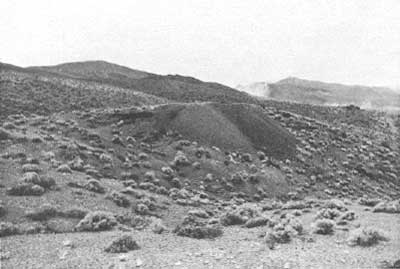 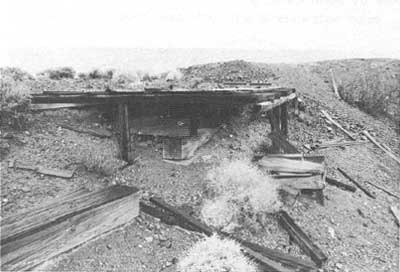
|
| Illustrations 208-209. Top: Abandoned site of one of the main shafts of the Furnace Creek Copper Company. Bottom: Close-up of same site, showing wooden hoisting platform. 1978 photos by John Latschar. |
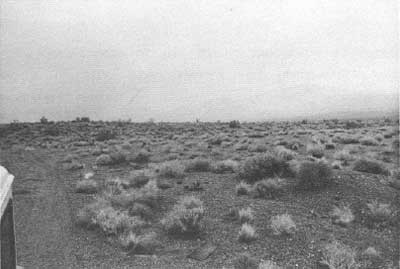 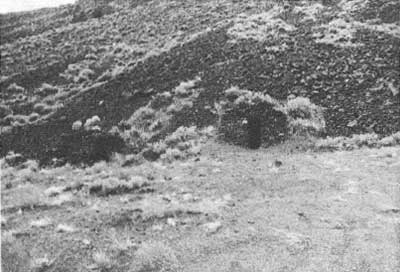
|
| Illustrations 210-211. Top: General view of the townsite location of Furnace. Although no structures are remaining, close examination of the ground will reveal numerous old tentsites and an occasional piece of debris. Bottom: Two of the stone houses still standing in the small valley where Kunze was once located. The one on the right is still complete with roof, but the one on the left has deteriorated considerably. 1978 photos by John Latschar. |
3. Coffin Mine
To the northwest of Greenwater, about five miles, is the site of the abandoned 'Coffin' Mine, so named in retrospect by its proximity to the peak of the same name. The mire's only documented claim to fame stems from a letter reportedly written home by a young miner: "Dear Pop, and All. Well I just came in from the Grave Yard Shift; of the Coffin Mine, on the Death Valley Slope of the Funeral Mts. How's that? Tragical enough?" Although this letter, which hangs in the Furnace Creek Ranch museum, is dated 1906, there are several problems with its authenticity. The voluminous information on the Greenwater District does not contain any reference to a Coffin Mine; the mine itself is situated on the Amargosa slope of the Black Mountains rather than the Death Valley slope of the Funeral Mountains; and all the physical evidence at the site indicates that it was a gold mining operation of a later date than the Greenwater boom.
But whatever the origin of the letter, the Coffin Mine has some rather typical ruins, including a shaft, some dumps and the scattered debris of several building sites, probably bunk and cook houses. Gasoline tins scattered around the site would seem to indicate that this mining effort took place later than Greenwater, probably in the 1910s or 1920s, The site itself is not very impressive, but the isolated setting and obvious lack of civilization aptly sums up the type of life experienced by the operators of a small time desert mine. The Coffin Mine site does not have National Register significance, but should be examined by a historic archaeologist. In the meantime, benign neglect is recommended.
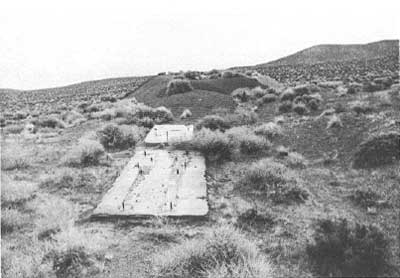 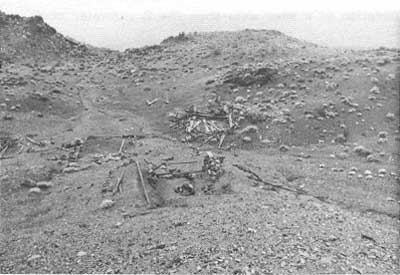
|
| Illustrations 212-213. Top: Concrete hoist foundations, dump and shaft of a mine near Greenwater Spring, typical of the many mining remains in the Greenwater District. Bottom: Scattered debris, dumps and a shaft mark the location of the "Coffin" Mine. 1978 photos by John Latschar. |
All in all, therefore, the physical remains of the Greenwater District are not particularly noteworthy in their own regard, and, unfortunately, the best remains of early twentieth-century ruins are on Bureau of Land Management holdings. Nevertheless, the sheer history of the area, even when totally unsupported by historic structures, together with its historical archaeological values, are enough to warrant nomination to the National Register as a Historic District. Greenwater experienced one of the most violent and short-lived mining booms of any mining camp in the western United States, and the total human effort invested in its mines, coupled with the total lack of success, has never been equaled. For a few short years, Greenwater was a name familiar to stock brokers and mining investors from New York to San Francisco--a name first loved, then despised. Its site deserves recognition, protection and interpretation.
3. Greenwater District Mines
a. Mines and Mining in Greenwater
During the short and spectacular Greenwater boom, fully seventy-three mining companies were incorporated within the district, and literally scores of smaller mines and prospects were opened Papers have been located for thirty-three of the companies which did incorporate, which show their combined capitalization value to be over $76,000,000. Although the exact capitalization totals of the other forty incorporated companies cannot be determined, the minimum standard capitalization for the time period was $1,000,000 per company, which would give us a total capitalization value of the Greenwater district mines of over $116,000,000. This total, of course, in no way reflects the actual amount of money spent in the district, but it does give some idea of the amazingly vast amounts which investors and promoters hoped to reap from the rich copper ores of Greenwater.
But as we know, the district turned out to be a complete bust, with no ore of consequence ever being mined. None of the seventy-three companies ever entered the production stage of mining, but this is not to say that none of the companies were profitable. Many of the companies which were incorporated for business in Greenwater never actually did any mining at all, nor ever intended to. Indeed, as the Death Valley Chuck-Walla pointed out in several cases, quite a few of the companies did hope to mine the pockets of their gullible investors. The scheme was relatively simple and was quite easy to pull off during the giddy days of the Greenwater boom, for few if any investors in New York or San Francisco could hope to determine which companies were serious and which were fakes. All an unscrupulous operator had to do was incorporate a company with a Greenwater-like name, advertise it as being in the heart of the district or near a well-known mine, and collect the money which started to pour in for stock subscriptions.
The stock, of course, was worthless, since the company either had no and or no intention of mining, but the promoters would have collected their profits and departed the scene long before this fact became evident.
That this scheme was played over and over again in Greenwater is quite apparent, given the fact that thirty of the mines which were incorporated in that district never did any work at all. Undoubtedly, the great majority of these companies were much more interested in mining the pockets of investors than in mining the ground. In the long run these were the only mining companies who made a profit of the Greenwater boom, for no one who invested the stockholders funds in actual mining efforts made any money. Nor should we feel too sorry for the investors. Anyone caught up in a boom spirit such as prevailed in Greenwater cannot be pitied for having his dreams fail, for greed was the primary consideration of investors) just as it was for mining promoters. Indeed, investors lost no more money in fraudulent mining schemes than in honest ones, since Greenwater had no productive ores.
But, of course, not all the Greenwater mines were fakes. Most of the companies did make an honest search for ore, and several, particularly the Greenwater Death Valley Copper Company and the Furnace Creek Copper Company, continued that search long beyond the bounds of reasonable doubt. All in all, however, the infant mortality rate for Greenwater mines was shockingly high. Fifty-two of the seventy-three companies did not last longer than six months, and only five companies were in operation longer than one year. The average life expectancy for a Greenwater mining corporation was a dismal four months and three weeks. Since it would be a lengthy task to even outline the histories of these seventy-three companies, representative samples are given instead. Included are the stories of the two major companies in Greenwater, that of a typical company which lasted a brief five months, and that of an outright fraud.
INCORPORATED MINING COMPANIES, GREENWATER DISTRICT
| Name | Date First Mentioned | Date Last Mentioned |
| Furnace Creek Copper Company | 23 June 1905 | 17 March 1909 |
| Furnace Creek Gold Mining Company | 8 September 1905 | 8 September 1905 |
| Greenwater Consolidated Copper Co. | 4 May 1906 | 10 April 1909 |
| Funeral Range Copper Company | 4 May 1906 | 29 March 1907 |
| Greenwater Copper Mining Company | 1 July 1906 | 1 May 1907 |
| Furnace Creek South Extension Mining Company | 3 August 1906 | 1 May 1907 |
| **Greenwater Death Valley Copper Co. | 10 August 1906 | 1 September 1909 |
| Butte & Furnace Creek Copper Mining Company | 17 August 1906 | 17 August 1906 |
| Greenwater Monitor Copper Company | 17 August 1906 | 17 August 1906 |
| Greenwater Calumet Copper Company | 27 August 1906 | 10 March 1909 |
| Clark Copper Company | 7 September 1906 | 1 May 1907 |
| Greenwater Black Jack Copper Mining Company | 11 September 1906 | 1 May 1907 |
| Greenwater Furnace Creek Copper Co. | 15 September 1906 | 15 April 1907 |
| Furnace Creek Consolidated Copper Co. | 17 September 1906 | 1 May 1907 |
| Furnace Creek Extension Copper Mining Company | 21 September 1906 | 15 April 1907 |
| Greenwater Red Boy Copper Mining Company | 28 September 1906 | 24 October 1907 |
| Butte & Greenwater Copper Company | 12 October 1906 | 1 June 1907 |
| Greenwater Hercules Copper Company | 12 October 1906 | 12 October 1906 |
| Greenwater United Copper Company | 12 October 1906 | 12 October 1906 |
| Anaconda Consolidated Copper Company of Greenwater | 12 October 1906 | 12 October 1906 |
| *Boston-Greenwater Copper Company | 12 October 1906 | 12 October 1906 |
| Pittsburgh-Greenwater Copper Company | 18 October 1906 | 1 June 1907 |
| Greenwater Saratoga Copper Company | 19 October 1906 | 24 October 1907 |
| Furnace Valley Copper Company | 19 October 1906 | 1 April 1907 |
| Greenwater Rambler Copper Company | 23 October 1906 | 23 October 1906 |
| Butte Funeral Range Copper Company | 23 October 1906 | 1 January 1907 |
| **United Greenwater Copper Company | 23 October 1906 | 30 December 1908 |
| Greenwater Copper Company | 23 October 1906 | 9 February 1907 |
| Salt Lake & Greenwater Copper Co. | 26 October 1906 | 26 October 1906 |
| Kunze Consolidated Copper Company | 27 October 1906 | 15 February 1907 |
| **Ironclad Greenwater Copper Company | 3 November 1906 | 24 October 1907 |
| Funeral Range Copper Extension Mining Company | 6 November 1906 | 6 November 1906 |
| Greenwater-Furnace Creek Consolidated Copper Company | 6 November 1906 | 6 November 1906 |
| Greenwater Townsite Copper Company | 15 November 1906 | 15 November 1906 |
| Kempland Copper Company | 16 November 1906 | 1 May 1907 |
| South Greenwater Copper Company | 17 November 1906 | 29 June 1907 |
| New York Greenwater Copper Company | 20 November 1906 | 20 November 1906 |
| Original Greenwater Copper & Gold Mining Company | 22 November 1906 | 22 November 1906 |
| Greenwater Bonanza Copper Company | 24 November 1906 | 24 November 1906 |
| Greenwater Iron Mountain Copper Co. | 30 November 1906 | 30 November 1906 |
| Ramsey Consolidated Copper Company | 30 November 1906 | 15 March 1907 |
| North Greenwater Copper Company | 10 December 1906 | 10 December 1906 |
| Greenwater Consolidated Copper Company of Funeral Range | 11 December 1906 | 11 December 1906 |
| Greenwater Pay Copper Company | 15 December 1906 | 1 May 1907 |
| Consolidated Greenwater Copper Mining Company | 15 December 1906 | 1 June 1907 |
| Greenwater Apache Mining Company | 15 December 1906 | 15 December 1906 |
| Greenwater Death Valley Copper Mines & Smelting Company (The $25,000,000 holding co.) | 15 December 1906 | 1 September 1909 |
| Death Valley Copper Glance Mining Company | 17 December 1906 | 17 December 1906 |
| Greenwater Salt Lake Copper Company | 28 December 1906 | 25 January 1907 |
| Greenwater Thrifty Copper Company (undated incorporation paper in 1906, never mentioned again) | 1906 | 1906 |
| Montana-Furnace Creek Copper Company | 1 January 1907 | 1 May 1907 |
| Greenwater Ibex Copper & Gold Mining Company | 4 January 1907 | 4 January 1907 |
| Greenwater Central Copper Company | 5 January 1907 | 18 February 1909 |
| **Greenwater El Capitan Copper Company | 1 February 1907 | 24 October 1907 |
| East Greenwater Copper Company | 15 February 1907 | 10 March 1909 |
| *Greenwater Death Valley Copper Mining Company | 15 February 1907 | 15 February 1907 |
| Greenwater Bonanza Copper Company | 24 November 1906 | 24 November 1906 |
| Greenwater Iron Mountain Copper Co. | 30 November 1906 | 30 November 1906 |
| Ramsey Consolidated Copper Company | 30 November 1906 | 15 March 1907 |
| North Greenwater Copper Company | 10 December 1906 | 10 December 1906 |
| Greenwater Consolidated Copper Company of Funeral Range | 11 December 1906 | 11 December 1906 |
| Greenwater Pay Copper Company | 15 December 1906 | 1 May 1907 |
| Consolidated Greenwater Copper Mining Company | 15 December 1906 | 1 June 1907 |
| Greenwater Apache Mining Company | 15 December 1906 | 15 December 1906 |
| Greenwater Death Valley Copper Mines & Smelting Company (The $25,000,000 holding co.) | 15 December 1906 | 1 September 1909 |
| Death Valley Copper Glance Mining Company | 17 December 1906 | 17 December 1906 |
| Greenwater Salt Lake Copper Company | 28 December 1906 | 25 January 1907 |
| Greenwater Thrifty Copper Company (undated incorporation paper in 1906, never mentioned again) | 1906 | 1906 |
| Montana-Furnace Creek Copper Company | 1 January 1907 | 1 May 1907 |
| Greenwater Ibex Copper & Gold Mining Company | 4 January 1907 | 4 January 1907 |
| Greenwater Central Copper Company | 5 January 1907 | 18 February 1909 |
| **Greenwater El Capitan Copper Company | 1 February 1907 | 24 October 1907 |
| East Greenwater Copper Company | 15 February 1907 | 10 March 1909 |
| *Greenwater Death Valley Copper Mining Company | 15 February 1907 | 15 February 1907 |
| *Greenwater Consolidated Mining Co. | 15 February 1907 | 15 February 1907 |
| Consolidated Greenwater Copper Mining Company | 15 February 1907 | 1 June 1907 |
| Copper Oxide Company | 15 February 1907 | 15 February 1907 |
| Copper Sulphide Company | 15 February 1907 | 15 April 1907 |
| Furnace Creek Copper Oxide Company | 15 February 1907 | 1 April 1907 |
| Gladstone Greenwater Copper Development Company | 15 February 1907 | 15 April 1907 |
| Greenwater Bimetallic Copper Company | 15 February 1907 | 29 March 1907 |
| Greenwater Copper Helmet Company | 15 February 1907 | 15 April 1907 |
| Greenwater Ely Consolidated Copper Company | 15 February 1907 | 15 February 1907 |
| Greenwater Superior Copper Mining Company | 15 February 1907 | 15 February 1907 |
| Greenwater Furnace Valley Copper Company | 15 February 1907 | 1 April 1907 |
| Greenwater Vindicator Copper Mining Company | 1 March 1907 | 1 June 1907 |
| Greenwater Chuck-Walla Copper Co. | 15 March 1907 | 1 May 1907 |
| Kingston Range Copper Mines Corporation | 15 March 1907 | 15 March 1907 |
| Salt Lake & Furnace Creek Copper Company | 29 March 1907 | 29 March 1907 |
| Greenwater Copper King Company | 15 April 1907 | 1 May 1907 |
| Kentucky Copper Mining Company | 1 May 1907 | 1 May 1907 |
* - Companies exposed by the Death Valley Chuck-Walla as frauds.
** - Companies included in the Greenwater Death Valley Copper Mines & Smelting Company merger.
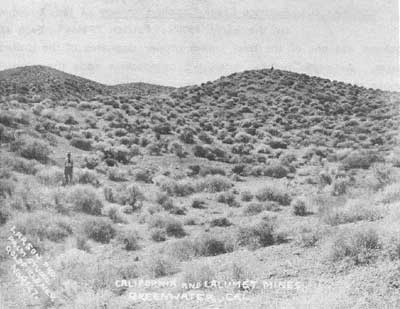
|
| Illustration 214. The inscription on this 1906 photo simply reads "California and Calumet Mines, Greenwater, Cal." and amply portrays the holdings and improvements of a typical mine during the Greenwater boom--nothing. Photo courtesy Nevada Historical Society. |
b. Furnace Creek Copper Company
In the early 1900's, Patrick Patsy Clark of Spokane was one of the best known copper magnates of the United States. As noted before, when two prospectors made their initial copper discoveries in Greenwater, they immediately notified Clark's agents, and Clark became interested in the new district. In May of 1905, Clark visited the virgin Greenwater territory and purchased the claims. By the middle of the next month, he had already opened up a mine, and by the end of June had eight men working in a shaft which was thirty-five feet deep. Clark was the first major operator in the district, and hoped to reap a quick fortune by finding the immense underground copper deposits from which came the rich surface croppings of Greenwater.
By March of 1906, although the copper lode had not been found, Clark had decided that the indications on the ground warranted permanent and extensive exploration and development, and his young mine was upgraded into a mining camp by the arrival of tents, camp supplies, working tools, etc. By this time his working force had been expanded slightly to nine, and the shaft was sixty feet deep. The Greenwater rush was now starting in earnest and numerous prospectors and rival promoters were on the ground. Taking advantage of the initial wave of excitement which was sweeping the mining world, Clark incorporated his company in March, and named it the Furnace Creek Copper Company. The company was formed with a capital stock of$1,250,000 and shares in the company were put on the market at 50¢ each, one half of their par value. Clark offered 125,000 of these shares to the general public, in order to build up development capital, and within three hours every share had been sold. The Mining, World explained the phenomenon by noting that "Mr. Clark's success as a mining operator has been so great, and Butte as well as Spokane people have such confidence in any property that he backs, that they eagerly purchase what stock he has to offer.
With the success of his capitalization, Clark stepped up work at the mine, and by mid-April had fourteen men employed and was sinking two shafts, down to fifty and one hundred feet, respectively. Arrangements were made to purchase a small 15-horsepower gas hoist to speed up the work, and by mid-May, the new hoist had arrived and was installed. By this time, with the Greenwater boom well under way, prices of Furnace Creek Copper, the earliest and best-known mine in the district, were leaping through the roof. One bold investor in New York city purchased an entire block of 100,000 shares at the price of $3.25; 1,500 more were sold in the same city for $4.25 per share; and the price at Los Angeles went even higher to $4.50. These were totally unheard-of prices for stock in a company which had yet to extract or ship a single pound of ore.
With the money roiling in, Clark discarded his 15-horse power hoist and replaced it with a larger 40-horse power model, which would enable him to sink to a depth of nearly 1,000 feet. Clark also began buying up adjacent claims and had soon extended his company's control to an area of approximately 400 acres. Both the Tonopah & Tidewater and the Las Vegas & Tonopah Railroads offered to build a spur line to his mire, upon request, and Clark mentioned that he was considering the construction of a 300-ton smelter. But for the time being, these ambitious plans were laid aside until the copper body could be proven. The staff was expanded to sixteen miners, and the shafts went deeper and deeper) reaching the 150-foot point in mid-July. The Bullfrog Miner, suitably impressed by the rapid development of the company, commented in July that the "Furnace Creek Copper company, owned by Patsy Clark, is developing into one of the biggest things of its age known in copper mining."
During the summer of 1906, small pockets of high grade ore were occasionally found in Clark's mine, but no bodies large enough to mine commercially. Still, it was much too soon to expect much, and development continued. By mid-August, the shaft was down to 220 feet, and three shifts were working around the clock in the mine. The shaft had been sunk to 265 feet by early September, the work force increased to eighteen men, and another large hoist was procured. By this time, stock in Clark's company had leveled off somewhat, and was being sold and traded at a steady $4 per share, tour times its par value.
But as the Greenwater boom reached its most violent phase in the fall of 1906, there was no holding down the price of stock, regardless of the lack of any ore yet produced. Furnace Creek Copper stock rose to $4.50 in late September and then up to $5 and $5.25 per share by mid-October. Some of this flurry was caused by prevalent rumors of a consolidation between Clark and his chief competitor in the district, Charles Schwab, but even after that rumor proved false, stock prices remained unrealistically high.
In mid-October, excitement prevailed at the company's headquarters, as copper ore was struck in a crosscut from the 200-foot level of the main shaft. Development was spurred by the discovery, and by the middle of November, in addition to the numerous crosscuts and drifts which the company was sending out from the 100 and 200-foot levels of its shafts, the main working shaft was still going deeper. By the end of 1906, the company had two large hoists working on its shafts, the main one of which was down to 385 Feet, and forty men were employed by the firm. No ore had yet been found, but the company was in tremendous financial shape, and there was plenty of time for development work.
Almost as an afterthought, Clark also entered the townsite business late in 1906, due more to public pressure than desire. Since supplies and accommodations throughout the district were in such shortage at the peak of the boom, miners and prospectors naturally flocked towards Clark's camp, where stores had been established to cater to the needs of the miners he employed. Realizing that the only way to control his camp in the face of the unwanted crowds was to organize a townsite, whether he wanted one or not, Clark entered the townsite battle in October. Shortly thereafter a townsite company was incorporated and by December advertisements were printed in the Rhyolite newspapers, advertising losts for sale from between $250 and $750 apiece. [12]
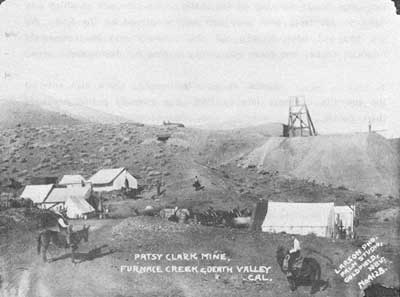
|
| Illustration 215. View of the workings of the Furnace Creek Copper Company, ca. December 1906. The rude collection of tents soon afterwards grew into the mining camp of Furnace, which was later moved down the valley when it began to interfer with mining operations. Note the pile of shaft timbers to the left of the hoist, and the water wagon in the center. Photo courtesy Nevada Historical Society. |
As 1907 opened, the Death Valley Chuck-Walla reported that Patsy Clark had one shaft down to 300 feet in depth, and others were on the way. In addition, the young townsite of Furnace (sometimes called Clark) was bustling with a store, a restaurant, a hotel and other business firms, and a Post Office had been applied for. Sinking continued rapidly during that month, since the cold weather forced companies working near the surface to shut down, end Clark for once was able to hire all the miners he needed. By the middle of the month the main shaft had broken the 400-foot level. When the growing townsite threatened to interfere with the operation of the mines, it was bodily moved away from the main shaft down the slope to the north, and replatted there. Town lots began to command a premium, especially since the consolidation of Kunze's and Ramsey's townsites made Furnace the only reasonable place to live for miners employed by Clark and other nearby companies. As development continued, and the problem of obtaining supplies for the mine and townsite grew, a road was surveyed to the site, in order to ease deliveries.
During February, work continued on the main shaft, although several other exploratory shafts and cuts were being run. By the middle of that month the main shaft had been sunk to 480 feet, another crosscut was started at the 250-foot level, and the growing town of Furnace counted a population of 500. By March 1st, with the shaft at the 500-foot level, new crosscuts were started and ore was discovered. Although the copper deposits uncovered were not large enought to crow about, they were large enough to mine, and the Furnace Creek Copper Company began sacking its best ore for shipment to the smelter. To get there, the ore had to be hauled over fifty miles across the sandy desert to the Las Vegas & Tonopah station at Amargosa.
By mid-March, the company was still stoping ore for shipment, and the shaft had been continued below the 500-foot level. Only ore which averaged above 12 percent copper, a very high figure, could be profitably shipped. At the end of that month, the company was still assembling a shipment, which indicates that it did not have a great abundance of 12 percent ore. Nevertheless, with the main shaft down to 550 feet, the Death Valley Chuck-Walla felt justified in calling the Furnace Creek Copper Company the very best mine in the entire Greenwater District.
Sometime in April, the first shipment of ore was sent out, which represented the first shipment from the Greenwater District. The shaft was now down to 600 feet, and the Bullfrog Miner reported that 150 men were working in the vicinity of Furnace, most of them for the Furnace Creek Copper Company. In mid-May, the company was still shipping ore, but no returns were received from the smelter until late in that month. Those returns showed that one carload of hand-sorted ore sent cut contained 22.58 percent copper, which was of profitable level, but two other carloads (of approximately twenty tons each) had not yet been heard from.
Despite these shipments, which represented the closest anyone in the Greenwater District had yet come to becoming a real producing mine, the Death Valley Chuck-Walla noted on June 1st that the Furnace Creek Copper Company was not looking good. Formerly one of the best in the district, it was now running out of development funds, in the Chuck-Walla's assessment, and for some reason it had taken its biggest hoist off the main shaft and replaced it with a rather useless 5-horsepower hoist. That hoist could have no hope whatever of raising rock over 600 feet from the bottom of the shaft The magazines' presentments were correct, for shortly after that the mine shut down. The management implied that the shut-down was to avoid the extremely hot weather of the summer months in Greenwater, but everyone knew better, and no one was particularly surprised when the mines were not immediately reopened in the fall.
The company definitely had problems, for it had expended enormous sums in fruitless development work, and now it faced the problem of whether to give up completely, or to continue to look for the elusive green ore. At the annual meeting, held in early October, some of the problems were ironed out, and a picture of the company's financial condition emerged. According to the Bullfrog Miner, the company had experienced some "internal difficulties" which meant that the directors were undecided as to who to blame for past failures. These difficulties are easy to understand when it is pointed out that stock prices in the company had slipped over $4 in less than a year. Stock which was eagerly sought for over $5 less than one year ago had slumped all the way to 20¢ per share by the end of October, 1907. Although the decline of the Greenwater boom and the Panic of 1907 were contributing factors, still the basic reason for the stock slump was the essential fact that after spending thousands of dollars on development work, the company had no ore to mine for future profits.
An analysis of the balance sheets showed that $135,303 had been spent in such work in the past year, including $59,250 for labor and supplies, $1,857 for legal expenses, $4,927 for machinery and plant, $4,409 for buildings and fixtures, $5,181 for surveys and patents, and $9,000 for stable expenses, chiefly water. Exactly 228,600 shares of treasury stock had already been sold, bringing in $131,687. Receipts from ore shipments totaled $2,625.09, and money value of equipment and supplies on hand was placed at $20,536, including timbers, mine and boarding house supplies, gas hoists, wagons, teams, tanks, and office buildings. Over 2,800 feet of work had been done, including eleven shafts totaling 850 feet, one crosscut of 764 feet, six drifts of 652 feet and nine surface cuts of 332 feet, two stopes of 30 feet and one tunnel of 161 feet.
But what really mattered was that the company had only 21,400 shares of treasury stock left to sell, which would raise only $4,280 at present prices. This, coupled with 50,000 shares of personal stock donated to the company by Clark for development purposes and $16,110 remaining in the company's treasury, meant that the Furnace Creek Copper company had left no more than $30,390 to spend in the search for ore. Nevertheless, the company hired eight men and resumed work, announcing that the shaft would be sunk to the 1000-foot level before giving up. With the revival of work, which continued through the rest of 1907, Furnace Creek Copper stock rebounded somewhat, and closed out the year at 25¢ per share. [13]
As the first months of 1908 passed, the Furnace Creek Copper Company continued to work with a "good force of men," as the Clarks were determined to either prove their holdings immensely valuable or demonstrate the utter failure of the property as a producer." Early in March a new 60-horsepower hoisting plant arrived and was installed, and by the beginning of April the main shaft was approaching the 800-toot level. Sinking and lateral exploration continued through April, May and June, and occasional small pockets of copper ore were found. Although all these pockets soon pinched out, the presence of some ore at these depths was just enough to keep the company's hopes alive, and it confirmed that the shaft would he sunk to 1000 feet in depth before giving up.
Work continued through the summer, although the work farce was not large enough for very rapid progress to be made. As August approached, the best assessment of the company was that the development results were encouraging, "but nothing out of the ordinary has been reached." Still the company continued to sink, and steady progress was reported through the fall of 1908, but still without finding any commercial ore bodies.
As 1908 turned into 1909, the work at the Furnace Creek Copper Company became slower and slower, and the company began giving up hope. Finally, in mid-March of 1909, the mine was closed. The Rhyolite Herald sadly announced that the company had "finally given up hope of developing satisfactory ore bodies without going to great depth" and after several years of effort, "work was entirely suspended a few weeks ago." Miners were discharged and soon even the watchman was given his notice. The elusive ore body, which had been followed sporadically down to 200 feet below the surface, had been completely lost at that point, and although the shaft had been sunk below 800 feet, no more ore had been found.
For a few months, the Furnace Creek Copper Company, held on to its property, waiting to see what would happen to the Greenwater Death Valley Copper Company's property, whose shaft was below 1,000 feet and still sinking. If that shaft hit the copper ore which everyone in Greenwater had been looking for, there was a possibility that the Furnace Creek Company would be able to resume operations. But such did not come to pass, and the Furnace Creek Copper Mines were abandoned. The entire collection of claims belonging to the company was allowed to lapse, and reverted to county land status in June of 1910, when the company failed to pay $10.51 in Inyo County taxes. [14]
c. Greenwater Death Valley Copper Company
The other major mine in the Greenwater district, the Greenwater Death Valley Copper Company, was also owned and operated by one of the great business magnates of the early twentieth century, Charles Schwab. After making his fortune in steel, Schwab had been attracted to the gold fields of Nevada following the Tonopah and Goldfield booms, and, as we have seen, dabbled constantly in mines in and around the Bullfrog area. When the Greenwater rush began, Schwab, like most major operators in the area, rushed to the site in order to capitalize on what seemed to be the biggest boom of them all.
Schwabs activities are hard to follow during the early days of the boom, since he had several agents in and around the mining towns of Death Valley who bought and sold mining properties on his behalf. For a short time in early 1906, Schwab held an interest in the Funeral Range Copper Company, but it was shortly sold, apparently because he was unable to gain outright control of the company. In July of 1906, Schwab began buying up mining claims in his own right. Schwab paid $180,000 to Arthur Kunze and his partners for a group of sixteen claims, and on August 10, 1906, the Greenwater Death Valley Copper Company was incorporated. The capitalization was for $3,000,000, one of the largest capitalizations in the district, and Schwab retained majority control of the company, even though his name does not appear as a member of the board of directors. The company by this time held title to 300 acres of ground, and announced that the installation of mining machinery and the inauguration of an extensive development campaign would soon start.
In addition to its mineral holdings in Greenwater, the Schwab company also owned water rights at Ash Meadows, and preliminary plans were announced to install a pumping and power station in that vicinity. Lumber and supplies began to flow into the company's property at Greenwater and work began. According to the usual procedure a limited amount of Greenwater Death Valley Copper Company stock was offered for sale in Rhyolite and other mining towns of the west, and by the end of August, the main shaft of the mine was down to 100 feet in depth, and work was started on two other shafts. The company ordered three gas hoists to facilitate the sinking.
With the organization of a company such as this, with a man of Schwab's reputation behind it, the local newspapers immediately began to follow the progress of the company. The Bullfrog Miner reported in late September that the company was already employing forty miners on its property. In addition, it said, the company had ordered three gas hoists (of 25, 40 and 50-horsepower), which would easily give it the largest hoisting capacity in the district. These first indications of development work were quite promising, and the Inyo Independent reported towards the end of September that the company had "good ore.
Although the Furnace Creek Copper Company was the darling stock of the Greenwater District, Greenwater Death Valley Copper did not do poorly. The attraction of the Schwab name--even though he had never attempted copper mining before--plus the good location and the obvious intent of the company to develop its property extensively, caused the price of its stock to soar upwards, until it was selling for $2 per share in late September, twice its par value. By the end of that month, the three new hoists had arrived at the mine and were being placed above their shafts, two of which were already below the 100-toot level.
The company added a few more claims to its property list in early October, and spurred by this and other mysterious activities, the newspapers soon picked up the smell of something big. Since the biggest thing they could imagine would be a combination of Clark's and Schwab's mines--the two largest in the district--incessant rumors circulated of a merger between the two powerful operators. The rumors caused especially heavy trading of the stocks of both companies in Boston and New York, and the rumors became so proliferant that the papers began to believe themselves. The Inyo Independent reported in mid-October that the merger between the companies was practically final, since the main points affecting it had been settled between Clark and Schwab. When another month passed, however, without any merger announcements, the Bullfrog Miner revised its estimate and reported that difficulties had arisen, which had delayed the consolidation.
In the meantime, the Greenwater Death Valley Copper Company was working hard, and early in November began taking shipping ore out of one of its shafts. By this time the company had two of its shafts below 100 feet, a third below 50 feet, and had built two comfortable frame offices on its property. Work continued through the rest of 1906, and by early December the two deeper shafts were at the 200-level, and the Greenwater Death Valley Copper company had emerged as one of the largest operations in the district.
Then, on December 15th, the long-anticipated merger took place. Unfortunately, the papers had been speculating about the wrong companies, however, for the Furnace Creek Copper Company had no part in the merger. Instead, a consolidation was announced, of the Greenwater Death Valley Copper, the United Greenwater Copper and several unincorporated mines owned by John Brock and some Philadelphia financiers.
The new merger company was named the Greenwater Death Valley Copper Mines and Smelting Company, and had a capitalization of $25,000,000, with five million shares worth $5 each. It was easily the largest incorporation that the Death Valley region had ever seen. The new company was a holding corporation, and as such bought up the controlling interests in the companies it took over. The stock distribution in the new company was based upon the amount of stock which had been sold in the older companies, and 68 percent of the merger company's stock went to buy out the Greenwater Death Valley Copper Company, 18 percent to the United Greenwater, and the rest to the owners of the unincorporated mines. Charles Schwab, it was definitely pointed out, was in control of the holding company, and plans were announced for the erection of a smelter at Ash Meadows, where the Greenwater Death Valley Copper Company already had water rights. In addition, the holding company announced that it would build a railroad from the smelter site to the Greenwater mines. A smelting expert was hired for $25,000 per year to supervise the selection of the construction site and the construction of the plant, and hopes were raised that the smelter would be running within a year.
Under the management arrangement of the holding company, however, the subsidiary companies under its control would continue to work on their own, retaining their names, identities and management--subject, of course, to the approval of Schwab and the parent company. Thus the mines continued to explore and develop their own deposits, and the holding company was used for a pooling of resources and capital, which would be necessary in order to finance the capital expenditures which were proposed. [15]
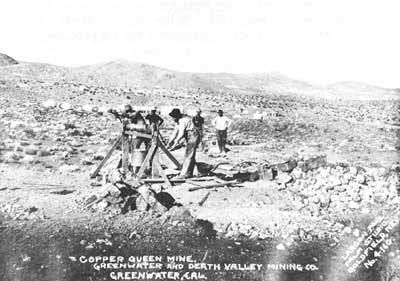
|
| Illustration 216. an early view of the Copper Queen shaft of the Greenwater Death Valley Copper Company, ca. December 1906. This was the shaft which was ultimately sunk to the depth of over 1400 feet. In this view, however, work has barely startd, and the miners are still using a crude hand whim to raise the rock to the surface. The young town of Kunze may be seen in the background. Photo courtesy Nevada Historical Society. |
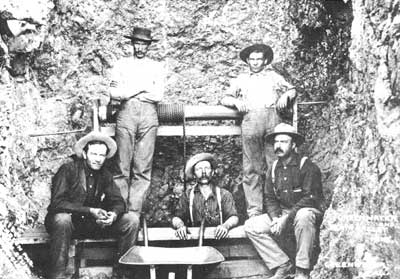
|
| Illustration 217. Another view of the same shaft, this one taken below ground, where an intermediate hand whim was being used. The man sitting at the right, with suspenders, notebook and pen in pocket, is undoubtedly the mine superintendent. He may also be seen in the background in the preceeding picture. Photo courtesy Nevada Historical Society. |
Under the impetus of the new merger arrangements, and with the Greenwater boom at its very peak, the Greenwater Death Valley Copper Company opened 1907 in impressive style, increasing its work force to nearly fifty men! Two more gas hoists were added to the property, bringing the total to five hoists pumping away over five separate shafts. Four of the shafts were over 100 feet in depth, and the deepest one had reached 125 feet. By early February the holding company announced that construction plans were completed for its smelter, which would cost $1,500,000 to build, and reaffirmed that a rail line would be constructed between the smelter site and the mines. The Death Valley Chuck-Walla reported that the Greenwater Death Valley Copper Company had itself spent over $100,000 since starting work in August of 1906, and now had all five shafts down past the 100-foot point. Labor costs alone were running the company $10,000 a month to pursue its vigorous campaign. The deepest shaft was now down to 140 feet, and an air compressor had been ordered to force air down to the men working below ground.
Early in March the Greenwater Death Valley Copper Mines & Smelting Company added more mines to its holdings, including those of the Greenwater El Capitan Copper company. Construction on the smelter was slated to start within sixty days, and survey work for the railroad spur was started. By the middle of that month, the deepest shaft on the Greenwater Death Valley Copper Company's property was near the 300-foot level, and two others were down to 275 and 200 feet. Three shifts were working around the clock, a machine shop had been installed at the central shaft, an assay office was built, and a sawmill was under construction, to facilitate the shaping of timbers for the deep mine shafts.
The rapid exploitation of the company's property continued through April, and the payroll was increased to 75 men. By the 19th of that month the deepest shaft was down 475 feet, and had fairly good copper ore (3%) at the bottom. Sinking kept pace in the other shafts, and towards the end of April, four of the company's five working shafts were below 40:0 feet. As May progressed, crosscuts were run from several of the shafts, as exploratory measures, and by the end of May another small strike was reported at the 485-foot level in one of the shafts. In the meantime the holding company was completing plans for its smelter, and equipment for the, construction of the plant was ordered. The holding company also increased its list of subsidiary mines, until it held title to over 200 claims comprising some 4,000 acres of land. Although the Greenwater Death Valley Copper Company was clearly the leading subsidiary within the umbrella group, sinking and exploration was also carried on in numerous of the company's other mines.
More strikes were made in June, and although none were large enough to turn the mine from development into production, all were encouraging as they gave indications of an immense copper body just a little farther below the surface. The Bullfrog Miner reported towards the end of June that six shafts were working at the Greenwater Death Valley property, the deepest of which was now 500 feet. Miners were still scarce in Greenwater, and since contractors refused to work on crosscuts during the graveyard shift, the company was forced to cut back its operation to two daily shifts. "The success of this mine, which would lead to a smelter being built," concluded the Bullfrog Miner, "is most important for the Greenwater district."
Further strikes of small copper deposits were reported in July, and late in that month, the Greenwater Death Valley Copper Company made a shipment of two carloads (approximately forty tons) of its high-grade ore, which had been taken out of the small strikes during the past months. Following that shipment, the news from the mines decreased, and development slowed down somewhat as Schwab and other operators began to feel the effects of the Panic of 1907. Not until late October was the Greenwater Death Valley Copper Company mentioned again, when it was reported that they had added ten more men to the payroll. By now the Greenwater Death Valley Copper Mines & Smelting Company was employing 100 men in its combined operations, and more than half of them were working directly for Greenwater Death Valley Copper Company.
In November, however, three of that company's shafts were closed, in order to economize on development work, and only three shafts were still in operation. An indication of some past troubles was alluded to in the Bullfrog Miner, when it mentioned that the Schwab property was resuming full-scale work. As the year closed out, developments seemed to be increasing once again, as the company let a contract for 500 feet of sinking in its main shaft. The shift from company work to contract work, though, was a ready indication that the Greenwater Death Valley Copper Company was beginning to feel the financial pinch. [16]
By the beginning of 1908 the Greenwater boom had busted, and the Greenwater Death Valley Copper Company was one of the few still working in the district. Gone were the balmy days when companies were organized for $25,000,000: the Greenwater Death Valley Copper Mines & Smelting Company quietly faded into the background, and no more word of smelter construction or railroad building was heard. Rather, operations were contracted, development was restricted to the most economical means, and the Greenwater Death Valley Copper Company tried to save all its previous investments in a desperate search for ore. Happily, the company still had a fat treasury, due to wise management practices and the constant sale of company stock in previous days when prices had been high.
As the new year opened, the main shaft at the property was approaching the 600-foot level, and progress was steady now that work had been concentrated on one shaft. The company reported in March, after two more months of work, that $125,000 was left in its treasury for further development work, and that its shaft was now 740 feet deep. Another contract was let at this time to sink 100 feet further. By the first of April, the shaft was down to 850 feet, by far the deepest of any in the district, and towards the end of April was approaching the magic 1000-foot level, where all the company's experts had predicted the giant copper body would be found As May ended, the shaft was down to 940 feet, and Superintendent Jerry O'Rourke optimistically told the Rhyolite Herald that "they will make a camp of Greenwater yet."
On June 10th the 1000-foot point was finally reached, and true to prediction, ore was struck. The first assays on the copper body ran 5 to 6 percent copper, but no one could yet estimate how extensive the deposit was. This strike, as noted before, caused a minor rush back into the Greenwater District, as prospectors and companies who had let their titles lapse rushed back in to reclaim them. But within a week, the strike had proven to be no more than a small stringer or ore. Still, no one doubted that the presence of this small stringer indicated that there was a large body of copper within the vicinity, and the strike did prove that Greenwater was "not a surface proposition as has so often been claimed.
The company was still confident that ore was in the ground, and stated in late June that in case ore is not struck in the crosscut which has been started from the 1,000-foot level, that the company will sink another 1,000 feet to demonstrate its theory that a body of copper ore exists in the locality. However, it is believed that the present crosscut will uncover commercial copper when it reaches its objective point." As July progressed, the company pursued that objective, via crosscuts from both the 500 and the 1,000-foot levels, and was apparently satisfied enough with the results of the search to finally apply for a patent to its claims. The application listed a total of thirty claims and thirteen fractions, for a total of over 515 acres.
In the meantime, the crosscuts were continued, and although ore assaying 6 percent copper and eleven ounces of silver, for a total worth of $25 per ton, was discovered in the crosscut from the 500-foot level, nothing of importance was found at the deeper 1,000-foot level. Despite this discouraging result, the company kept working. Time and money, however, were beginning to press the Greenwater Death Valley Copper Company, and the work force was cut back until it was described in late October as a small force of men. Work was resumed in the main shaft in November, and by the end of the year, it had been sunk to nearly 1,100 feet. Small stringers of copper ore were found as the shaft went deeper, but nothing of commercial grade or extent could be found. [17]
After a disappointing 1908, the new year opened on a more promising note for the Greenwater Death Valley Copper Company. The drifts continued to find ore, its quality started to improve somewhat, and the Rhyolite Daily Bulletin reported in early January that "the situation in the Greenwater district is very encouraging." The paper again reported towards the middle of January that the company was bringing up buckets or ore, which was starting to appear in bunches, and "every indication points to a monster vein in the property that should soon be tapped." The Mining World picked up on that report, but cautioned that considerable work remains to be done to demonstrate the extent and value of these finds."
But after years of fruitless searching for ore, it was hard to hold down the elation over finding copper, even though its commercial extent was not yet proven. Early in February the Bullfrog Miner reported that the recent discovery of sixty feet of 5 percent copper ore at the 1000-foot point of the shaft had caused the company to become "highly elated" over the discovery, and to push "developments vigorously." "On the proving of the new ore body," remarked the Bullfrog Miner in an understatement, "depends the future of the Greenwater Death Valley mine and practically of the camp of Greenwater.
Hard on the heels of this discovery came another, as ore was finally found in the crosscut from the 1,000-foot level of the shaft, 200 feet out. This body was soon proven to be forty feet in width, which was stilt not enough to warrant commercial production, but much more than enough to warrant further exploration and development. "The find has caused all kinds of excitement around Greenwater," reported the Rhyolite Daily Bulletin, "and all indications point to a big revival in the mining industry." The Bullfrog Miner agreed, and reported that the "camp of Greenwater is on the rise from all indications Parties with holdings there are putting forth more zeal in the development than has been shown for over a year."
With the revival of hopes, the Greenwater Death Valley Copper Mines & Smelting Company, which still held control of the Greenwater Death Valley Copper Company, released its annual report for the year ending December 31, 1908. The holding company had a cash balance of $138,136 at the end of that year, which included $49,099 in the treasury of the United Greenwater Copper Company and $87,136 in the treasury of the Greenwater Death Valley Copper Company. Since the United Greenwater had long ago ceased work, its treasury funds were available for application towards the continuing development work on the Greenwater Death Valley Copper Company's mines. The parent company, it was announced, owned or controlled 96 percent of the capital stock of the Greenwater Death Valley Copper, the United Greenwater Copper, and the El Capitan Copper Mining Company. All but the Greenwater Death Valley Coper Company, however, were idle.
Pushing hard upon its discoveries, that company continued its work through March. By the middle of that month, the main shaft was down to 1,220 feet and was going for 1,500, which was now seen as the point of decision. Fifteen men were employed at the mine. Work was temporarily halted in early April, when Fred Kelly, a 39-year old miner, fell to his death in the shaft of the mine, but was soon continued, and in late April and early May, more small copper bodies were found. By the middle of May, with the shaft approaching the 1,300-foot mark, the future of the mine was still indecisive, for although the "usual indications of copper are present . . . . no commercial ore bodies have been encountered."
The Bullfrog Miner reported at this time that the total treasury of the Greenwater Death Valley Copper Mines & Smelting Company, based upon its earlier annual report, would be sufficient for more than four more years of development work, based upon the average costs of $2,500 per month at the mine. Such an expenditure would be impractical, however, for everyone agreed that if copper was not found by the 1,500-foot depth, the mine would be abandoned, since copper below that level, no matter how rich, would be very expensive to mine. But the Greenwater Death Valley Copper Company and its parent holding company were both in rather good financial shape, and even though ore was not found, the price of stock in both companies began to rise, going from 4¢ to 9¢ per share. The reason for the trading, explained the Rhyolite Herald was the tact that if the company quit work, the remaining treasury funds would be divided among the holders of its outstanding stock, which made that stock worth a few cents per shares. Shareholders, in other words, now hoped that the Greenwater Death Valley Copper Company would either find ore quickly, or else close down quickly and distribute the remaining funds.
On July 24th, it looked like the latter would be the option taken. Work was halted at the mine, for the shaft had reached the 1,400-foot level, and the present hoisting plant at the property did not have the capacity to raise rock from any lower down. The superintendent asked for instructions, giving the company the options of purchasing a new hoist for deeper sinking, of crosscutting from the 1400-foot level, or of shutting down the mine. After some thought the company decided to purchase a larger hoist, and while awaiting its arrival, to crosscut at the bottom of the shaft.
But the crosscutting soon proved futile, and for some reason the company reversed its decision, for the new hoist was never ordered. Work gradually slowed down at the mine, and finally, on September 1st, was halted. The work force was laid off. After sinking to a final depth of 1439 feet below the surface, the deepest shaft in the Death Valley region, the Greenwater Death Valley Copper Company finally gave up its search for copper ore and abandoned its mine. Greenwater was now totally dead, for this was the last company operating in the district. The Inyo Register printed the obituary for both the mine and the district: "With the cessation of all work at the Greenwater Death Valley mine, the once thriving camps of Greenwater and Furnace Creek, California, have been given over to the reign of the coyotes. There is scarcely a man to be found in the entire district, and locally it is considered extremely doubtful that the Schwab company will ever resume work at the mine, which was once pronounced a bonanza." Ironically, with the cessation of work at Greenwater, shares in the Greenwater Death Valley Copper Mines & Smelting Company shot up from 7¢ to 11¢ each, as stockholders anticipated the splitting of the remaining treasury funds.
The stockholders, however, were doomed to disappointment, for the holding company decided to invest the remaining funds in other mining districts rather than dissolve the company, and for the next several years, sporadic reports of the company could be found from gold districts in Nevada and California, where they tried their luck. Unfortunately, the other districts proved no more fruitful than had Greenwater, and the company eventually went broke.
In the meantime, however, the Rhyolite Herald had nothing but praise for the Greenwater Death Valley Copper Company, for in Greenwater it had done all that could be expected and more to try to prove the benefits of the once highly praised district. The management of the company, said the Herald, had always been honest and above board, and reasonable men could have been expected to give up long before they had. No one should he able to complain about the conduct of its business in the Greenwater District.
Shortly after the mine was closed down, contracts were let to haul the machinery and equipment out of the district for use elsewhere, a job which was expected to take five or six weeks. The cannibalization of the Greenwater Death Valley Copper Mine was so complete that the timbers were even stripped from the shafts and brought up for use again elsewhere. The company's property was totally abandoned, and in June of 1910 reverted to county control, when the once mighty Greenwater Death Valley Copper Company failed to pay $10.85 in county taxes on its numerous mining claims in the district. [18]
d. Kempland Copper Company
The two companies discussed above were quite unusual, and they do not represent the average Greenwater District mining company. As noted before the average life of a copper company in Greenwater was limited to slightly less than five months, considerably less than that of either the Furnace Creek Copper Company or the Greenwater Death Valley Copper Company. For the sake of comparison, therefore, a short narrative of the life and death of a more typical copper company should prove instructive. Such is the Kempland Copper Company, which lasted five and a half months from its first mention in the newspapers to its last.
The origin of the Kempland Copper Company is shrouded in mystery, as is most of those which surfaced in Greenwater, and was undoubtedly the result of a series of mining sales, trades, and consolidations of claims. It was first mentioned on November 16, 1906, when the Bullfrog Miner noted in passing that it was located near the Clark Copper Company and the Greenwater Calument Copper Company. It was again mentioned in December 21st, when the Inyo Independent commented that a tunnel was being driven on its property.
The Death Valley Chuck-Walla alluded to the Kempland property on January 1, 1907, writing that it was located near the townsite of Furnace, in close proximity to the mines mentioned above, as well as the big Furnace Creek Copper Company. From this description, and the fact that the Kempland first appeared during the latter days of the height of Greenwater's boom, it is safe to infer that it was a typical risk" operation. In other words, the grounds owned by the Kempland Copper Company were undoubtedly purchased and mined more for their proximity to the Furnace Creek Copper Company's property than for any mineral content or worth of their own. As mentioned before, this was quite a common practice at the time, and was a practice which was responsible for the proliferation of mines around any big strike. We have seen this same phenomonem at work in Bullfrog, and again in the South Bullfrog and Lee-Echo districts.
Although we have no incorporation papers for the Kempland Copper Company, it was undoubtedly capitalized for $1,000,000 with shares worth $1 each par value, since this was the lowest incorporation ever seen in Greenwater. By mid-February, the company had succeeded in selling enough of these shares to start permanent development work, and the Death Valley Chuck-Walla reported that the company was working on a tunnel, and had a large enough work force to warrant the hiring of a superintendent. The company was steadily developing its ground, and had a good showing of ore.
On March 1st, by which time the company's tunnel was in 100 feet, the Death Valley Chuck-Walla noted that it was owned by J. Ross Clark. Clark was also the owner of the Clark Copper Company, which adjoined the Kempland, and was the brother of William Clark, president of the Las Vegas & Tonopah Railroad. The company had ore in its tunnel, said the Chuck-Walla and was making plans to ship it as soon as possible. By the middle of the month, although no ore had been shipped, more progress had been made in the tunnel, which was now 200 feet deep into the side of the hill.
By April 1st, the company looked even better. It now owned twenty-two claims northwest of the townsite of Furnace, and was crosscutting on the ore ledge. Full surface equipment had been installed, the copper ore brought up was giving high assays, and plans were still being made to start shipments in the near future. In summary, the Death Valley Chuck-Walla called the Kempland Copper Company One of the best properties in the district. On April 15th, the company was still working on its claims, but no shipments had been made. Later in that month the Bullfrog Miner reported that the company had a small eight-foot ledge of ore which assayed about 7 percent copper, and on May 1st, the Death Valley Chuck-Walla again reported that the company was at work, and was preparing to ship ore.
But that was the last reference ever made to the Kempland Copper Company. Evidently, work ceased soon after May 1st. What had happened? Although we will never know for certain, the demise of the Kempland undoubtedly paralleled that of many other Greenwater mines. With the great number of mines and mining companies around Greenwater, the competition for the investment dollar was intense, and there were not enough dollars to go around. With a rather limited budget, the average company was able to spend what funds it could raise in exploring the ground for several months. When the funds ran out, with the inevitable failure to find any commercial ore, the mine was simply and quietly shut down, and the miners departed to find work in another of Greenwater's concerns. It had been a good gamble to try to find ore next to the bonanza holdings of the big Furnace Creek Copper Company, but the gamble had failed. The investors were out their money, and the directors their time. With the great number of mines in Greenwater, however, and the relative insignificance of the Kempland Copper Company as compared with the giants of the district, no one particularly cared. The death of the mine was certainly not important enough to warrant mention in the papers. [19]
e. Greenwater Death Valley Copper Mining Company
Readers who think that this mining company has already been discussed should look closely at its name, for therein lies its story. This is a far more interesting company than the Kempland Copper, and is one which really illuminates what the Greenwater mining boom was all about. First organized and advertised in February of 1907, the company immediately came under the suspicions of the editors of the Death Valley Chuck-Walla. The Chuck-Walla, they wrote, has been unable to located the properties of the company, which was promoted by the C. M. Sumner Investment Securities company of Denver--a city which had had over fifty years of practice in all sorts of shady mining maneuvers. The company's claims could not be found anywhere in the Greenwater District, wrote the Chuck-Walla and it evidently hoped that the similarity between its name and that of the Greenwater Death Valley Copper Company, one of Greenwater's finest, would be sufficient to confuse enough investors to make some money on a non-existent mine.
So far, the story is not particularly unusual, for such is the way the mining game was played in the early twentieth-century west. But the Greenwater Death Valley Copper Mining Company would not give up.
It persisted in advertising its advantages, despite its exposure, and even went to the lengths of describing its good copper claims, supposedly located four miles north of Greenwater. The Death Valley Chuck-Walla panned the outfit again and warned its readers that "we cannot find such claims as this company claims exist. We suspect that the concern is doing a wildcat business at the expense of Greenwater's good name and we warn investors to be careful before placing their money into this." As a courtesy and also a warning to others who were thinking of trying to fool potential Greenwater investors, the editors sent a copy of their magazine, including the article damning the company, to its promoters in Denver.The response was amazing. The Sumner investment Company of Denver wrote back to the Death Valley Chuck-Walla admitting that they had never seen their claims, but affirming that they did have two of them, and they were supposed to be good ones. However, they "could not tell where they were, as they themselves did not know. They were seeking information about their property through us," wrote the Chuck-Walla and at the same time "they were advertising stock for sale in their company." Such exposure presented the mining business at its worst, for the Denver company was admittedly advertising stock for sale in a mine which did not exist, on the basis of two copper claims which they had never seen and could not locate.
But the Greenwater Death Valley Copper Mining Company was not one to give up easily, and they again wrote to the Death Valley Chuck-Walla Now in regard to the 'Bronze and 'Midkado' claims in Greenwater we are more anxious to know something about them than you are . . . We will therefore greatly appreciate it f you will inform us of what expense will be attached to having some reputable surveyor go out and see whether he can find these claims and if they are property monumented, etc. The Chuck-Walla was so flabbergasted by this request that it printed it verbatim in its magazine. Few wildcat mining companies had the nerve expressed by the Greenwater Death Valley Copper Mining Company--to ask the editors of the magazine which was exposing it to the world as liars and cheats to help them find their own mine.
Although there is no denouement to this story, for the claims were never located and the mine never existed, it does serve to tell a point. Undoubtedly, even with the wide and unmistakable exposure of this fraud, the promoters of the Greenwater Death Valley Copper Mining Company made money.
Even with the bad publicity, there was enough just in the name of the corporation to fool some of the people some of the time. [20]
f. The Greenwater Boom
As a final note, which is perhaps necessary after reciting the history of the Greenwater Death Valley Copper Mining Company, it should be pointed out that the Greenwater district as a whole was not a fake. Inevitably, considering the rapid rise and fall of the district, which has seldom been paralleled elsewhere, modern writers of western lore have begun to look upon California, they could see booming mining camps. None of these camps had yet reached the peak of their booms when Greenwater started, and as a result the boom spirit of the surrounding territory was at its highest ever. Greenwater, in a sense, was the culmination of that spirit, for only after Greenwater had failed did other camps begin to falter. In short, Greenwater came at a time when all of Nevada was booming, and the times were totally--although unrealistically--optimistic.
In short, there was copper ore at Greenwater. Unfortunately, it did not improve with depth, as it was supposed to have done. The boom at Greenwater eclipsed all others seen before, due to the boom spirit of the times, but it was based upon the contemporary belief that the district held untold richs. Although there were more fraudulent mining companies in Greenwater than in any district we have seen, that was more a result of the unbelievable boom spirit which prevailed throughout the country than of any underlying conspiracy within the district. Greenwater was a real and legitimate mining district, and several companies proved that point beyond all doubt by expending enormous sums of money trying to exploit it. Unfortunately, Greenwater did not have sufficient copper ores to turn it into a producing district.
4. Greenwater Suburbs
Just as the great Bullfrog boom spilled out into the surrounding territory and caused secondary booms at locations such as Skidoo, Echo-Lee and Greenwater, the Greenwater boom also had a ripple effect, and caused several smaller rushes into the surrounding territory. Like Bullfrog, the first mad scramble to the Greenwater area soon filled up all the available ground for miles around the heart of the district, and late-arriving prospectors began to drift farther afield in the search for ore. Several mining districts were thus discovered, such as East Greenwater and South Greenwater, alluded to in previous chapters. In addition, three minor areas within Death Valley National Monument were opened and explored in this fashion, and they will be the subject of this chapter.
a. Willow Creek and Gold Valley
1. History
The Willow Creek and Gold Valley area, located about ten miles south of Greenwater--about fifteen miles by road--was the scene of a Greenwater boom in miniature. Indeed, the story of the mines and settlements in that area is so similar to that of Greenwater, although on a considerably smaller scale, that we need not take too much time to examine it.
Not surprisingly, considering the great problem of water in the Greenwater District, the first mention of Willow Creek is not one of a great mineral location, but the discovery of water. In August of 1906, just as the Greenwater boom was swinging into its height, several prospectors who had wandered down to the south reported the discovery of a good spring of fresh water, which they estimated was capable of supplying three to four thousand people. That news immediately attracted more prospectors to the area, for Willow Creek was one of the few good water sources in the southern Death Valley area. if they were not able to find copper or gold in the vicinity, at least the prospectors would be assured that they would not die of dehydration.
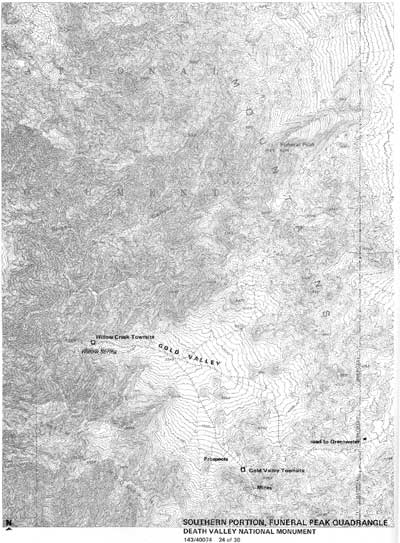
|
| Illustration 218. Map of the Southern portion of the Funeral Peak area. |
With the Greenwater boom at its peak, and a good water source handy, Willow Creek was soon swarming with prospectors, and within a very short time copper was located in the vicinity of the spring. By the end of August, a camp had been established at the spring, and several locations had been staked out. Although most prospectors agreed that Willow Creek's copper was not as good as Greenwater's, still the Bullfrog Miner proclaimed that "Willow Creek Is the Latest."
The boom spirit which had thrust Greenwater to the top in such a short time spilled over into the Willow Creek area, and soon a minor boom was well under way. By the end of September enough prospectors were in the area to warrant the establishment of a freight line from Kingston, the newest station on the Tonopah & Tidewater Railroad. Some of Rhyolite's leading mining promoters had already moved into the new territory, including Senator T. L. Oddie, who secured a fairly large group of copper claims Chet Leavitt, who we have met before in the Lee-Echo District, also moved quickly into Willow Creek. In addition to staking out numerous claims, Leavitt announced the formation of a townsite company, to promote his new town of Copper Basin. Willow Creek's first mining company, the Greenwater Pasadena Copper Mining Company, was incorporated in September and soon had six men working on several of its forty claims. The Bullfrog Miner reported that it "is understood that some very high grade copper ore was uncovered, and that there was quite a rush from Greenwater to the scene of the discovery.
During October of 1906, Oddie started work on his property, and paid $30,000 to extend his holdings. On the 4th of that month, he incorporated the Greenwater Arcturus Copper Company, with a capitalization of $3,000,000. Within a few weeks, Oddie had plenty of competition in the area, as the Greenwater Willow Creek Copper Company was incorporated for $2,000,000 on November 12th, and the Greenwater Baltic Copper Mining Company was incorporated for $1,000,000 on November 14th. A slight idea of the frantic activity which accompanied the opening of this subsidiary area may be gained from noting that one man purchased five copper claims for $25,000, and the Greenwater Baltic obtained its four claims near the headwaters of Willow Creek for the price of $75,000.
The excitement over these new copper strikes and the ensuing rush into the district caused the inevitable battle over townsite locations. On November 16th, the townsite of Willow Creek was organized, near Willow Spring and next to the property of Oddie's Greenwater Arcturus Copper Company.
Surveyors were immediately put to work laying out a pipe line from the spring to the new townsite, and a pump was ordered. The new townsite was promoted by E. E. Mattison, and he placed advertisements in the Rhyolite newspapers, promising prospective citizens an "ample water supply" and telephone and telegraph connections immediately. Lots were put on sale from $150 to $250 each. In this case, the townsite battle was an extremely short one, for with the opening of the Willow Creek townsite, we hear no more of Chet Leavitt's townsite of Copper Basin, which apparently folded overnight. The life of his townsite--if it ever existed on the ground--was so brief that we cannot place its location definitely, although it was not very far away from the new townsite of Willow Creek.
The mild Willow Creek copper boom continued through the rest of 1906, paralleling the Greenwater boom in miniature, On November 30th, the Busch brothers of Rhyolite announced the organization of the Greenwater Amalgamated Copper Company, which had fifteen claims in the district, and sales of other claims continued. One enterprising prospector managed to unload fifteen claims for $30,000 in cash, merely due to their close proximity to Senator Oddie's Greenwater Arcturus properties.
Other claims were bought, sold and traded, and several of the incorporated mining companies, such as the Greenwater Pasadena and the Greenwater Amalgamated Copper, started to work. By the end of 1906, the report that Willow Creek "is going to make a flourishing camp." Already, the young townsite had three stores, two lodging houses and three saloons. [21]
During the winter, the rush into the Willow Creek area subsided, for the initial copper boom was over. The various companies settled down to look for ore, and since it was now obvious that the copper belt in the Willow Creek area was rather small, the amount of prospecting in the vicinity tailed off. The Greenwater Arcturus, Senator Oddie's company, worked steadily through the first several months of 1907, while the other companies worked more sporadically. The Greenwater Amalgamated Copper Company, for example, ceased work after barely a month of operation, and was never heard of again, while the Greenwater Willow Creek Copper Company never even began work at all.
Although the rush to the area had definitely subsided, several more mining companies were organized. The Greenwater Clinton Copper Mining Company, which held eight claims, was incorporated for $1,500,000 on March 1st, and announced that work would start shortly on its property. Interestingly, the Greenwater Clinton also revealed that it had some gold values mixed in with its copper claims. Likewise, on March 8th, the incorporation of the Nevada Greenwater Mining, Milling and Smelting Company was announced. Finally, on March 15th, the incorporation of the Greenwater Guggenheim Copper Company was announced, with a capitalization of $1,500,000--and absolutely no connection to the famous Guggenheim family. The Death Valley Chuck-Walla however, immediately denounced the last company as an outright fraud, since the three claims it claimed to have in Willow Creek did not exist. Unlike other companies we have seen, the Greenwater Guggenheim ceased advertising its non-existent mine shortly after its exposure, and was not heard of again.
By the end of March, with the Greenwater Pasadena, the Greenwater Arcturus, the Greenwater Baltic and the Greenwater Clinton mining companies hard at work, a local resident felt safe in boasting that the Willow Creek section would prove up the richest copper mines around Greenwater." As April passed and May began, the district settled down, with its companies looking for the copper deposits, and Willow Creek looked every bit the picture of a small suburb of Greenwater. Then, on May 10th, the picture suddenly changed, when the Greenwater Baltic Mining Company discovered a high grade silver-lead streak on its property.
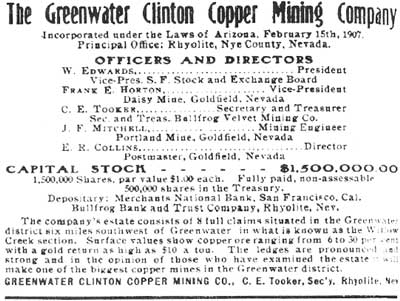
|
| Illustration 219. A typical Willow Creek mining advertisement, from the Death Valley Chuck-Walla, 1 April 1907. |
Copper was one thing, but silver was quite definitely another, and the Willow Creek rush began all over again. Within a week after the strike on the Baltic was announced, the Bullfrog Miner proclaimed that a "Wild Rush Is On to Willow Creek. Numerous new locations were made and several more silver strikes announced, and another wave of prospectors rolled over the country, looking for the silver indications which had previously been ignored in the initial rush for copper ground. The Greenwater Copperhead Company was formed, with silver-lead indications on its claims, and numerous smaller silver mines were opened. The Bullfrog Miner reported that the keenest interest is being shown in Greenwater over the events of the past few days in Willow Creek, and rigs and outfits are now at a premium." To help those rushing into the district, volunteers began working on a wagon road to improve access to the camp. The Willow Creek Townsite Company was ready for another boom, for its plat of Willow Creek had just been approved by the Inyo County Board of Supervisors. The new camp had thirty-one blocks surveyed and marked and just over 300 lots for sale.
As the new rush continued, the Bullfrog Miner wrote in mid-May that WILLOW CREEK STILL ON THE BOOM. THE NEW CAMP 15 ASSUMING CITY PROPORTIONS. Telegraph and telephone lines would be there soon, the paper said, and a water company had been organized to pipe water from Willow Springs up to the townsite. The Tonopah & Tidewater Railroad, taking note of the amount of freight which was now going into the re-booming area, included Willow Creek as one of the freighting points on its new timetable, with teams connecting the townsite with Tecopa Station.
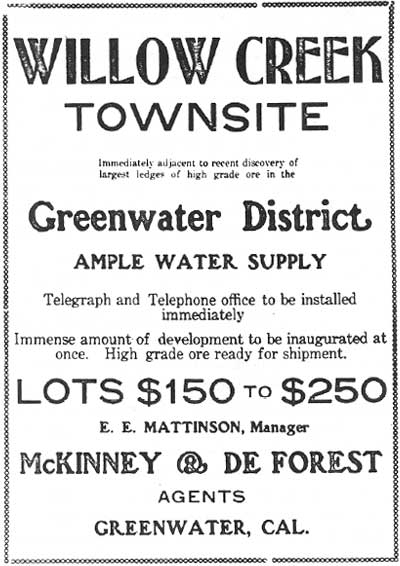
|
| Illustration 220. Advertisement from the Bullfrog Miner, 24 May 1907. |
The new rush also caused the older copper companies of the district to re-evaluate their holdings, and new assays were run on their ore, looking for indications of silver or gold which had been ignored before. By the end of May, with both the new and old companies working, the Willow Creek District looked extremely prosperous and full of promise for the future. The Greenwater Baltic, said the Bullfrog Miner, was the best property in the area, and had gold and silver on its claims, in addition to copper. The Nevada Greenwater looked second best, but its shaft was only down to twenty-seven feet below ground. In addition, the Greenwater Arcturus, the Greenwater Clinton, and the Greenwater Copperhead were all working and looking good. The Arcturus, in particular, was evidently serious about its mining efforts, since it had ordered a 50-horsepower hoist for its property. A petition was being circulated in the area for a new Post Office, and a movement was underfoot to use the pure water of Willow Creek to start a brewery. In summary, although the Bullfrog Miner noted that the Willow Creek excitement was taking many people away from Greenwater, it cautioned that there were "no deep workings in the camp" as of yet, and more time was needed to demonstrate the permanency of the Willow Creek ores.
If nothing else, Willow Creek was definitely an up and down mining area. At the same time that the new gold and silver finds were causing a new rush to the territory, some of the older copper mines were beginning to close down, since the rich surface copper streaks pinched out with depth, just as they did at Greenwater. Thus, the Greenwater Pasadena Copper Mining Company ceased work in late May and the Greenwater Copperhead Company in early June. But the Greenwater Baltic, the Greenwater Arcturus, the Nevada Greenwater and the Greenwater Clinton continued to work, as most of them discovered enough traces of gold or silver on their properties to warrant further development work.
The Willow Creek townsite was also described in mid-summer as looking very prosperous, and was conceeded to be a sure winner, since it "lies in a natural basin and is the one available location in that section to house and home a mining and business population." It was described on June 1st as being a "considerable-sized" community. At the same time, the Greenwater Clinton was called the best mine in the district, but it was being pushed by the Greenwater Baltic. "More miners are wanted at once," for the latter property, said the Bullfrog Miner, "and will be put to work as fast as they can be obtained." [22]
Then, on June 22d, the Willow Creek area suddenly boomed all over again, when Harry Rasmey and O. B. Clover made a surface strike of gold about four miles southeast of Willow Spring. The strike had gold which assayed at $200 per ton, and the Bullfrog Miner predicted that the "discovery will give still another boom to the Willow Creek section . . ." The paper was absolutely right, for once again prospectors and promoters poured into the region to look at the ground around the new strike, and the game was started all over again. Ramsey and Clover claimed--as had many others over the years--to have finally found the "Real and only Breyfogle" mine. Several more gold strikes were made within a short period of time, and suddenly the Willow Creek area was transformed from a copper mining camp to a gold camp. With the new promise of riches, the opinion was soon forthcoming that the Willow Creek area would "undoubtedly distance Greenwater in a short time."
After the dust had settled somewhat, the papers were able to begin to assess the new situation. A new mining company--the Willow Creek Greenwater Copper Mines Company--had been formed, and its bad timing in incorporating a copper company for $2,500,000 when all everyone else cared about was gold is reflected in the fact that it never went to work. The Bullfrog Miner remarked in late July that "Considerable excitement has been caused at Willow Creek by the late strike of gold in paying quantities in the Clover property in that section. Details are lacking at this time, but according to brief communication received the outlook is encouraging. The Inyo Register was not so cautious in its assessment, writing that the "Latest reports from the scene of the new strike in the Willow Creek district, situated in the Funeral Range, about 12 miles south of Greenwater, indicates that the surface showing is the richest ever discovered in this desert region, if not in the world.
WILLOW CREEK & GOLD VALLEY MINING COMPANIES
| Name | Date First Mentioned | Date Last Mentioned |
| Greenwater Pasadena Copper Mining Company | 28 September 1906 | 24 May 1907 |
| Greenwater Arcturus Copper Company | 4 October 1906 | 5 October 1907 |
| Greenwater Willow Creek Copper Company | 12 November 1906 | 12 November 1906 |
| Greenwater Baltic Copper Mining Company | 14 November 1906 | 1 January 1910 |
| Greenwater Amalgamated Copper Company | 30 November 1906 | 21 December 1906 |
| Greenwater Clinton Copper Mining Company | 15 February 1907 | 4 January 1908 |
| Nevada Greenwater Mining, Milling & Smelting Company | 8 March 1907 | 5 October 1907 |
| *Greenwater-Guggenheim Copper Company | 15 March 1907 | 15 March 1907 |
| Greenwater Copperhead Company | 10 May 1907 | 8 June 1907 |
| Willow Creek Greenwater Copper Mines Company | 8 July 1907 | 8 July 1907 |
| Sunset Gold Mining Company | 28 September 1907 | 22 November 1907 |
| Willow Creek Gold Mining Company | 11 October 1907 | 8 July 1908 |
| Willow Creek Combination Mining & Milling Company | 22 November 1907 | 22 November 1907 |
| - denounced as a fraud by the Death Valley Chuck-Walla | ||
Although that seemed a bit premature, the Bullfrog Miner soon joined the band wagon and dropped its caution, headlining that "WILLOW CREEK WILL BE A SECOND GOLDFIELD." The new rush, which soon resulted in numerous small mines being opened up, also reintroduced the townsite battle to the area. Early in April the Goldsworthy brothers, who were responsible for one of the bigger gold strikes, announced the formation of Gold Valley townsite. These brothers did not think small, and when the plat of their townsite was approved by the Inyo County Board of Supervisors, it showed an immense camp of ninety-six blocks, with over 1,200 lots surveyed and ready for sale.
Willow Creek was now definitely booming, and just to prove the point the miners of the area pulled out of Greenwater and organized a district of their own. As August continued, more gold strikes were reported, and two wise prospectors, taking advantage of the new rush fever, sold their gold claims for $50,000. "Willow Creek is going in the near future to make one of the biggest camps in the southern country," stated one operator to the Bullfrog Miner, and the prediction seemed borne cut, when Ramsey and Glover uncovered a pocket of $500 Gold ore at the 17-foot point of their shaft. The rush to the new gold section of the district threatened to entirely eclipse the older copper section, and the Greenwater Arcturus closed down on October 5th, as did the Nevada Greenwater Mining, Milling and Smelting Company. In the meantime, the new gold section was booming and the Gold Valley townsite was described as having a general store and a saloon, with more business slated to come in soon. "According to all reports," said the Bullfrog Miner, "Willow Creek is attracting as much or more attention than any of the other Southern camps. It seems to have set Greenwater in the shade a degree or so, and it is stated that several firms are preparing to move from Greenwater to the new camp."
By the end of that month, it was quite clear that gold had replaced copper in the Willow Creek District, "not because they don't have copper," said the Bullfrog Miner, "but because copper is down to 15¢ a pound and gold is $248 a pound." The paper counted fourteen gold strikes in the district, and noted that most of the miners and prospectors, wary of the boom and bust cycle of the Greenwater mining companies, were attempting to work their properties without outside financing. It was undoubtedly a wise move, for in addition to the Greenwater bust, which was beginning to become quite apparent. the Panic of 1907 was also making itself felt in the western mining regions, and investment dollars for new districts and unproven mines was almost impossible to attract.
Despite these problems, several new gold mining companies were incorporated in the fall of 1907, including the Sunset Gold Mining Company, in late September, the Willow Creek Gold Mining Company (capitalized for $1,000,000) in mid-October and the Willow Creek Combination Mining and Milling Company (capitalization $1,000,000) in late November. The effects of the panic were drastically shown in the case of the latter company, for it was utterly unable to attract investment dollars, and never succeeded in going to work.
But in the meantime, the miners forged ahead with what means they had available, and the new gold district looked good, considering the times. The new town of Gold Valley added a lodging house and a barber shop to its list of businesses in October, and the Bullfrog Miner called it "a considerable mining settlement." Fully half a dozen good-looking gold mines were being opened late that month, and the Miner reported eight new strikes being made in the district. "The surface showings are surely great," the paper continued, "and if they continue Willow Creek will be shipping ore in three months if not sooner." All in all, a local resident confidently predicted "a prosperous winter" for everyone.
Frank Reber, editor of the Greenwater Times stated in early November that only the collapse of the Greenwater District and the effects of the Panic of 1907 kept Willow Creek from really booming. "If it were any other time than now you would see one of the greatest stampedes into Willow in history, but it is hard to interest people the way conditions are at this time." The Bullfrog Miner, early in November, also stated that "No mining camp of recent times has shown so many and such rich ore discoveries as Willow Creek can now show for so short a history." Fully thirty-five gold strikes and twenty or more silver-lead strikes were on record, and a long list of properties were working--although the great majority of them were small one or two-man operations, which would take quite a while to turn into producing mines.
Since the lack of a friendly financial atmosphere kept the great majority of these mines from incorporating and using investors' dollars to develop their properties, the district as a whole turned to the easing system, whereby the owner would rent his property to anyone who was willing to work it, in return for some combination of cash rent or a percentage of the ore taken out of the mine. Leasing work, as compared to the more extensive work which was possible through full-scale development, was slow and tedious, and as the district settled down in the late fall of 1907, there was not much to report. The Rhyolite Daily Bulletin noted in late November that "While the financial depression has affected Willow Creek to a certain extent, the showing is such that work will be continued on a large number of properties." The reversal to older and small-time methods of mining was highlighted by the use of an arrastra in the district, from which some miners were said to be making as much as $50 per day.
Late in December, the Rhyolite Daily Bulletin again assessed the camp, and reported "mining matters very encouraging at that camp, and while quiet at present, in sympathy with the general financial conditions, the district is developing into a good camp." In accordance with the abatement of the rush, and the lack of capital to develop the mines, the new town of Gold Valley was not growing very fast, although it had succeed in eclipsing the townsite of Willow Creek. The Rhyolite Herald reported late in-December that accommodations at Gold Valley were limited to ten or twelve tents, a store and a saloon. But still, more than half a dozen gold mines were still operating, although at a rather slow pace. [23]
As 1908 began, the copper section of Willow Creek, which had been responsible for opening the district originally, was entirely dead, and the only copper companies still operating were those which had subsequently discovered gold or silver on their property. The Greenwater Baltic, for example, was still working its mine, but was looking solely for gold and was no longer interested in copper. The Greenwater Clinton Copper Mining Company, however, which had found traces of gold on its property in addition to its copper, closed down early in January of 1908, as its gold deposits were not sufficient to warrant any further work. In addition to the Baltic, the only other incorporated company at work in the district was the Willow Creek Gold Mining Company, although several non-incorporated mines were still hard at work.
All in all, as the new year started, the district looked about as good as it could, considering the nationwide depression which was following on the heels of the panic. One of the lessees in the district was about ready to begin shipping out his high-grade gold ore, and none of the new gold locations made the previous fall had been allowed to lapse. One of the district's operators stoutly maintained to the Rhyolite Herald in late January that Willow Creek is going to be the banner camp of the section when it gets a little more attention and money. The panic has set it back, but . . . the goods are there." Showings were so good on the property of the Willow Creek Gold Mining Company that its owners began talking about adding a dozen more men to the payroll and of building a 15-stamp mill for the mine.
But development work was necessarily slow, and the Inyo Register was still reporting in mid-February that "If at depth the same values hold as now appear upon the surface and from shallow workings, the coming few months will witness another prosperous camp in the Funeral range . . . Indeed, as February drew to a close, Willow Creek got a shot in the arm from the rapid collapse of its giant neighbor to the north, Greenwater. The Rhyolite Daily Bulletin reported that "what buildings are remaining in Greenwater are being torn down and moved to Gold Valley, the Willow Creek town," and many Greenwater merchants, before giving up entirely on the Death Valley region, decided to give Willow Creek a try. Alkali Bill, for example, who could no longer find passengers for his Death Valley Chug Line, opened service into Gold Valley, although it is doubtful that he was able to find many passengers willing to pay the $100 which he had charged during the glory days of Greenwater. With the influx of Greenwater migrants, Gold Valley experienced some growth, and by the end of March was described as having a population of seventy, with about twenty tent and frame buildings under construction.
With its new prosperity, the citizens of the town applied for a Post Office, and the Gold Valley Mercantile Company finished and moved into its new building. Then, in late May, the event which the district had long awaited took place, when one of the biggest lessees in the district made the first shipment of ore. Although accounts vary, approximately twenty-five tons of ore was shipped out, at an estimated worth of around $300 per ton. But despite this shipment, which gave the first indications that Willow Creek was turning into a producer, the Bullfrog Miner sadly noted that "Very little outside interest . . . is being manifest in the district." But the paper was sure that "when times get better Willow Creek is going to make a noise like velocity."
Unfortunately, however, times did not get better, and following that one shipment of ore, the Willow Creek District started to decline. No more news was heard from the area between July and December of 1908, and the mines began to close down. The Willow Creek Gold Mining Company, for example, ceased operations early in July, and most of the independent operators were forced to follow its example. Once again, the isolation of the Death Valley mining districts was taking its toll, for the expense of mining, transportation and living in a desolate region made the mining of all but the highest grades of ore impractical. The Rhyolite Herald however, was not quite ready to give up on the district, and reported in December that several tons of shipping ore had been taken out of the Greenwater Baltic during the fall of 1908, and that numerous outfits were going back into the district to perform their annual assessment work necessary to retain title to their claims. "Everyone interested seems optimistic regarding the future."
But although most prospectors retained their titles through 1909, and the Greenwater Baltic even performed its annual work in order to retain its property through 1910, the Willow Creek District was dead--the victim of hard times, isolation, and too little ore. Most of the miners left the area during the fall of 1908 and the rest early in 1909. Their spirits were not broken, however, by the failure of one more mining district, as evidenced by Jack Robichau, who left Willow Creek early in January of 1909, on his way to the new boom district in Alberta, Canada. [24]
2. Present Status, Evaluation and Recommendations
Not much is left to picture the short life of the Willow Creek District, for none of the mines were ever developed enough to even warrant the installation of a gas hoist, and neither of the two townsites ever boasted any substantial buildings. The mines, particularly the gold mines around the site of Gold Valley, are clearly visible from the tell-tale dumps spilling down the mountainsides, but none of the workings are very extensive. Gold Valley townsite itself can be picked out of the valley floor, due to the visible remnants of tent sites, building sites, and scattered debris and garbage around the area.
To the west, around the site of Willow Creek townsite, even less is left. One substantial stone platform, which once housed the only real building in the district, can still be seen, as well as several tentsites, and a small accumulation of mining debris. The Willow Creek townsite, incidently, has long been confused as a millsite, but there is no evidence of any kind of mill ever being erected in the district. The spring, as many in the Death Valley area, was used as a water source for many years after the demise of the mining district by the desert rats who did not have enough sense to quit looking for gold in Death Valley, and therefore has a small amount of Depression-era garbage associated with it.
There is nothing, however, within this district which warrants National Register nomination, although the area does have potential historical archaeological values. The remote and beautiful scenery of the Willow Creek and Gold Valley area would make a very interesting trip for Monument visitors. The story of the mm-rush to the area should be interpreted, either at the site, or at the Visitors Center.
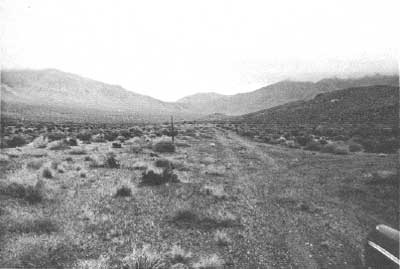 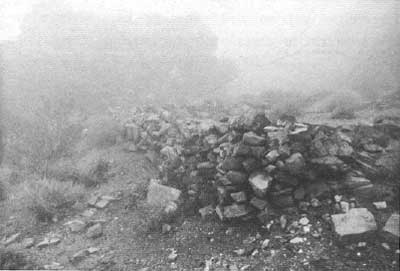
|
| Illustrations 221-222. Top: View of Gold Valley townsite, looking northwest towards the road leading into Willow Creek. The pole in the center marks the approximate center of the old townsite. Bottom: One of the larger stone foundations at the old Willow Creek townsite, which supported a tent and frame business in days gone by. 1978 photos by John Latschar. |
b. Rhodes Springs
1. History
Even farther to the south of Greenwater was another of its subsidiary mining areas, loosely known as Rhodes Springs. In this area, approximately twenty miles south of Greenwater, and over thirty miles by road, was one of those isolated Death Valley mines which had been discovered in the late nineteenth century and was reopened under the impetus of the mining booms which swept the Death Valley region in the early 1900s.

|
| Illustration 223. Map of Northcentral portion of Confidence Hills area. |
The first notice of Rhodes Springs was in 1886, when the Mining & Scientific Press reported that A. G. Rhodes and his partner had located some good prospects in southeast Death Valley. The mine which the two men had discovered was several miles from the spring itself--which was named by Rhodes. Due to the total lack of transportation facilities in the entire region in that time period, Rhodes was forced to haul supplies into his mine all the way from Daggett, California, and to haul his ore back out across the same forbidding desert. Nevertheless, Rhodes did bring 1,200 pounds of silver ore into Daggett in May of 1886, which netted him almost $800. Despite this absymally small return for a large investment of labor and time, Rhodes declared that he would return to his mine after the hot weather of summer had passed. But on the return trip both Rhodes and several prospective purchasers of his mine were lost, and were presumed to have perished in the desert.
The mine was rediscovered in December of 1905 by three prospectors who were wandering far afield in south Death Valley, looking for potential unstaked ground. The three men reported finding Rhodes' original location notices, which were still legible, as well as an old trail leading to the mine, and an old windlass and a wooden bucket. The dump of the old mine, in addition, contained about two tons of silver ore, which the prospectors claimed was very valuable. Late in December, the re-locators of Rhodes' mine brought in a mining engineer, who examined the dump and recommended that the mine be reopened.
As usual, the discovery led to a number of other prospectors coming into the area, but this time not much was found. It was September of 1906 before any more valuable ground was located in the area, and during the following month several other mines were opened. The activity, although not very extensive, was enough to make the Mining World call Rhodes Springs a camp, and by the end of 1906, about five mines were being opened up by various groups of men. J. Irving Crowell, a Rhyolite investor, led the pack with the incorporation of the Bonanza Greenwater Copper Company, which had smatterings of copper, silver, lead and gold on its property in the vicinity of the springs.
Operations in this vicinity were never very impressive, but were carried out on a shoe-string basis for several years. One of the more promising locations in the district was bonded for $100,000 in May of 1907, and the Bonanza Greenwater Company had enough ore to start sacking it the following month. That ore would be shipped, according to the Bullfrog Miner, as soon as a wagon road into the mine was finished. Since this area was closer to the railroad line than was Greenwater, transportation costs were not quite so prohibitive, and the Bonanza Greenwater estimated that the total cost of mining and freighting its ore would be about $28 per ton. Since they estimated their high-grade ore at around $100 per ton, a good profit could be made on their deposits. Work was eased by the fact that the ore being mined was all exposed on the edge of a dyke, which made the operation a strip mine-type affair.
The Bonanza Greenwater had twelve men working on stripping its ore in mid-June, and Irving Crowell, its owner, predicted that the amount of ore which could be simply dug off the top of the ground was worth $100,000. To back up his statement, he made a twenty-ton shipment of the ore to a smelter in Salt Lake City late in June. The ore returned just over $90 per ton, which after deducting $20 per ton for freight and shipping, left Crowell with $1,400 to pay for his supplies, labor and profit. Crowell's success, although marginal, was enough to inspire other prospectors to scour the area for similar deposits, and the Bullfrog Miner reported in late June that "All the ground has been located for miles and then one or top of another in desperate attempts to get as near the discovery as possible."
Although not many people found similar deposits, one group of prospectors felt that they had enough promising ground to form the Copper Basin Mining Company in September of 1907. But that effort was shortly proven futile, and the company folded after little more than a month's operation. In the meantime, the Bonanza Greenwater Company continued to mine its ore through the rest of 1907, and towards the end of the year reported that the access road to its mine had been completed at a reported cost of $6,000. With the new road easing the transportation difficulties considerably, said Crowell, his company would soon become a regular shipper of ore.
After that bold declaration, however, Crowell and the Bonanza Greenwater Copper Mining Company disappeared from view forever. Although we have no way of knowing for certain, it would appear that one more mining company had felt the effects of the decline of the Greenwater area boom, as well as the Panic of 1907. Probably, Crowell had stripped off all the easily-mined ore from the surface in his first shipment, and soon found that costs of supplies and transportation, as well as the lack of investor confidence, made it impossible to purchase the necessary tools and equipment to start underground mining.
In March of 1908 another strike was made in the vicinity of Rhodes Springs by three prospectors named Thomas McMurry, W. P. Graham and Lewis Rice. Again, the initial discovery was rather sensational, with bunches of ore on the surface which assayed $25,000 per ton in gold. The strike caused the usual sensation, and other prospectors converged on the area, but within two months it was proved to everyone's satisfaction that the men had merely made a lucky discovery of an isolated high-grade pocket of ore. Unfortunately, there was considerably less than one ton of the extremely rich stuff. After one group of miners ran a tunnel 100 feet into the side of the mountain and another sunk a shaft about seventy feet deep, everyone gave up and left the district. Rhodes Springs and its vicinity, which had seen the effects of a very outer ripple of the tremendous splash caused by the Greenwater boom, never amounted to much, and was soon deserted except for the faint footsteps of an occasional prospector who came back to make sure that the hidden bonanza had not been overlooked. [25]
2. Present Status, Evaluation and Recommendations
The Rhodes Springs area today bears absolutely no trace of these brief and minor efforts to mine the surrounding hills--which is not at all surprising considering the limited time and effort which went into those mines. Instead, the site bears the marks of much later development, including a nondescript miner's shack which has been built and added on to between the 1930s and the 1960s and the ruins of a small milling effort. These were originally built by a miner who worked a small claim in the hills during the 1930s, and erected the buildings which are still visible. Based upon the remaining evidence, the mill at this site was a cone-crushing type, and was not used for very long, for there is little evidence of tailings in the area. There is a substantial concrete water holding tank built above the mill, which is all that is still intact today. Below the small mill site, which is built on the side of a little hill, extensive collections of wood and metal debris can be found. Between the mill and the living shack are ruins of several more sheds, including a pump-house, all dating from the post-depression era. All in all, this site can best be summed up as a small-scale effort by a one or two man team, which never amounted to much. None of the remains possess historical or architectural significance. After historical archaeological clearance, the site should be cleaned up. Any artifacts useful for interpretation should be collected, leaving the concrete and wooden ruins of the little mill to the efforts of time.
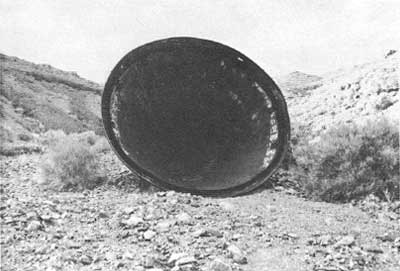 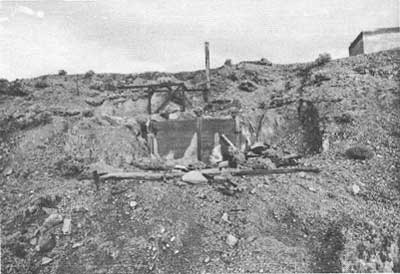
|
| Illustrations 224-225. Top: Ruins of the main cone-crushing element of the Rhodes Springs mill, which measures eight feet in diameter. Bottom: The ruins of the mill foundations at Rhodes Sprigns, with the water tank in the upper right corner of the photo. 1978 photos by John Latschar. |
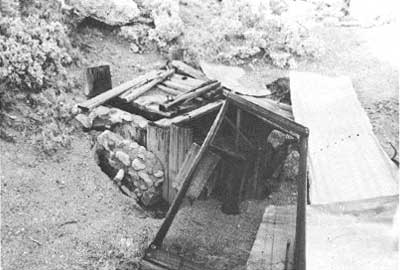 
|
| Illustrations 226-227. Top: Ruins of the pump-house at the Rhodes Springs camp. Bottom: The living shack at Rhodes Springs, with numerous signs on the door predicting death and disaster to anyone who enters. 1978 photos by John Latschar. |
c. Virgin Springs
1. History
An even smaller and still less important mining effort took place in the confines of Virgin Spring Canyon during the early 1900s. Like Willow Creek and Rhodes Springs, the discovery of ore in Virgin Springs Canyon was a direct offshoot of the Greenwater boom. When a lonely prospector found surface croppings of 30 percent copper in the area in the fall of 1906, the South Furnace Creek Copper Company was soon organized, with a capitalization of $1,250,000. Stock was put on sale for 25¢ per share, and due more to the name of the company than to any knowledge of its property, enough shares were sold for mining to start. The company owned nine claims, and towards the end of 1905 had employed six miners to start a shaft on one of them. The work was disappointing, however, and after a brief life of two months, the mine was abandoned and the company folded.
The Virgin Spring area was not molested again until the spring of 1908, when another short-lived strike was m ado. This time, gold was discovered, as a result of the little gold boom in nearby Willow Creek. Before the flurry died down, several claims had been optioned for a reported $60,000. Like the earlier strike, however, this one soon proved worthless, and the mine was quickly abandoned. [26]
The Virgin Spring area has been deserted ever since, with the exception of a small milling operation which was connected with the Desert Hound Mine, which will be discussed later.
2. Present Status, Evaluation and Recommendations
There are, however, some historic structures in Virgin Spring canyon, which are a result of one of the two short-lived strikes in the area. On the west side of the wash which travels down the center of the canyon, about one mile north of Virgin Spring, stand the ruins of four stone structures and one tent site, which were used as living quarters, probably by the employees of the South Furnace Creek Copper Company.
Several of these stone buildings are only ten to twelve feet in length, with walls which have crumbled down to only two feet in height. The fourth, however, is much more imposing, being some twelve by twenty feet in size, with well-laid stone walls six feet high--probably near their original height. This structure is built into the side of a large rock, which has protected it from the elements, and is complete with a doorway, a wooden window frame, and a large stone chimney. Although the site is very interesting, and gives a good picture of isolated living in a Death Valley mining camp, it does not warrant nomination to the National Register. It does deserve being left intact, but that should not be difficult, since it is extremely doubtful that many will ever visit the site. The access road has been completely washed out for years, and will probably never be replaced. The site can only be found by someone with patience, a strong four-wheel drive vehicle, and a knowledge of its precise location. The mining around the area was not important enough to warrant interpretation, either on the site or elsewhere.
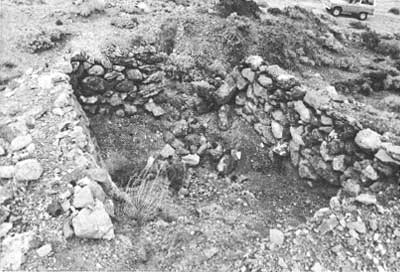 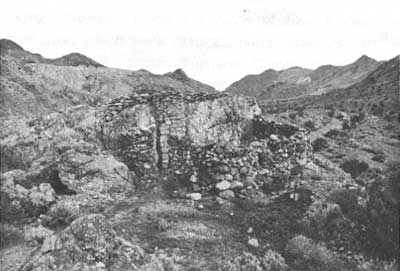
|
| Illustrations 228-229. Top: One of the smaller stone ruins at the Virgin Spring Camp site. Bottom: The larger ruin, showing the doorway in the front, window at the right and chimney at the left. This is one of the largest stone structure ruins within Death Valley, but it is completely inaccessible. 1978 photos by John Latschar. |
5. Miscellaneous Black Mountain Properties
Scattered around the southern portion of the Black Mountains on the east side of lower Death Valley are several properties which cannot be logically grouped or discussed as part of any mining district or time period. As such, they are lumped together here and presented for what they are--isolated examples of several more attempts by lone individuals or small groups to wrest wealth from the forbidding terrain of Death Valley.
a. Desert Hound Mine
1. History
The Desert Hound Mine was first discovered in the late summer of 1906, when the Engineering & Mining Journal reported that E. M. Wilkens and Burt Sides had located it high on the summit of the Black Mountains, overlooking Death Valley. The mine was perhaps the most isolated in all of Death Valley, particularly when transportation time to the nearest points of settlement were considered, for the only way in or out was via a five-mile hiker either from Virgin Spring or the Death Valley floor, The closest point of contemporary civilization, Greenwater, was over twenty airline miles and close to thirty road and trail miles away.
Nevertheless, the two men managed to sell their property to an eastern syndicate for $30,000 in cash and 75,000 shares of stock in a new company, which became known as the Keys Mining Company. The company was owned and promoted by F. D. Mellen & Company of Boston, and had sixty-five claims, with both gold and copper values. Bill Keys was the local manager and representative of the company on the ground, and the Desert Hound Mine was commonly known as the Keys Mine.
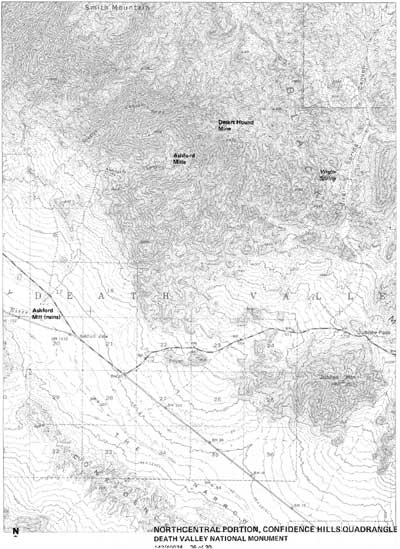
|
| Illustration 230. Map of Northcentral portion of the Confidence Hills area. |
Following its discovery, the Desert Hound Mine underwent a bewildering shift of owners, as each subsequent purchaser found out exactly bow isolated the mine really was, and how costly it would be to operate. Through it all, Bill Keys remained the only stable individual, as he served first one and then another owner as its ground representative and manager. The DuPont Powder Company, in a rare venture into mining, bought the mine from the Boston promoters in early 1907, and announced that development would start soon. DuPont, however, soon found out how expensive it would be to start developments, and as late as July 1907, still had not started work.
The next mention of the Desert Hound is in October of 1907, when Bill Brockington replaced Bill Keys as manager of the property. This time development work was started, under the direct supervision of Brockington, and by the end of October the Rhyolite Daily Bulletin reported that Brockington was ready to ship out two carloads of ore, worth an estimated $20,000. Six men were employed at the mine at this time, and development work continued through the rest of 1907. Late that year, by which time a tunnel had been run in 120 feet and a shaft sunk to seventy feet, a gold strike was reported, but no more shipments were made. Sometime in the fall of 1907, DuPont leased the mine back to a group of Boston promoters, although it took the local newspapers several months to catch up on that change.
In February of 1908, the Inyo Independent reported that Brockington was working eight men on the property. Two assayers had been brought in from Boston, and a complete assaying outfit had been installed at the mine, including a furnace which weighed 600 pounds. Work was necessarily slow, due to the extreme isolation of the mine, but by the end of April, the Rhyolite Herald reported that the miners were beginning to sack high-grade ore for shipment. The Bullfrog Miner reported several weeks later that the assay testing done by the Boston experts had been successful, and the company was planning a big development campaign.
Following that report, however, no more news was heard from the mine until December of 1908, when Brockington told the Rhyolite Herald that the mine "is destined to become the greatest producer in California." A party of Boston promoters of the Key Gold Mining & Milling Company had arrived in Death Valley for a visit to the mine, and reports indicated that the visitors were so pleased with its prospects that they planned to install an aerial tramway near the mire to take the ore down to a proposed mill site.
In January of 1909, the Rhyolite Daily Bulletin reported that a wagon road was being built from Death Valley Junction to the property, in order to facilitate the planned improvements, and the Bullfrog Miner confirmed later that month that plans were being made to construct a small mill on the property. Water was scarce in the vicinity, however, and the fact that the mine was located in an almost inaccessible place made such plans difficult in the extreme to carry out.
Nevertheless, work continued at the Desert Hound, and the Rhyolite Daily Bulletin reported in February that a second mine had been opened at the camp, which was "rapidly coming again to the front." The Rhyolite Herald reported considerable development later that month, with the mine holding an abundance of ore between $80 and $100 per ton. A mill would be required to mine it profitably, however, due to the costs and difficulties or transportation. Little more is heard from the property in 1909. The Bullfrog Miner reported in May that a good force of men were working, and the Rhyolite Herald mentioned in September that between ten and fifteen men were working on a crosscut tunnel and a drift.
No further word was heard from the mine for a year and a half, until April of 1911, when the Rhyolite Herald reported that the Key Gold Mining Company was running a 1,300-foot tunnel to tap its vein, and had recently shipped forty tons of ore to the Needles, California, smelter, worth about $310 per ton. Highlighting the difficulties of the mine, the Herald stated that $60 ore was often dumped out at the mine, since it did not pay to ship to the smelter. Following that report, the Desert Hound was not heard from for another year, until the Inyo Register reported in February of 1912 that the DuPong Powder people were working at the mine. That, however, was the last mention of the mine for quite some time.
After twenty-some years of idleness, the Desert Hound was again reopened in the 1930s, as a small one-man operation. This enterprising miner blazed a pair of nice hiking trails between his property and Virgin Spring Canyon, where a small milling operation was set up at the spring. Judging from the ruins of that mill site, which consists of no more than a small tailings dump and a small concrete engine mount, the milling operation was neither long-lasting nor particularly successful. Sometime in the late 1930s, the mine was finally abandoned for good. [27]
2. Present Status, Evaluation and Recommendations
The Desert Hound is one of the most isolated mines in all of Death Valley, for the only access to the site is either via a relatively pleasant tour-mile hike from the Virgin Spring trailhead, or a rough two-mile hike up from Ashford Mine, on the west side of the mountains. To complicate matters, the Virgin Spring trailhead can only be reached by a determined driver of a four-wheel drive vehicle who knows precisely where he is going, and Ashford Mine can only be reached via a steep one mile hike up Ashford Canyon from the point where the access road is washed out. In other words, not many people will want (or be able) to take the effort to visit the Desert Hound Mine.
Nor should they. The Desert Hound is the most unsightly place in Death Valley. It can best be described as a large garbage pit. Anyone who has lingering doubts about the romanticism of depression-era mining, on a one-man scale, will be totally absolved of such delusions by a visit to the Desert Hound.
The complex consists of several different sites, strung out along the access trail. At the farthest western side, on a ridge overlooking the Ashford Mine and Death Valley, is a former tent community, consisting of nine tent sites and a twelve by twelve stone shelter, with some walls remaining This community was undoubtedly the home of the 1907-1909 era miners. The only remnants of their occupation are the tell-tall rectangular placed stones, which were once used. to keep their tents from blowing off the ridge into Death Valley. One quarter of a mile to the east is the main mine site, which was worked both in the early 1900s and again in the 1930s. The marks of the earlier occupation are mostly obscured by the 1903s era junk, although two tent platform sites are still discernable. In addition, a jumble of rusted and stripped machinery lies in the bottom of a small defile below the mine site, probably the ruins of the 600-pound assaying furnace hauled in during 1908.
Other than that, the rest of this site has been totally demolished by its later occupants. The third Desert Hound site, located about one half miles east of the mine, along the access trail, consists merely of the faint outlines of stone retaining walls around two tent sites.
In summary, there is nothing of particular historic significance at the Desert Hound, although it may yield historical archaeological values. The site dies not warrant interpretation, and should be left in its disorderly state. Due to its remote location, it is extremely doubtful that more than one or two hardy souls will find the site each year.
The mill site at Virgin Spring associated with the 1930s mining at the Desert Hound is neither large nor impressive Total remains there consist of a. small concrete engine mount and an eroded pile of tailings. Whatever milling machinery was used there has long since disappeared, and the site has no particular significance.
 
|
| Illustrations 231-232. Top: View of the tent sites west of the Desert Hound Mine. The two people in the center and far center of the photo mark the first and last tent sites, which are barely discernable even on the ground. Bottom: The main Desert Hound Mine site, showing a small portion of the junk accumlated by the its last resident. 1978 phots by John Latschar. |
b. Ashford Mine and Mill
1. History
In January of 1907, Harold Ashford wandered into the Death Valley region, and attracted by the gold strikes at the Desert Hound Mine, prospected in that vicinity. Within a few months, he discovered that the Keys Gold Mining Company had failed to do the required assessment work on several of its claims, and Ashford relocated them and started to work on his own. It took the Keys Gold Mining Company almost two years to discover that someone else was working their former claims, and when Ashford refused to vacate, the company took him to court In January of 1910, however, the judge found in favor of Ashford and he retained title to his claims. He might have been better off if he had lost.
Harold Ashford and his brother, Henry and Lewis, worked the mine off and on between 1910 and 1914, without spectacular results. Then, in November of 1914, the brothers managed to lease the mine to B. W. McCausland and his son, Ross. The McCauslands started to work on a large scale, and within a year had driven a tunnel 180 feet into the side of the mountain. At the height of their operation, the McCauslands had twenty-eight men employed, had invested over $125,000 in capital improvements, including machinery, trucks and labor costs, and had completed 2,000 feet of total workings. In addition, a mill had been built on the floor of Death Valley, five miles and 3,500 feet below the mine, where the ore from the mine was trucked for preliminary treating. The mill included a jaw-crusher, a ten-foot Lane mill, a Wilfley table and a Diester slime table. The McCauslands were described by the Inyo Register as being wealthy residents of Los Angeles, and in late August they announced that their forty-ton capacity mill was in operation, and they had plans to increase its capacity to 150 tons.
But despite taking out an estimated $100,000 worth of ore, the McCauslands soon discovered that the ores from the mine were not rich enough to justify all this capital expenditure, and they ceased operations in September of 1915. In order to cut their losses, the McCauslands decided not to pay the Ashfords for the year's lease on the mine. The Ashfords took them to court, but never got their money back.
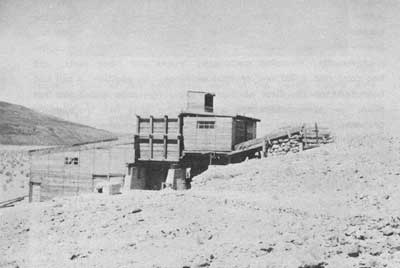
|
| Illustration 233. The Ashford Mill, built in late 1914 or early 1915. This photo was marked as being taken in 1942. If the date is correct, then the mill was in remarkable shape at the time, since it was never again used after the McCauslands abandoned their efforts in late 1915. Photo by an unknown photographer, from a box marked "new prints," Death Valley National Monument Library. |
Following this fiasco, the mine and mill were idle for some years, until 1926, when it was reported that four men were working. The total footage of workings at the mine, however, had not increased since 1917, which indicates that they were not working very hard. Neither did they work very long, for the mine was soon closed down again. Another long period of idleness followed, until 1935, when the Ashfords once again leased their mine, this time to the Golden Treasure Mines, Inc. That company reopened the mine, and since the old mill was inadequate to treat its ores, shipped their rock out to Shoshone where it was loaded upon the Tonopah & Tidewater Railroad. The long truck hauls, however, proved very expensive, and after searching for other ways to reduce costs, the company settled down to taking out only the highest grade of ore available. Work on the mine by the Golden Treasure company lasted until sometime in 1938, when they gave up. Total shipments by the Golden Treasure company amounted to no more than $18,000 over a period of two years.
Following the departure of their lessees, the Ashfords began working on their mine again, and in August of 1938 made a 38-ton shipment. By this time the mine was described as comprising twenty-six claims, and had a 320-foot shaft with a crosscut, a 215-foot tunnel, and a 200-foot drift. Equipment at the site included a portable Ingersoll-Rand compressor and various camp buildings. Three men were working, probably the three Ashford brothers.
After working the mine themselves for a short period, the Ashford's leased it again, this time to the Bernard Granville and Associates of Los Angeles. That company immediately went to work, employing ten men, and soon installed a short aerial tramway, to facilitate the task of consolidating the ore from the scattered shafts and tunnels to one central point for trucking down the mountain. Operations continued until sometime in 1941, when the new lessees gave up. No record of any shipments being made by Granville and Associates can be found.
The Ashfords continued to hold title to their mine following the departure of their last lessees, although they apparently never returned to work it themselves. In perhaps the best summary of the spotted history of the Ashford Mine, C. B. Glasscock wrote that it was able to produce just enough gold to keep the Ashfords in groceries and lawsuits for more than a third of a century. [28]
2. Present Status, Evaluation and Recommendations
Structures at the Ashford Mine are numerous, although not many of them could be classified as historic. The main mine site itself is situated high on the west side of the Black Mountains, overlooking Death Valley, and the old road to the site has been washed out for many years. Access today is only possible via an arduous hike about one mile from the end of the road up to the mine site. Structures at the main complex consist of one collapsed shack, an outhouse, a large office and cookhouse building, two wooden bunkhouses, a tin shed, a headframe and ore bin, and the tramway towers and terminal. All of these structures date from the 1930-1940 period of mining. Although they present a good picture of a small mining community during that period, they are not of National Register significance, due to their late date and relative lack of contribution to the history of the locale.
Just around the knoll from the main mining site--towards the east--are the ruins of an older mining effort, undoubtedly the remnants of the McCausland's work in the 1910s. Here may be found several older adits and dumps, the ruins of a collapsed shack and half a dozen level sites, the former homes of a small tent community. This site has better integrity than the former, since it was relatively undisturbed in later mining years, but still does not possess historic significance. Benign neglect is recommended for these mine sites, both of which possess potential historical archaeological values.
The ruins of Ashford Mill stand on the floor of Death Valley. Structures here consist of the crumbling walls of a concrete office building, and the ruins of the mill itself. Not much is left of the mill, with the exception of the large concrete foundations and a very limited amount of debris. The ruins of the mill foundation and the office building are rather interesting, and according to local legend, are due to the fact that a double load of cement was shipped to the McCauslands when construction was in progress. Rather than send it back, which would have entrailed further transportation expenses, the extra cement was used in construction of the mill and office building, which largely accounts for their still standing today.
The Ashford Mill is a popular tourist stop, as it stands lust adjacent to the main south Death Valley road. There is a large interpretive sign at the mill, which is substantially incorrect, since it relates a romantic tale of foreign princes and huge sums of money. As none of that is true, it would behoove the Monument staff to replace the sign with a more factual--if boring--account of the mill. Other than that, the only recommendation for the Ashford Mill site is one of benign neglect, for it does not possess National Register significance.
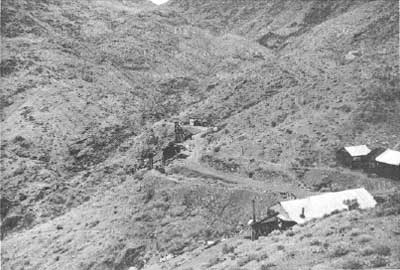 
|
| Illustrations 234-235. Top: The Ashford Mine, showing the complex used in the 1930s. The cookhouse and office is in the foreground, the bunkhouses are to the right, with the headframe, collapsed tramway terminal and a shed visible in the rear. Bottom: View of the upper Ashford Mine complex, where the 1910s mining efforts of the McCauslands took place. 1978 photos by John Latschar. |
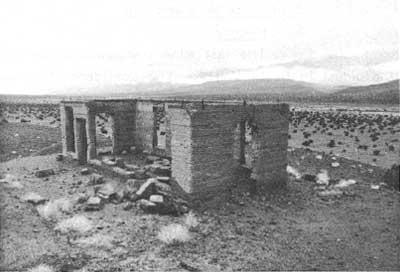 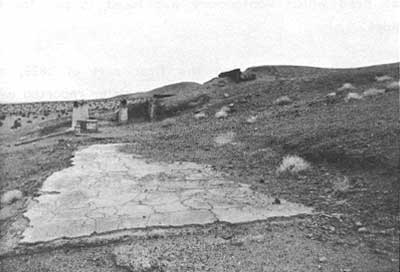
|
| Illustrations 236-237. Top: The office building at the Ashford Mill site. Bottom: Ruins of the foundations of the Ashford Mill. 1978 photos by John Latschar. |
c. Confidence Mine and Mill
1. History
The last mine discussed in the chapter is one of the oldest in Death Valley. The Confidence Mine was first discovered sometime around the early 1890s by an Indian woman named Mary Scott, who thought it was a silver mine and neglected it. In 1895, Mary relocated the mine on a grubstake from Frank Cole and Jimmy Ashdown. When samples showed high gold content, Cole and Ashdown sold the mine to George Montgomery for $36,000. In November of 1895, the Inyo Register reported that Montgomery was in town buying mules to use to haul freight and supplies over 100 miles from Daggett, California, to the mine, which had just begun operations. The mine, said the paper, had opened up some fine looking gold ore, running from $15 to $75 per ton, and due to the transportation difficulties, a 30-ton Bryan mill was being built seven miles below the mine, on the floor of Death Valley. The mill engine would run on gasoline, since it was far cheaper to haul in gas than was the effort to collect wood. Mining expenses in the isolated and little-known region were not helped by the price of $100 per head which Montgomery was forced to pay for fourteen large mules.
During the first part of 1896, the new mine was worked vigorously. The Inyo Register reported early that year that the Confidence Mining Company was operating the mine and mill, with the backing of financiers from Salt Lake City, particularly John Q. Cannon. The mill was under construction, and was expected to be completed soon, and a full force of miners and millmen had been hired, although no accommodations had been provided for them. That was not too bad, said the Register, since "as it seldom rains," everyone merely camped in the open air. The Confidence, said the paper, was one of" the most difficult and expensive mines to work in the country, owing to the scarcity of fuel and water principally, but freighting from Daggett [is] equally as arduous a task."
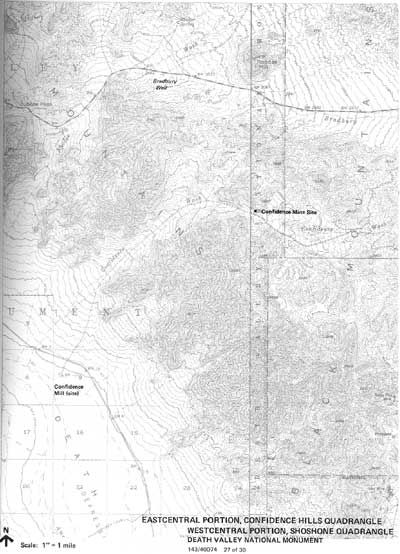
|
| Illustration 238. Map of Eastcentral portion of the Confidence Hills Area and Westcentral portion of the Shoshone Area. |
Due more to its uniquely isolated location in unexplored Death Valley than to its size or importance, the Confidence Mine also received attention from a national mining journal. The Mining & Scientific Press, in January of 1896, reported that the mine had three shafts and a tunnel, with the deepest shaft being about 125 feet. The mill would be ready to run by February 1st. Later that month, the Inyo Register reported that the mill was started up and was running well, and twenty-five men were employed by the company.
In May of 1896, the Inyo Register again reported on the mine, with some detail. It had been purchased in partnership by Cannon, Montgomery and a man named Langford, all of whom were also operating mines around Johnnie and Chispa, Nevada. It had two shafts of 150 feet each, connected by a drift. A well had been dug near the mill, from which a China pump raised "about the saltiest water on earth" from a depth of eighty feet. In order to reduce the water for the mill, it was necessary to first pass it through a condenser. The mill consisted of a rock breaker, a Bryan roller mill with a capacity of twenty tons per day, and a few feet of silvered copper plates. Power was supplied by a 20-horsepower gas engine.
Costly as these provisions were, said the report, they were not nearly sophisticated enough to reduce the rebellious ore to buillion, and consequently the mill had been shut down after only a few months of operation. A fairly large tailing pile indicated that a sizeable amount of ore had been run through the mill in its three-month life, before its owners realized their errors. Indeed, the mill had proved so inefficient that local prospectors claimed they could make $5 per day by panning the mill tailings. The company did not even have assaying equipment at the mine or mill, and in short, said the Inyo Register, "one wonders how they can have any idea of "where they are at" in the mining and milling business."
Supplies were hauled into the mine from Daggett, but when the reporter visited the mill in early May, no superintendent or paymaster had been there since January. Twenty men had quit on April 4th, and scattered across the desert to find one of the mine's owners to demand their pay. "The company must have expended forty to fifty thousand dollars in a mill that will [have] to be extensively added to or removed entirely before they can ever get a dollar out of it."
This story of inefficient and bumbling management caught the attention of the Mining & Scientific Press, which reprinted it in its entirity, with the following introduction: "In vast southeastern Inyo there are mines and mining operations which few residents know anything about. And in that region of mountains and deserts it is difficult to describe locations, no existing map showing anything about them. It is also hard to describe some of the mismanagement in their attempts to get money out of the mines."
The Inyo Independent reported in ate July of 1896 that the Confidence Mine and Mill was still closed down, with "no pay day in sight." The mill still stood in Death Valley, but the owners had not been back to it, and "it looks like the result of bad management." In October, the paper again reported that the "Salt Lake company owning the Confidence mine and mill on the east side of Death Valley in the Amargosa mountains have not resumed operations, neither has it paid a dollar of numerous debts.
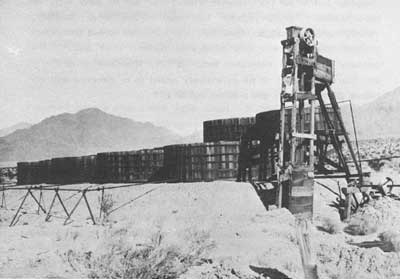
|
| Illustration 239. The Confidence Mill, from a photo taken in 1909. The caption reads "Confidence Cyanide Plant, has stood 15 years on the desert." From "Niter Lands of California," Death Valley National Monument Library, Neg #3090. |
The mine remained closed in early 1897, and in February of that year Montogmery sold his half interest in it to Cannon for $81,000--indicating that Cannon, at least, still believed that there was gold in the ground. Two months later, one L. F. J. Wrinkle was reported to have offered Cannon and his associates $100,000 for the mine, plus one fifth of the non-assessable capital stock in a new mining company, and a guarantee that $100,000 worth of work would be done at the property. The Inyo Register, in an understatement, commented that "The figures now offered, considering the isolated location of the property, indicate that a bonanza is believed to exist there."
But that sale came to naught, and the mine and mill lay idle. Further speculation concerning the Confidence property surfaced in 1898, when the Inyo Independent reported a rumor that the Meneva Mining and Milling Company was about to buy the mine from Cannon. Cannon apparently thought so also, for be took the precaution of patenting his claims, but again the deal was not consummated.
Not much was heard from the mine or its owners for the next several years. In 1901, the property changed hands, although it stayed within the Cannon family, and in 1904 the Confidence Mine was listed on the Inyo County delinquent tax rolls, for failure to pay $6.06 in taxes on the patented property. Again a veil of silence fell around the mine, which was not lifted until May of 1907, when the Death Valley Chuck-Walla during an assessment of mining possibilities in that part of the country, mentioned the old Confidence Mine, which had long been idle. With "the renewal of activity in the district in other sections and the opening of new mines," speculated the Chuck-Walla "work will again commence on the Confidence." Later that fall, the Rhyolite Daily Bulletin also mentioned the idle Confidence Mine as one with possibilities, since it had smelting-quality ores.
But despite the optimism of those two mining camp newspapers, the mine was not reopened, even though the Salt Lake organization retained control and title to it. Finally, in May of 1909, the long awaited resumption of work began. The Bullfrog Miner reported that month that the Confidence Mine "which has been idle for several years, has again started work with a good force of men. The development is being backed by Salt Lake Capitalists and unless the extremely hot weather prohibits, will continue during the summer."
The new lessees of the property, the Death Valley Gold Mining Company, worked only sporadically during the summer, due to the intense heat in that portion of Death Valley, but in September operations were stepped up. The Rhyolite Herald reported that W. J. West, the new manager, had taken five sacks of ore from the mine into Salt Lake City for milling tests. The ore was averaging $50 per ton, and the company had three shafts working, down to twenty, seventy and 150 feet, respectively. Apparently the old mill, which was still standing, was deemed inadequate to reduce the ores--not surprising, since it had been inadequate in 1896--and the company was making plans to erect a new mill. As usual, the Rhyolite Herald concluded that the lack of an adequate water supply was the main problem facing the company.
Two weeks later, the Rhyolite Herald confirmed that operations had been resumed on the old Confidence. One Mr. Merritt, who seemed to be heading up the organization, told the paper that he would bring in machinery to the property "as soon as he can conveniently get around to it," and that "if the old Confidence will only do half as well as in the pioneer days it will be all that he will ask." Meanwhile, the men at the mine were sacking the high grade gold ore. The Mining World also confirmed in September that the Death Valley Gold Mining Company was planning to erect a mill in Death Valley, as soon as the Salt Lake ore tests could determine the kind of mill required. The mine, it reported, had a sufficiently large tonnage of ore blocked out to justify the expense of constructing a mill.
One month later, in mid-October, the Rhyolite Herald reported that the Confidence Mine was just completing a shipment to the smelter in Salt Lake City. The ore was regarded as fairly high grade, assaying between $60 and $150 per ton. But after that report, the mine fell idle once again. Apparently the ore tests in Salt Lake City had shown that the ore was too low grade or too hard to process to make its extraction from an extremely isolated corner of Death Valley profitable. In June of 1910, and again in 1911, the property of the Confidence Mining Company appeared on the Inyo County delinquent tax rolls, for the want of $14.11 in county taxes.
Unfortunately, at about this Lime a great desert legend was born, when W. C. Mendenhal I, writing for the Geologic Survey, confused this Confidence Mine with the old "lost" Mormon mine from which the Mormons were traditionally believed to have taken much gold in the 1850s. Mendenhall's mistake, due to the prestige of USGS publications, has been habitually repeated throughout the years, until the truth is hard to separate from the fiction. There is absolutely no evidence that the Confidence Mine in Death Valley is the lost Mormon mine, and there is much evidence to the contrary. The contemporary descriptions of the mine in 1895 and 1896 make absolutely no reference to the Mormons, and indicate quite strongly that Montgomery and his partners were the first men to operate it. Such legends, however, are hard to kill.
In the meantime, R. J. Fairbanks, the enterprising merchant from Greenwater and Shoshone, bought the Confidence Mine and operated it on his own for three years. The difficulties which beset him, as well as previous owners, are best put in his own words.
This was a gold proposition, and in spite of the fact there's gold in there that will run $35,000 to the ton, I operated entirely at a loss. Most of the ore would run about eight dollars to the ton, and I'd have to crack hundreds of tons of the eight-dollar ore trying to get a few pounds of the $35,000 stuff. The financial failure of this venture was due entirely to the utter impossibility of the transportation problem. Everything had to be wagoned in and out from the railroad at Shoshone, and the haul more than ate up the profits After Fairbanks gave up, the Inyo Register printed a rumor in July of 1915 that "It is now practically assured that a new management will soon open" the Confidence Mine. However, that rumor was false, as were those printed by the Mining World in March of 1915. At that time, it was believed that the Corona Mining and Milling Company planned to reopen the mine, and to construct a 100-ton stamp mill on the property. The Mining World went on to repeat the silly tale connecting the Confidence with the lost Mormon mine, and then improved upon that by also stating that the Confidence was the secret source of Death Valley Scotty's wealth. About the only truth to its entire report was the statement that the "workings are in bad shape and have every appearance of having been ruthlessly looted."
Needles to say, the Corona Mining and Milling Company never reopened the Confidence Mine, and it lay idle for several more years. A traveler to the area in 1921 saw no evidence of mining anywhere in the area, and although several desert rats did move into Confidence Wash in the latter years of the 1920s, none of them worked the Confidence Mine. In 1926 the California State Mineralogist reported that the mine was idle and had been for several years, and that the mill had been dismantled. Sometime around 1934, the mine was again operated very briefly, and a small amount of high-grade ore was packed out and shipped to a smelter.
Then, in the fall of 1941, an exhaustive examination of the mine was made on the behalf of some Salt Lake City investors who had become interested in the mine. The inspection of the property showed around 740,000 tons of ore blocked out in previous development work, with an average value of $14 per ton. Although some high-grade ore worth $125 per ton could be found, most of that had already been stripped out by previous operators. Water was available about one and a half miles from the mine, and the examiner believed that enough water could be developed to support a mill. Considerable stoping had already been done by previous miners, as well as the driving of two tunnels, one about 175 feet into the mountainside, and the other about 375 feet. Previous production, according to this report, was claimed to be about $200,000, most of it in the early days of the mine. "If sufficient capital can be secured," wrote the Journal a mill would be built and the property would be brought back into production.
But such was not the case, probably due to the combination of lack of capital and the isolation of the mine, which would have made mining very expensive even in 1941. In any event, mining of gold was forbidden the following year, due to war-time demands, and following the failure of this last effort, the old Confidence Mine was at last left alone. [29]
2. Present Status, Evaluation and Recommendations
Not much remains to mark the efforts of so many people over so many years to exploit an isolated Death Valley mine. At the mine site, approximately six miles up Confidence Wash from the mill, some ruins may be seen. These consist of two prospect holes in the side of the wash, used for living and storage areas by later occupants of the site, and a series of adits and shafts which climb far up the side of the mountain. The main mining complex, towards the top of a very steep ridge, has several stained out areas, and a faint foot path leading from one adit to another. The complex is centered around the ruins of an old ore bin, which was once connected to a crude bucket tramway to lower the ore down to the floor of the wash. Some tramway rails, a crude rocker box, and other paraphernalia from the last periods of mining may be found. Evidence of earlier occupants has been destroyed long ago by later miners.
For several miles up and down Confidence Wash in this area, other traces of very small-scale mining attempts may be found, mostly dating from the Depression years, when numerous down-and-out individuals resorted to living rent-fee in the wilds of Death Valley. The home of one such occupant, fondly known as the "Wind Cave," is located a short distance up the wash from the mine, but it has absolutely no historical significance. All in all, the ruins in Confidence Wash are impressive, but only in the sense of making the viewer wonder what desperate hopes could have led men to believe that they could get rich from this forsaken territory.
The mining area of Confidence Wash is not historically important enough to warrant National Register consideration. Although the lack of access to the site at present denies its interpretive potential, benign neglect is recommended. The area should not be reclimed, cleaned up or naturalized, but rather left to the elements, and left for the enjoyment of what few back country hikers may stumble upon its remains.
Down in Death Valley is the site of the old mill. Not much remains here either, for years of wind and occasional cloudbursts have combined to almost cover the mill site. The mill machinery has long been hauled away for other uses, and the most visible sign of the old mill is a raised earth platform with a thin and crumbling cement floor in the middle. Piles of assorted concrete bits and remains of tanks and pipes are scattered around the area at the whim of the elements, and the old well, where once the saltiest water on earth was found, is almost completely filled with sand.
The Confidence Mill has significance due to its age, but the almost complete destruction of the site by the hands of men and the weather has destroyed its integrity. It will not be nominated to the National Register, but is recommended for historical archaeological study. The location of the mill site also negates its interpretive potential, since the lower east side road has been closed to protect the fragile environment of the rare pup fish at Saratoga Springs. Benign neglect is recommended for the mill site, along with a strong recommendation against any attempts to clean up, reclaim or naturalize the area.
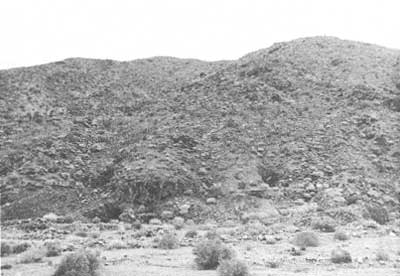 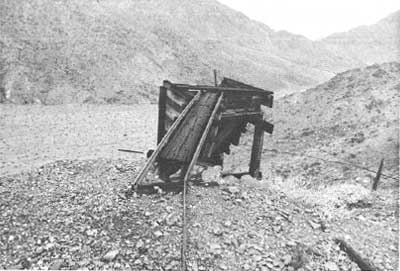
|
| Illustrations 240-241. Top: The old Confidence Mine site, showing several adits just above the floor of the wash. The old ore bin, which marks the center of the main mining complex, can barely be seen in the top center of the photo, just below the ridge line. Bottom: The ore bin, from which a crude bucket tramway once descended to the floor of the wash below. 1978 photos by John Latschar. |

|
| Illustration 242. Ruins of the Confidence Mill, on the floor of Death Valley. The thin concrete slab and the engine mount are the only substantial remains of the old mill. 1978 photo by John Latschar. |
d. Bradbury Well
Bradbury Well, located along the Salsberry Pass road opposite Rhodes Springs, was first located and named in the late 1910s or early 1920s. The well is mentioned as a good watering place in 1921, and again in 1922, when Margaret Long described taking off the boards which covered the top of the well, and pulling up a bucket of water. Other than those brief mentions, the well has never been referred to in connection with the early history of Death Valley. [30]
The well site today is still easy to find, due to the tell-tale vegetation which clearly marks every source of water in Death Valley. The well, however, has been filled with sand by the winds of the desert, and only the circle of stones which once marked its site to desert travelers is now visible. The site has no historic significance or interpretive potential, and is recommended for benign neglect.

|
| Illustration 243. Bradbury Well, looking north towards the Salsberry Pass road. 1978 photo by John Latschar. |
| <<< Previous | <<< Contents >>> | Next >>> |
deva/hrs/section4c.htm
Last Updated: 22-Dec-2003